D Link WR961C1 Wireless AC1200 4G LTE Router User Manual DWR 961 D1 Manual v0 01
D-Link Corporation Wireless AC1200 4G LTE Router DWR 961 D1 Manual v0 01
D Link >
Contents
- 1. User Manual-1
- 2. User Manual-2
- 3. User Manual
User Manual
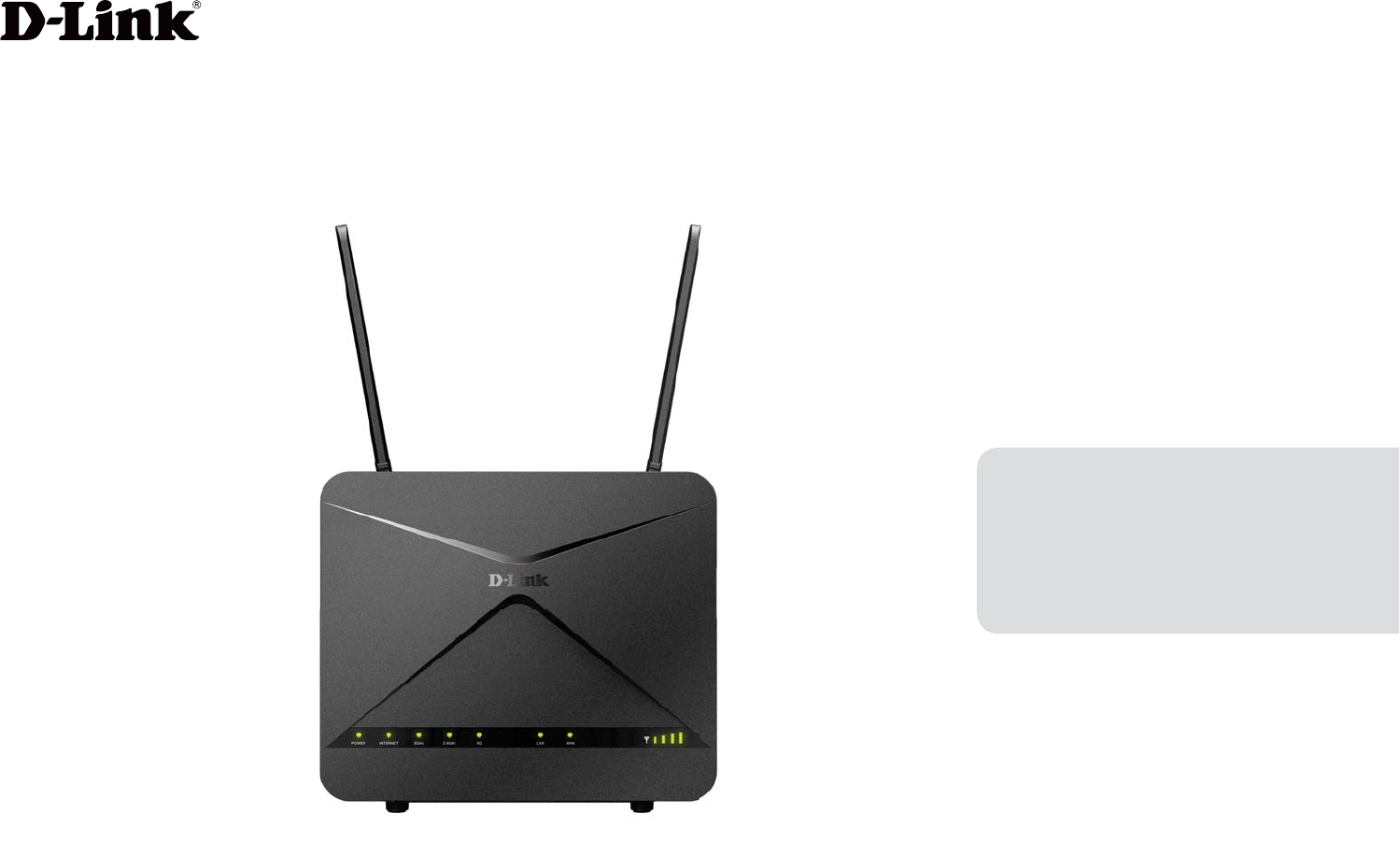
Version .0 | 09//201
User Manual
DWR-9
(-5&3PVUFS
8JSFMFTT"$

1D-Link DWR-9 User Manual
Section 1 - Product Overview
Product Overview
Package Contents
If any of the above items are missing, please contact your reseller.
System Requirements
* Subject to services and service terms available from your carrier.
• A compatible SIM/UICC card with service.*
• Computer with Windows 10/8/7/Vista/XP, Mac OS 10.3 or above, or Linux-based operating
system with a compatible network adapter.
• Java-enabled browser such as Internet Explorer 9, Safari 7, Chrome 28, or Firefox 23 or above
(for conguration).
Power Adapter
DWR-9 8JSFMFTT"$4G LTE Router
4G Antennas
RJ-45 Cable

2D-Link DWR-9 User Manual
Section 1 - Product Overview
Introduction
D-Link’s DWR-9 4G LTE Router allows you to access mobile broadband networks from anywhere. Once connected, you
can check e-mail, surf the web, and stream media. Use your carrier’s SIM/UICC card to share your 4G Internet connection
through a secure wireless network or by using any of the four 10/100 Ethernet ports.
The DWR-9 lets you connect to your 4G mobile connection with fast downlink speeds of up to 100 Mbps and
uplink speeds up to 50 Mbps, giving you the speed to ensure fast, responsive Internet access. Surf the web with ease and
stream music and video over the Internet to your PCs and mobile devices.
The DWR-9 utilizes dual-active rewalls (SPI and NAT) to prevent potential attacks across the Internet. Industry standard
WPA/WPA2 wireless encryption keeps your wireless network secure and your trac safe, allowing you to share your 4G
connection without worrying about unauthorized users accessing your network.
The DWR-9 can be installed quickly and easily almost anywhere. It can be congured through almost any web browser
without the need for special software. This router makes it possible to stay connected, even when conventional broadband
services are unavailable.

6D-Link DWR-9 User Manual
Section 2 - Installation
Wireless Installation Considerations
The DWR-9 can be accessed using a wireless connection from anywhere within the operating range of your wireless network. Keep in mind that
the quantity, thickness, and location of walls, ceilings, or other objects that the wireless signals must pass through may limit the range of the wireless
signal. Ranges vary depending on the types of materials and background RF (radio frequency) noise in your home or oce. The key to maximizing
the wireless range is to follow these basic guidelines:
1. Minimize the number of walls and ceilings between the D-Link router and other network devices. Each wall or ceiling can reduce your adapter’s
range from 3 to 90 feet (1 to 30 meters).
2. Be aware of the direct line between network devices. A wall that is 1.5 feet thick (0.5 meters), at a 45-degree angle appears to be almost 3 feet
(1 meter) thick. At a 2-degree angle it looks over 42 feet (14 meters) thick. Position devices so that the signal will travel straight through a wall
or ceiling (instead of at an angle) for better reception.
3. Try to position access points, wireless routers, and computers so that the signal passes through open doorways and drywall. Materials such as
glass, metal, brick, insulation, concrete, and water can aect wireless performance. Large objects such as sh tanks, mirrors, le cabinets, metal
doors, and aluminum studs may also have a negative eect on range.
4. If you are using 2.4 GHz cordless phones, make sure that the 2.4 GHz phone base is as far away from your wireless device as possible. The base
transmits a signal even if the phone is not in use. In some cases, cordless phones, X-10 wireless devices, and electronic equipment such as ceiling
fans, uorescent lights, and home security systems may dramatically degrade wireless connectivity.
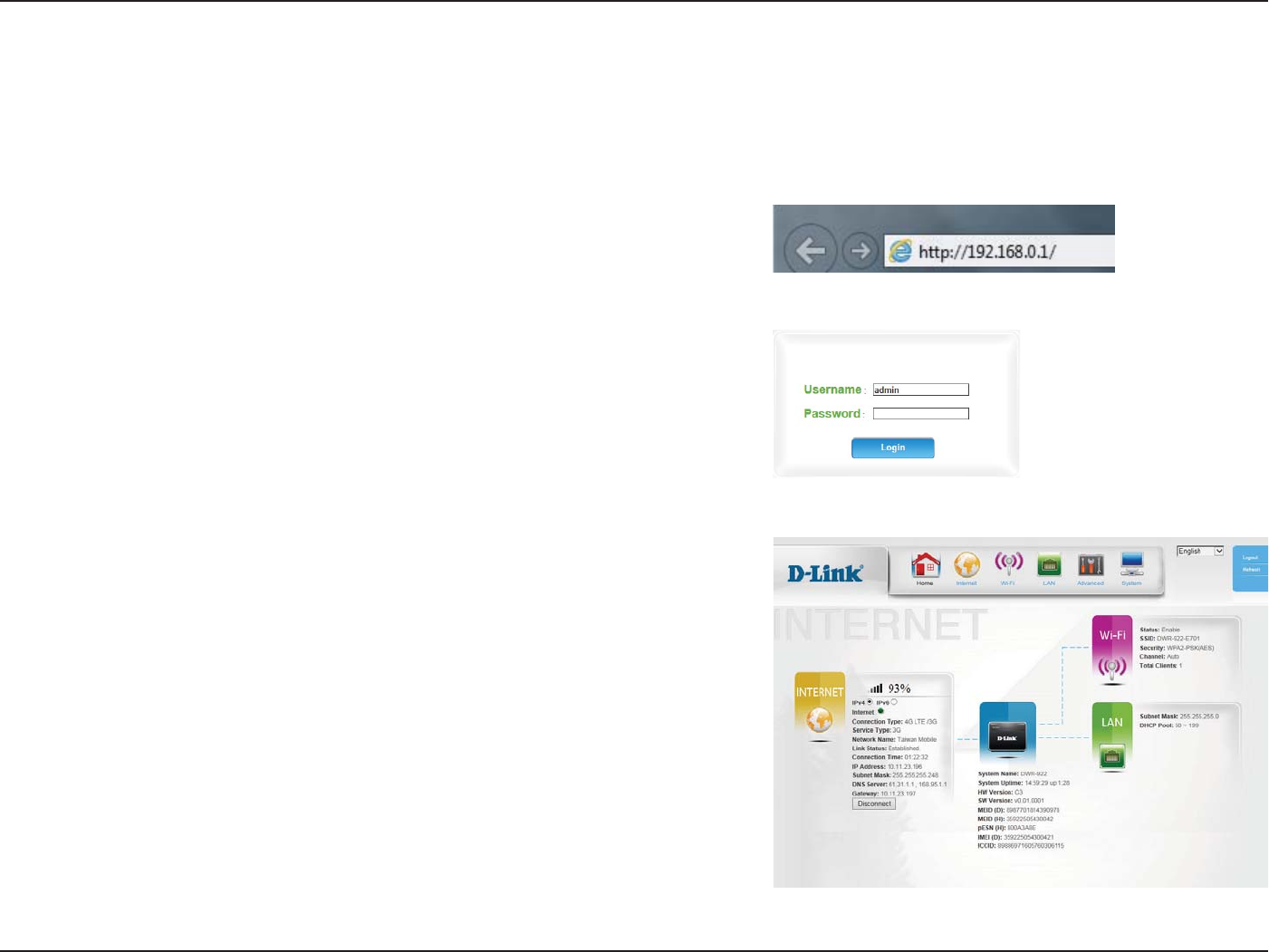
7D-Link DWR-9 User Manual
Section 4 - Conguration
Conguration
To access the conguration utility, open a web browser such as Internet Explorer and
enter the address of the router (192.168.0.1 by default).
To log in to the conguration utility, admin is the default username and the default
password is left blank.
Note: If you get a Page Cannot be Displayed error, please refer to the Troubleshooting
section for assistance.
Once you have successfully logged in, you will see the Home page. On this page
you can view information about your Internet connection, the wireless/LAN status,
and system information.
At the top of the page is a menu. Clicking on one of these icons will take you to the
appropriate conguration section.
Getting Started
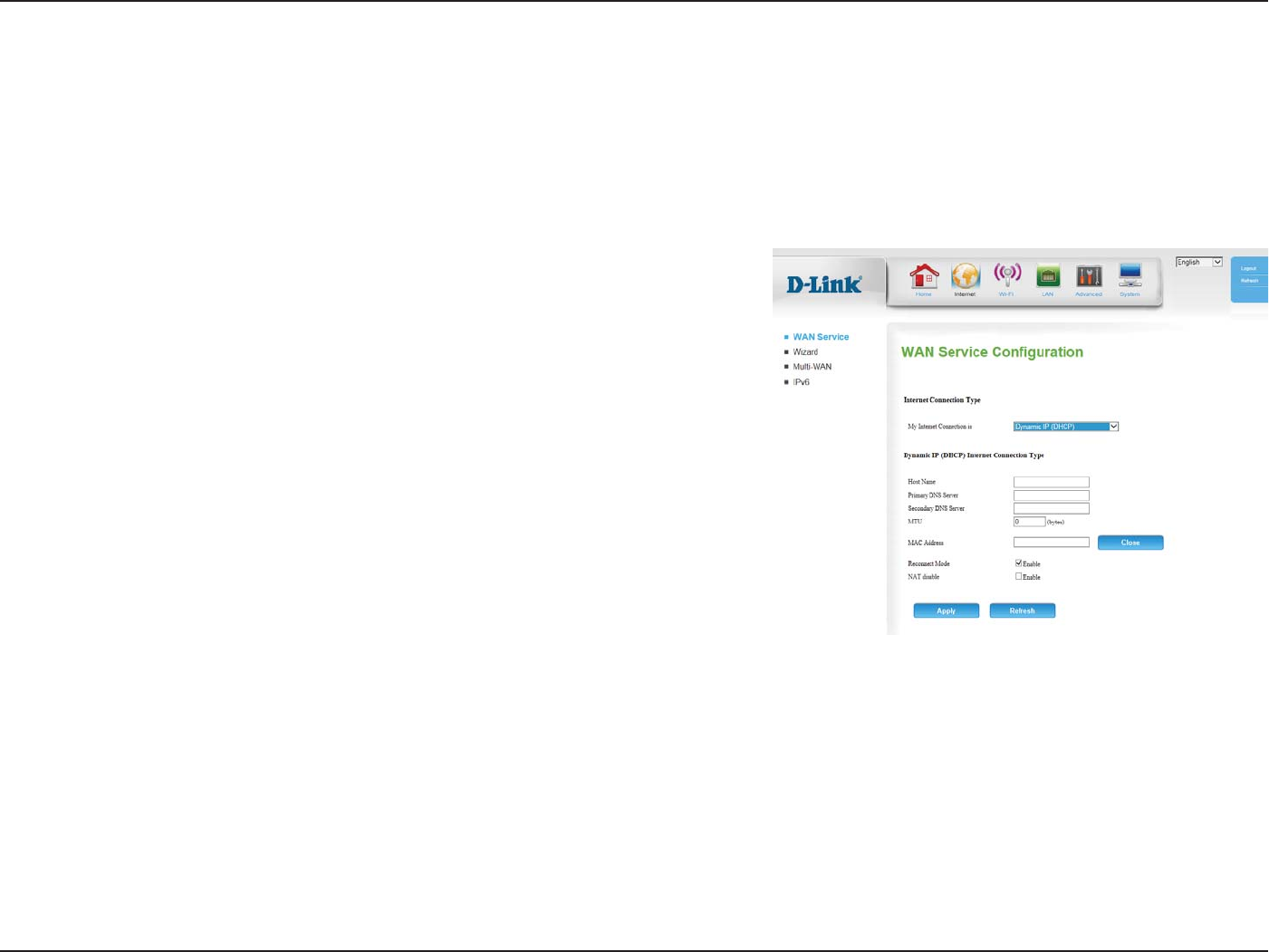
8D-Link DWR-9 User Manual
Section 4 - Conguration
Internet
Select the Internet connection type specied by your ISP. The
corresponding settings will be displayed below. Please see the
following sections for details on how to congure these dierent
connection types.
My Internet
Connection is:
WAN Service
On this page you can congure your Internet connection. If you are not sure which settings to use, please contact your Internet Service Provider
(ISP).
Dynamic IP (DHCP)
If your ISP requires you to enter a host name, enter it here. In most
cases, you may leave this blank.
(Optional) Fill in with IP address of primary DNS server.
(Optional) Fill in with IP address of secondary DNS server.
You may need to change the Maximum Transmission Unit (MTU)
for optimal performance. The default value is 0.
The default MAC address is set to the WAN port’s physical interface
MAC address on the router. It is not recommended that you
change the default MAC address unless required by your ISP. You
can use the Clone button to replace the WAN port’s MAC address
with the MAC address of your PC.
Host Name:
Primary DNS
Server:
Secondary DNS
Server:
MTU:
MAC Address:
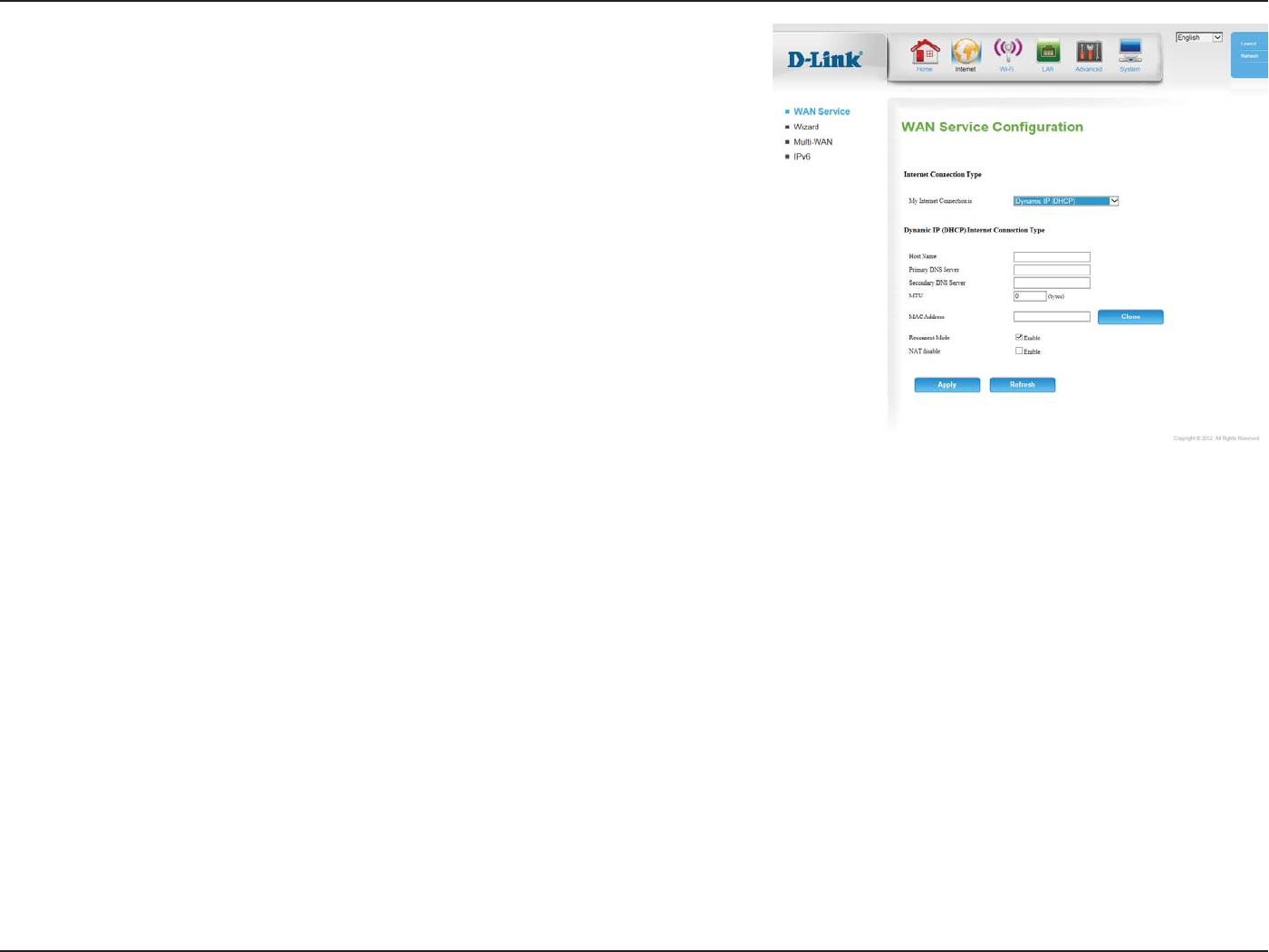
9D-Link DWR-9 User Manual
Section 4 - Conguration
This feature enables this product to renew the WAN IP address
automatically when the lease time has expired.
Enabling this option will disable the NAT rewall function of the
DWR-9, exposing all connected devices directly to the Internet.
This is an advanced feature and not recommended for normal use.
Click Apply to save your settings, or Refresh to revert to your
previous settings.
Reconnect
Mode:
NAT disable:
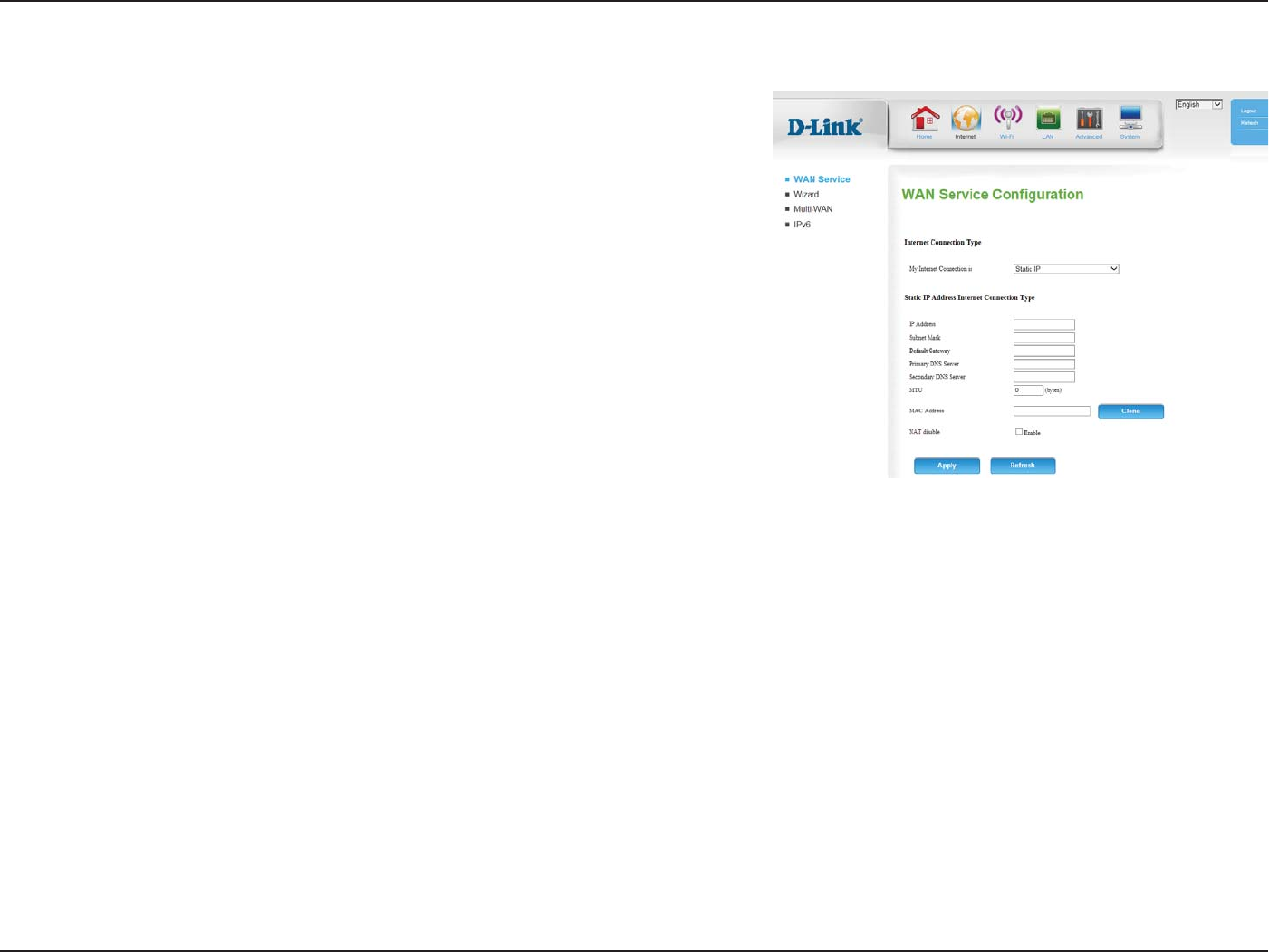
10D-Link DWR-9 User Manual
Section 4 - Conguration
Enter the IP address assigned to your network connection.
Enter the subnet mask.
Enter the default gateway.
Enter the primary DNS server.
Enter the secondary DNS server.
You may need to change the Maximum Transmission Unit (MTU)
for optimal performance. The default value is 0.
The default MAC address is set to the WAN port’s physical interface
MAC address on the router. It is not recommended that you
change the default MAC address unless required by your ISP. You
can use the Clone button to replace the WAN port’s MAC address
with the MAC address of your PC.
Enabling this option will disable the NAT rewall function of the
DWR-9, exposing all connected devices directly to the Internet.
This is an advanced feature and not recommended for normal use.
Click Apply to save your settings, or Refresh to revert to your
previous settings.
IP Address:
Subnet Mask:
Default
Gateway:
Primary DNS
Server:
Secondary DNS
Server:
MTU:
MAC Address:
NAT disable:
Static IP
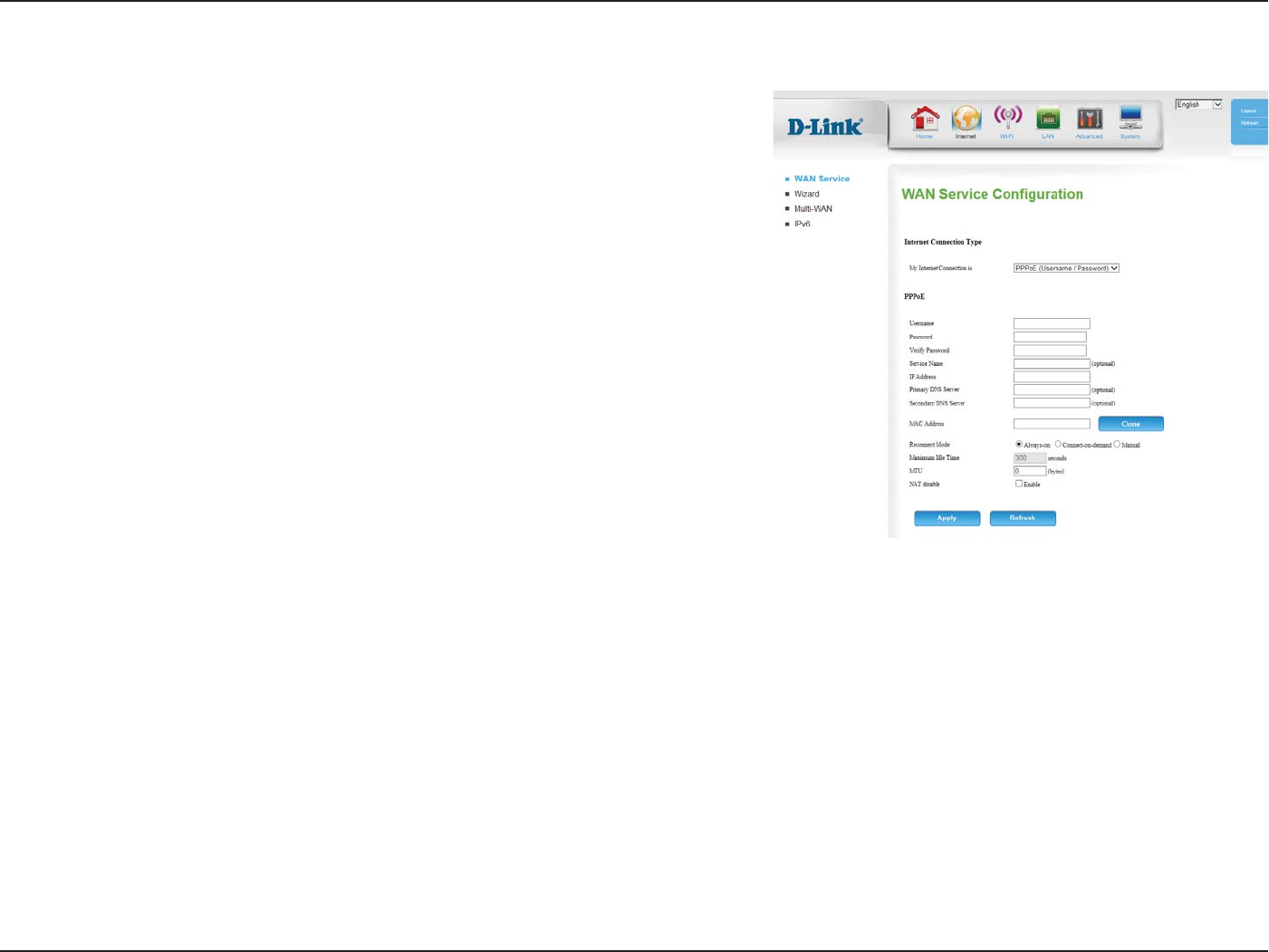
11D-Link DWR-9 User Manual
Section 4 - Conguration
The username provided by your ISP for your PPPoE account.
Password provided by your ISP for your PPPoE account.
Re-type your password in this eld.
Fill in if provided by your ISP. (Optional)
Fill in if provided by your ISP. If not, keep the default value.
Fill in if provided by your ISP. If not, keep the default value
(optional).
Fill in if provided by your ISP. If not, keep the default value
(optional).
The default MAC address is set to the WAN port’s physical interface
MAC address on the router. It is not recommended that you
change the default MAC address unless required by your ISP. You
can use the Clone button to replace the WAN port’s MAC address
with the MAC address of your PC.
The amount of time of inactivity before disconnecting an
established PPPoE session. Set it to zero or enable auto-reconnect
to disable this feature.
You may need to change the Maximum Transmission Unit (MTU)
for optimal performance. The default value is 0.
Choose Always-on when you want to establish PPTP connection
all the time. If you choose Connect-on-demand, the device will
establish a PPTP connection when local users want to connect
to the Internet, and disconnect if there is no trac after the time
period dened by the Maximum Idle Time setting.
Username:
Password:
Verify Password:
Service Name:
IP Address:
Primary DNS
Server:
Secondary DNS
Server:
MAC Address:
Maximum Idle
Time:
MTU:
Reconnect
Mode:
PPPoE (Username / Password)
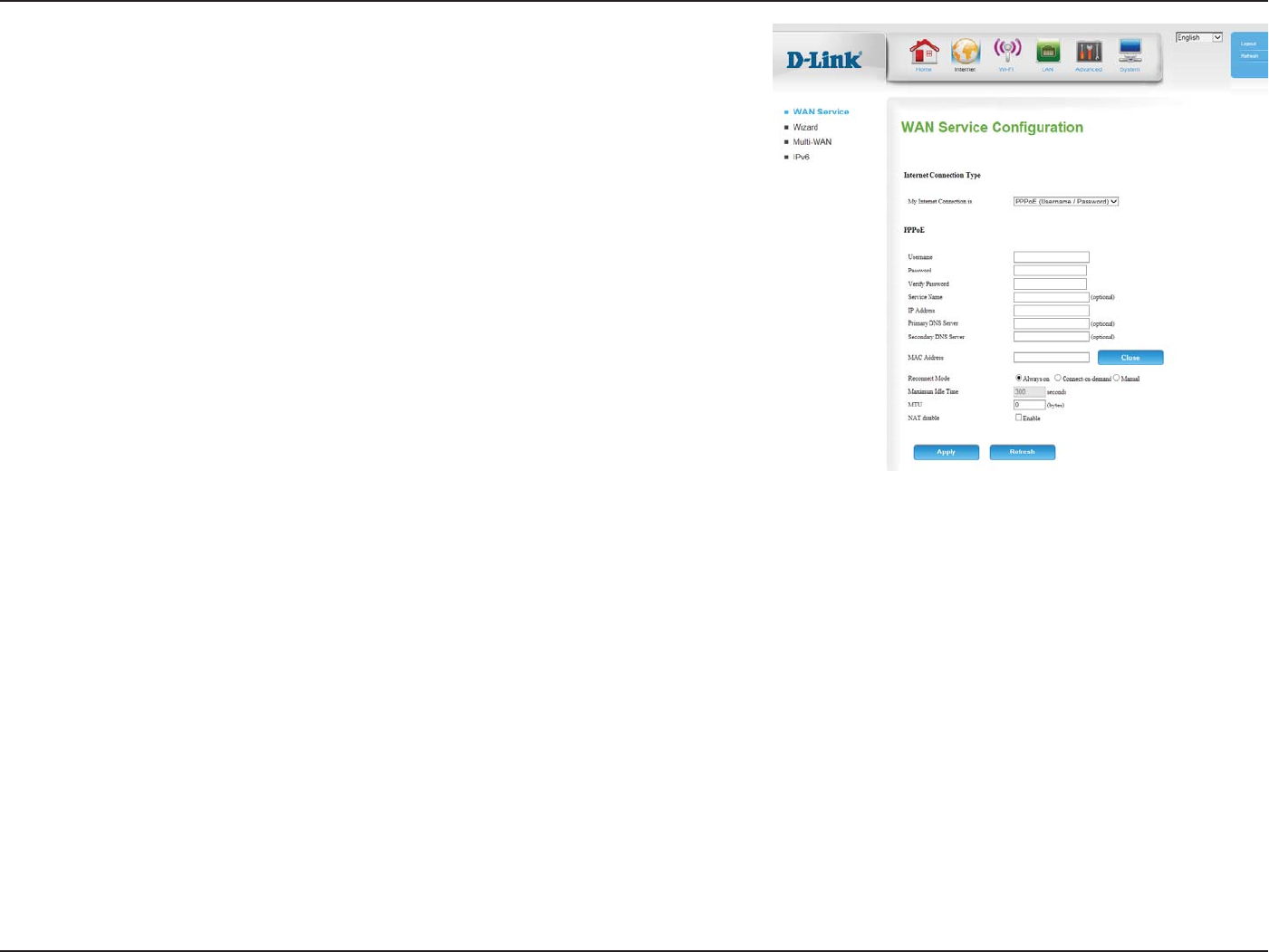
12D-Link DWR-9 User Manual
Section 4 - Conguration
NAT disable: Enabling this option will disable the NAT rewall function of the
DWR-9, exposing all connected devices directly to the Internet.
This is an advanced feature and not recommended for normal use.
Click Apply to save your settings, or Refresh to revert to your
previous settings.
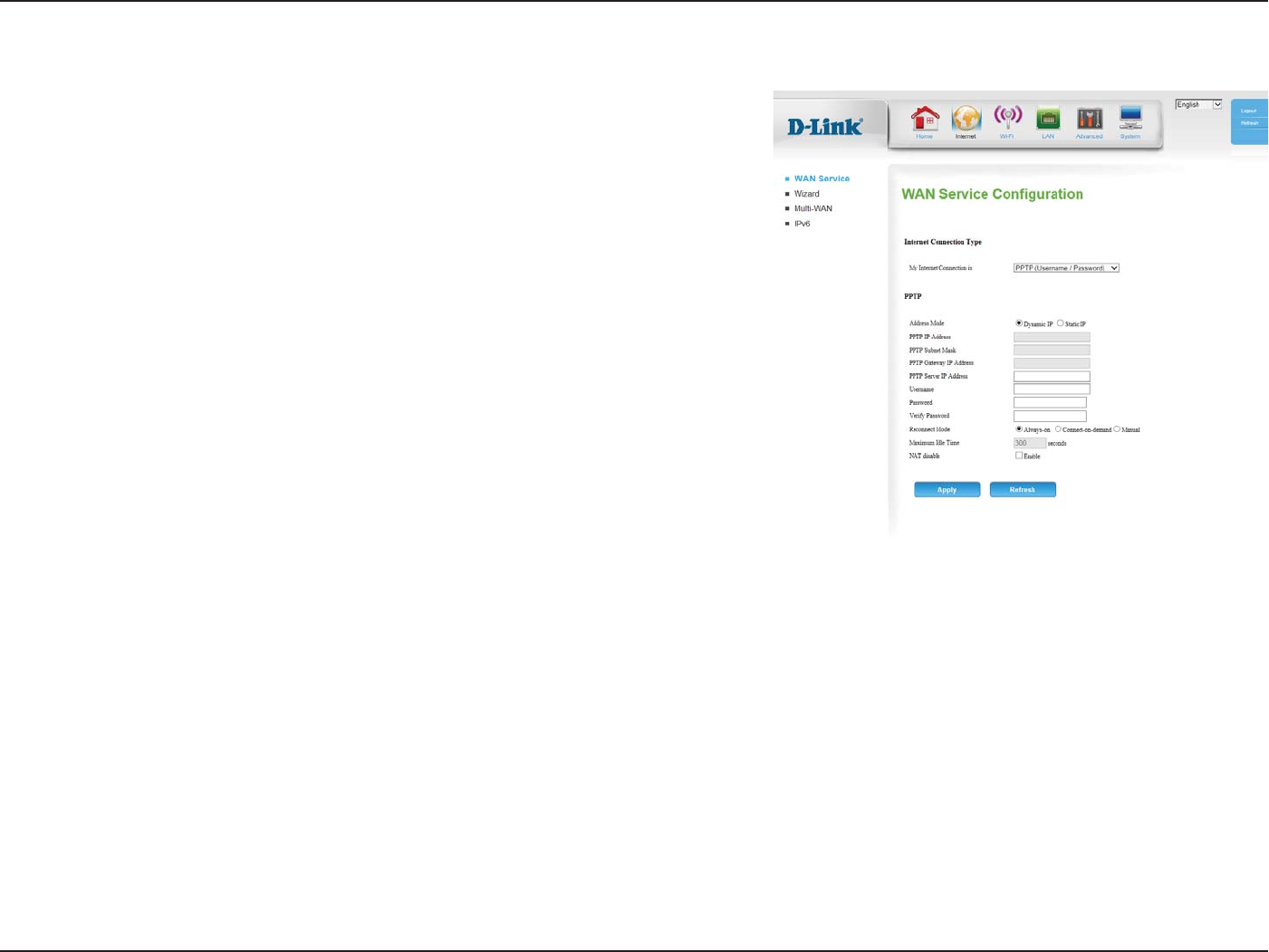
13D-Link DWR-9 User Manual
Section 4 - Conguration
Choose Static IP only if your ISP provides you with a static IP
address for PPTP. Otherwise, please choose Dynamic IP.
Enter the information provided by your ISP (Only applicable for
Static IP PPTP).
Enter the information provided by your ISP (Only applicable for
Static IP PPTP).
Enter the information provided by your ISP (Only applicable for
Static IP PPTP).
IP address of the PPTP server.
User/account name that your ISP provides to you for PPTP dial-up.
Password that your ISP provides to you for PPTP dial-up.
Re-enter your password for verication.
Choose Always-on when you want to establish PPTP connection
all the time. If you choose Connect-on-demand, the device will
establish a PPTP connection when local users want to connect
to the Internet, and disconnect if there is no trac after the time
period dened by the Maximum Idle Time setting.
The time of no activity to disconnect your PPTP session. Set it to
zero or choose Always-on to disable this feature.
Address Mode:
PPTP IP Address:
PPTP Subnet
Mask:
PPTP Gateway IP
Address:
PPTP Server IP
Address:
Username:
Password:
Verify Password:
Reconnect
Mode:
Maximum Idle
Time:
PPTP
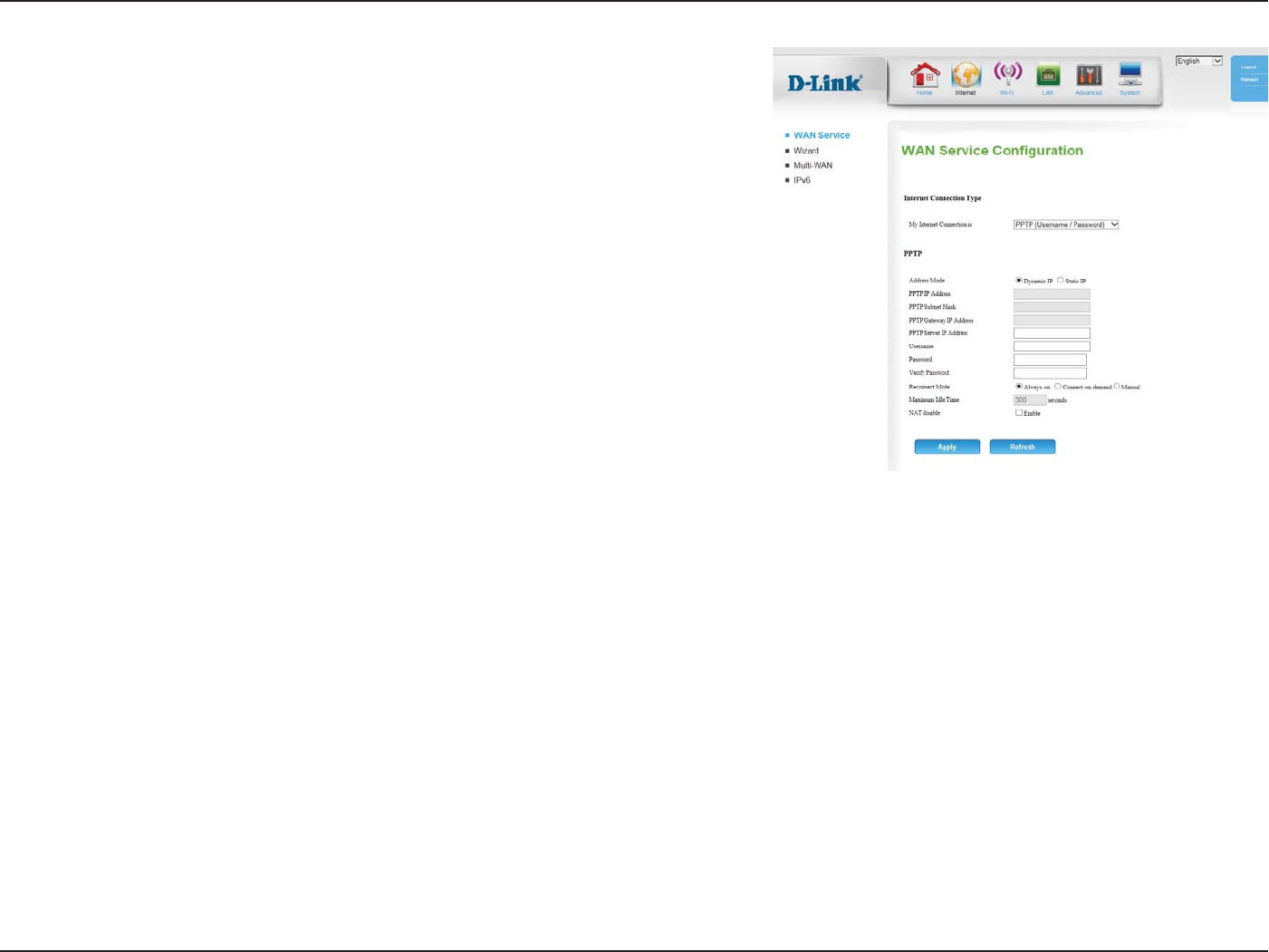
14D-Link DWR-9 User Manual
Section 4 - Conguration
Enabling this option will disable the NAT rewall function of the
DWR-9, exposing all connected devices directly to the Internet.
This is an advanced feature and not recommended for normal use.
Click Apply to save your settings, or Refresh to revert to your
previous settings.
NAT disable:
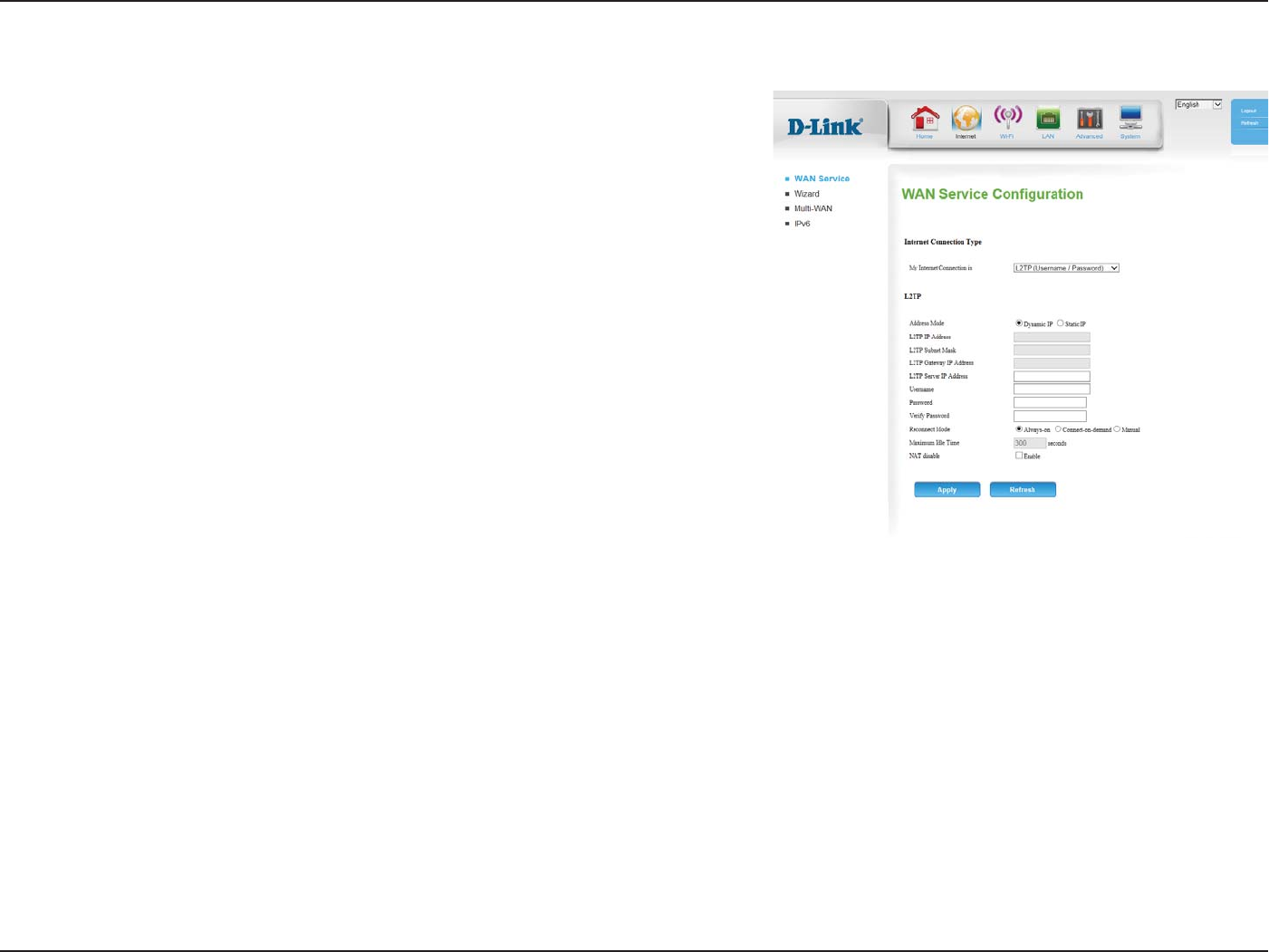
15D-Link DWR-9 User Manual
Section 4 - Conguration
Choose Static IP only if your ISP assigns you an IP address.
Otherwise, please choose Dynamic IP.
Enter the information provided by your ISP (Only applicable for
Static IP L2TP).
Enter the information provided by your ISP (Only applicable for
Static IP L2TP).
Enter the information provided by your ISP (Only applicable for
Static IP L2TP).
IP address of the L2TP server.
User/account name that your ISP provides to you for L2TP dial-up.
Password that your ISP provides to you for L2TP dial-up.
Re-type your password in this eld.
Choose Always-on when you want to establish L2TP connection
all the time. If you choose Connect-on-demand the device will
establish L2TP connection when local users want to use Internet,
and disconnect if no trac after time period of Maximum Idle
Time.
The time of no activity to disconnect your L2TP session. Set it to 0
or choose Always-on to disable this feature.
Address Mode:
L2TP IP Address:
L2TP Subnet
Mask:
L2TP Gateway IP
Address:
L2TP Server IP
Address:
Username:
Password:
Verify Password:
Reconnect
Mode:
Maximum Idle
Time:
L2TP
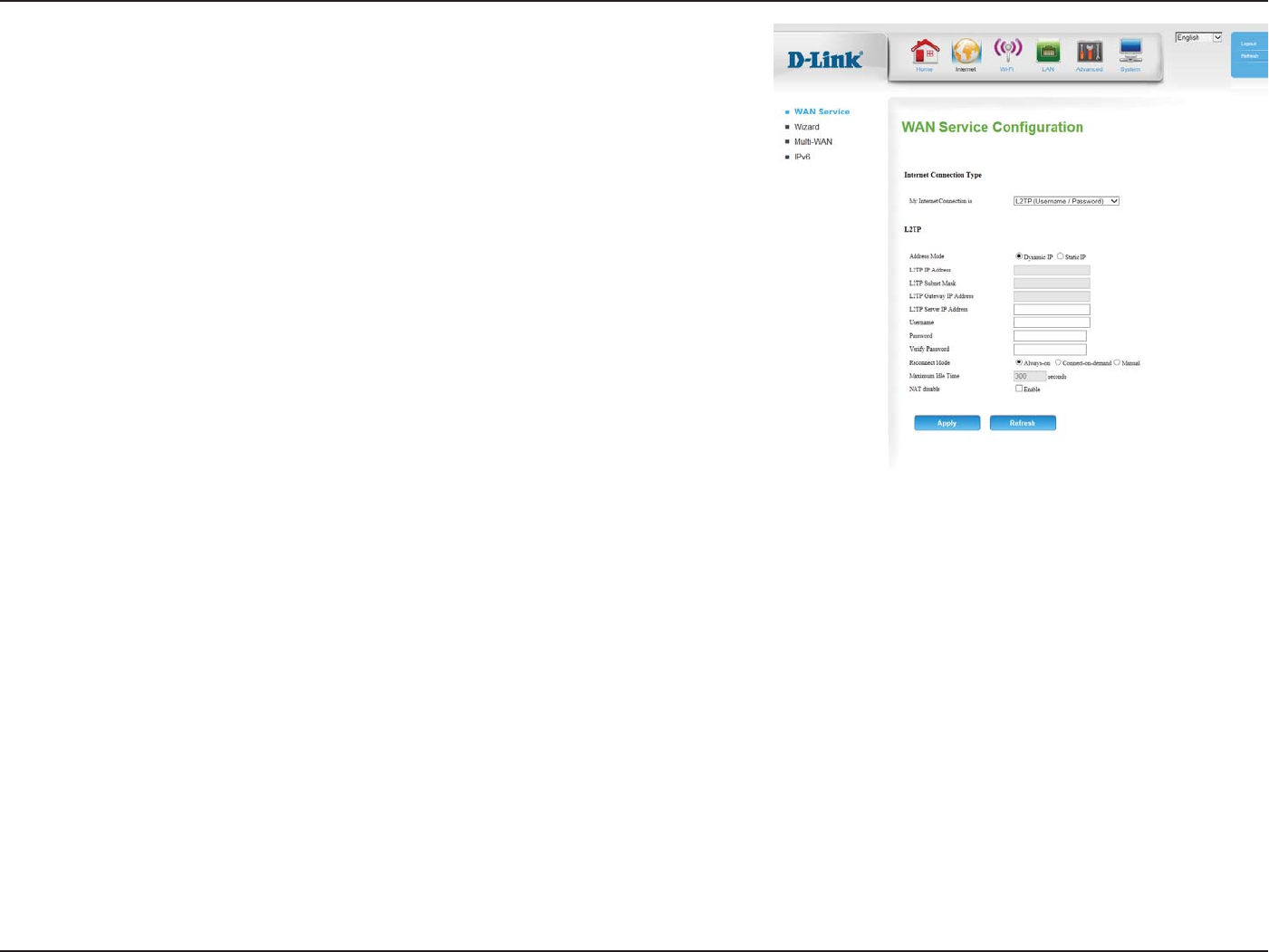
16D-Link DWR-9 User Manual
Section 4 - Conguration
Enabling this option will disable the NAT rewall function of the
DWR-9, exposing all connected devices directly to the Internet.
This is an advanced feature and not recommended for normal use.
Click Apply to save your settings, or Refresh to revert to your
previous settings.
NAT disable:
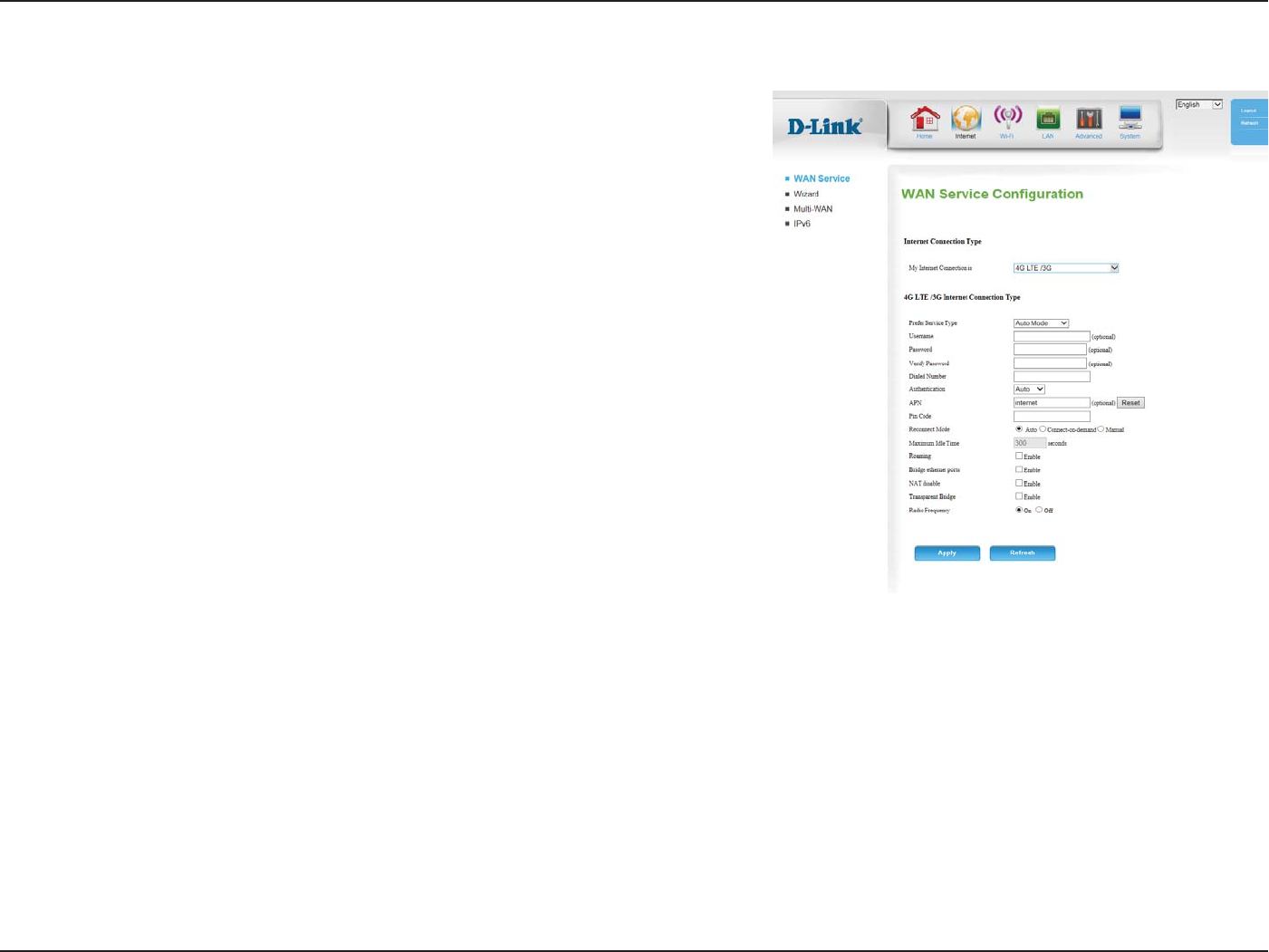
17D-Link DWR-9 User Manual
Section 4 - Conguration
Choose whether the DWR-9 should only use 4G networks,
networks, or use Auto Mode to automatically select a network.
Fill in only if requested by carrier ISP (optional).
Fill in only if requested by carrier (optional).
Re-type your password in this eld (optional).
If your carrier provides a dial-in number or code, enter it here.
Empty by default.
Select PAP, CHAP, or Auto detection. The default authentication
method is Auto.
Enter the APN information (optional).
If your SIM card has a PIN code, enter it here
Select Auto, Manual, or Connect-on-deman to determine
whether the router should reconnect to your 4G network
automatically or manually.
Set the maximum time your connection can be idle before
disconnecting. Set it to 0 or choose Auto in Reconnect Mode to
disable this feature.
Enabling this option will allow you to connect when roaming away
from your carrier’s home network.
Note: Roaming connections may incur additional fees from your
service provider.
Prefer Service
Type:
Username:
Password:
Verify Password:
Dialed Number:
Authentication:
APN:
Pin Code:
Reconnect
Mode:
Maximum Idle
Time:
Roaming:
4G LTE
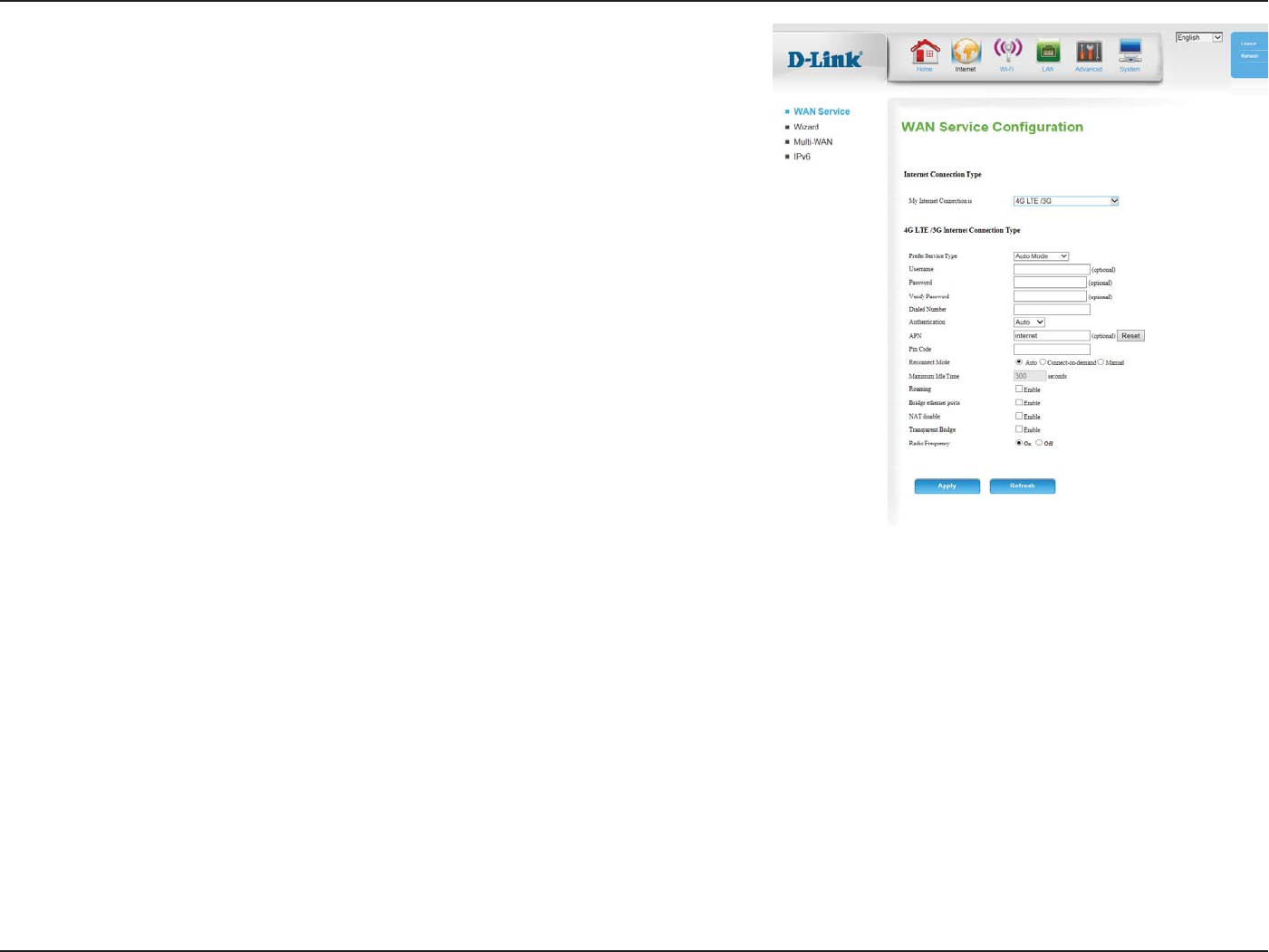
18D-Link DWR-9 User ManuBM
Section 4 - Conguration
Activate this feature to use the Ethernet WAN port as an additional
LAN port.
Enabling this option will disable the NAT function of the DWR-9,
allowing it to act as a link for your devices to your Internet
connection, but without routing functions.
Enabling the Transparent Bridge function disables the routing/
NAT functions and passes the public WAN IP address given by your
service provider directly through to the local client or PC. This can
only be used if a single IP address has been assigned by your ISP. If
transparent bridge is enabled, the above NAT Disable option will
not be available
. Turns the cellular radio on or o. This setting is intended to
disable the cellular radio for areas where radio transmissions may
be restricted.
Click Apply to save your settings, or Refresh to revert to your
previous settings.
Bridge Ethernet
Ports:
NAT disable:
Transparent
Bridge:
Radio
Frequency:
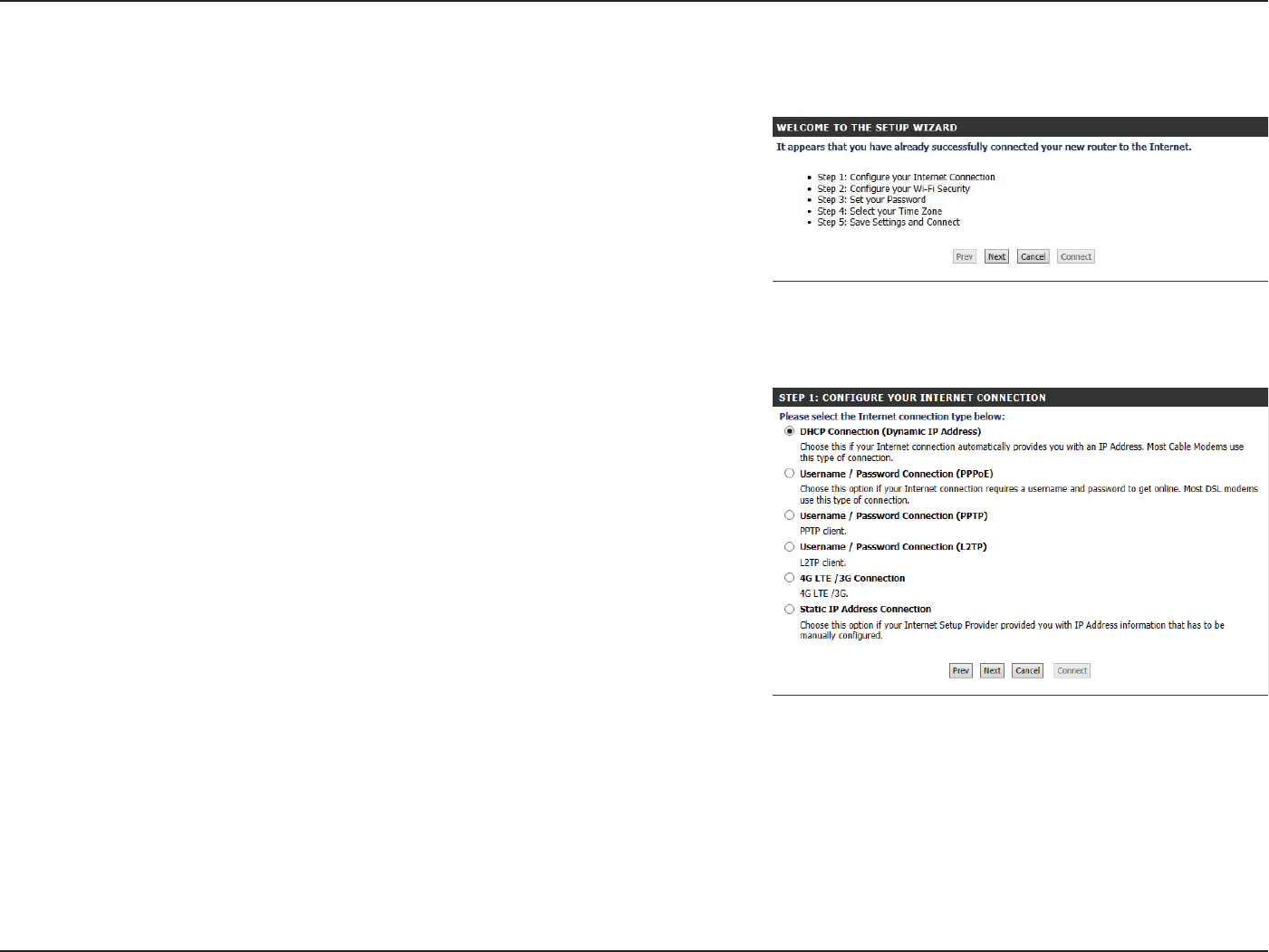
19D-Link DWR-9 User Manual
Section 4 - Conguration
Wizard
This wizard will guide you through a step-by-step process to congure your router
to connect to the Internet.
Click Next to continue.
Note: While using the wizard, you can click Prev to go back to the previous step,
or you can click Cancel to close the wizard.
Select the Internet connection type you use. The connection types are explained on
the following page. If you are unsure which connection type you should use, contact
your Internet Service Provider (ISP).
Click Prev to go back to the previous page or click Cancel to close the wizard.
Note: The DWR-9 has a Multi-WAN Failover feature that allows the router to
switch to a 4G connection if the WAN connection is down or unavailable.
To congure this feature, please refer to Multi-WAN Conguration on page
24.
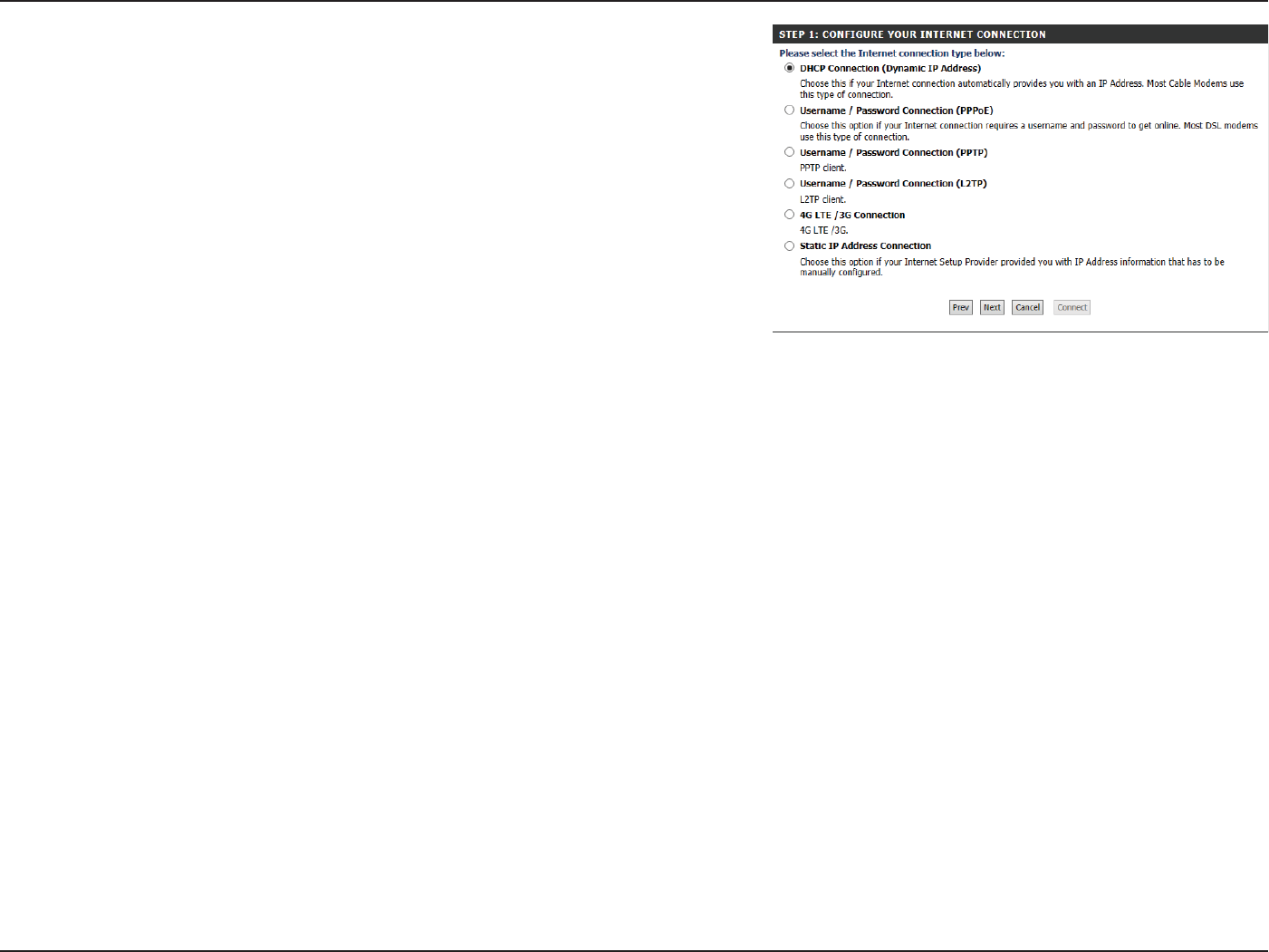
20D-Link DWR-9 User Manual
Section 4 - Conguration
Choose this if your IPS automatically provides you with an IP
address. Most cable modems use this type of connection. See
Dynamic IP (DHCP) on page 8 for information about how to
congure this type of connection.
Choose this option if your Internet connection requires a
username and password to connect. Most DSL modems use
this style of connection. See PPPoE (Username / Password) on
page 11 for information about how to congure this type of
connection.
Choose this option if your Internet connection requires Point-
to-Point Tunneling Protocol (PPTP). See PPTP on page 13 for
information about how to congure this type of connection.
Choose this option if your Internet connection requires Layer 2
Tunneling Protocol (L2TP). See L2TP on page 15 for information
about how to congure this type of connection.
Choose this connection if you have installed a SIM card into the
DWR-9. See 4G LTE on page 17 for information about
how to congure this type of connection.
Choose this option if your Internet Service Provider (ISP)
provided you with IP address information that has to be manually
congured. See Static IP on page 10 for information about how
to congure this type of connection.
DHCP Connection
(Dynamic IP
Address):
Username
/ Password
Connection
(PPPoE):
Username
/ Password
Connection (PPTP):
Username
/ Password
Connection (L2TP):
4G Connection:
Static IP Address
Connection:
The subsequent conguration pages will dier depending on the selection you
make on this page.
After entering the requested information,click Next to continue.
Note: If you are not sure what connection type to use or what settings
to enter, check with your Internet Service Provider (ISP).
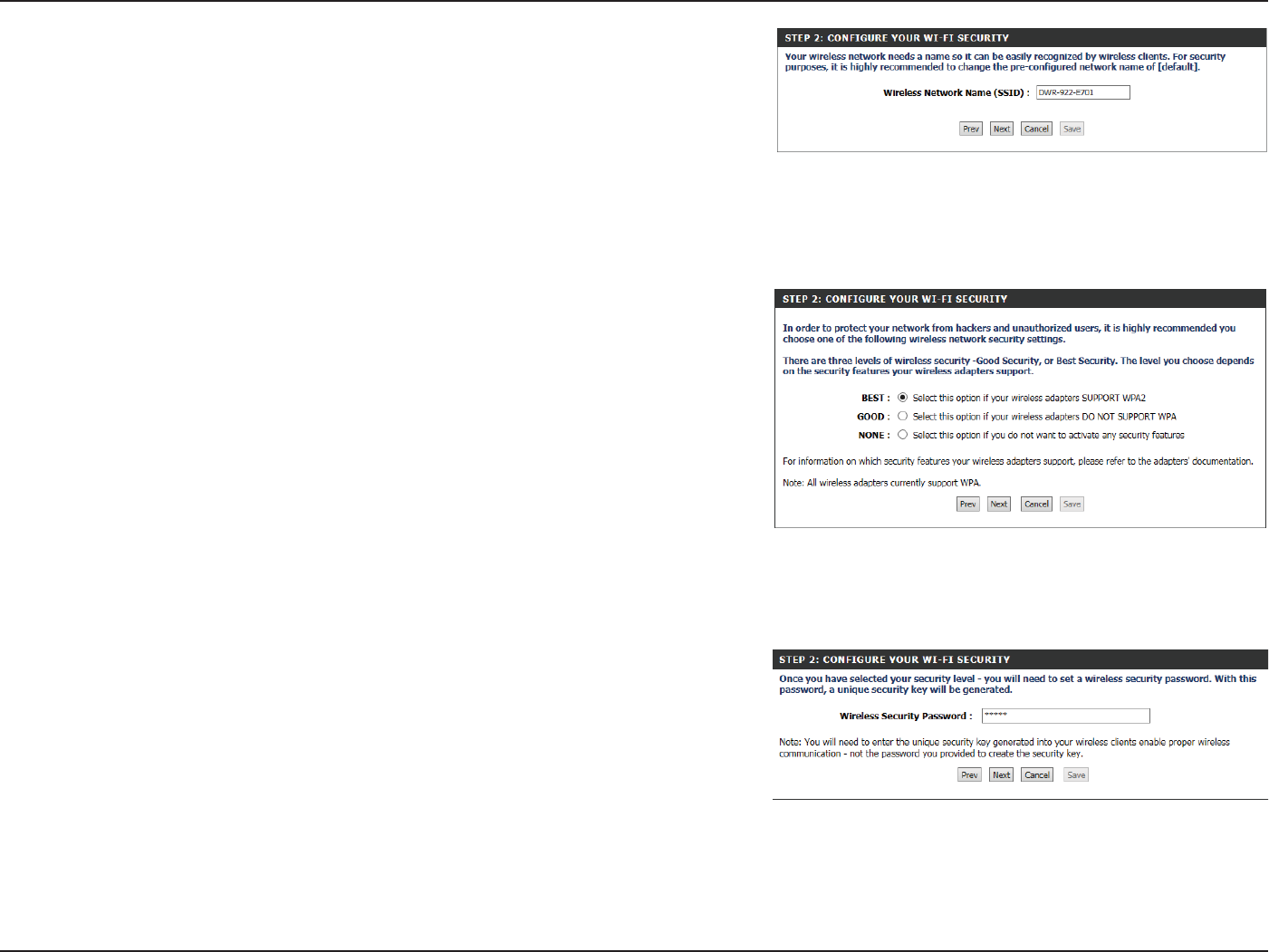
21D-Link DWR-9 User Manual
Section 4 - Conguration
Enter a Wireless Network Name (SSID), then click Next to continue.
Choose the best security level supported by your wireless clients. Click Next to
continue.
Unless you chose None in the previous step, enter a security password. Clients must
enter this password to connect to your wireless network. Click Next to continue.
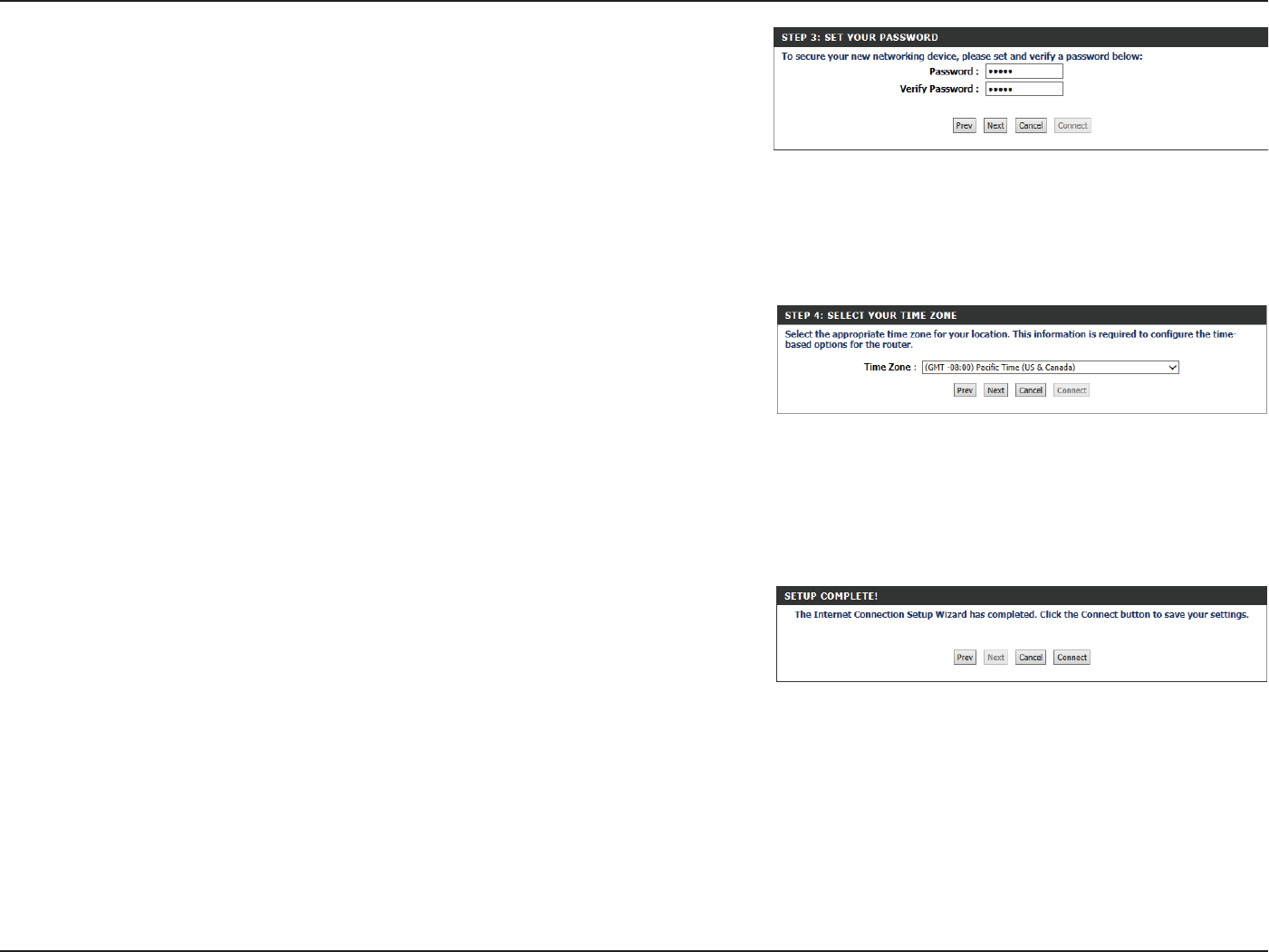
22D-Link DWR-9 User Manual
Section 4 - Conguration
This completes the Internet Connection Setup Wizard. Click Connect to save your
changes and reboot the router.
Create a new admin password and then click Next to continue. Users must enter this
password to enter the setup utility.
Select your time zone from the drop-down box and then click Next to continue.
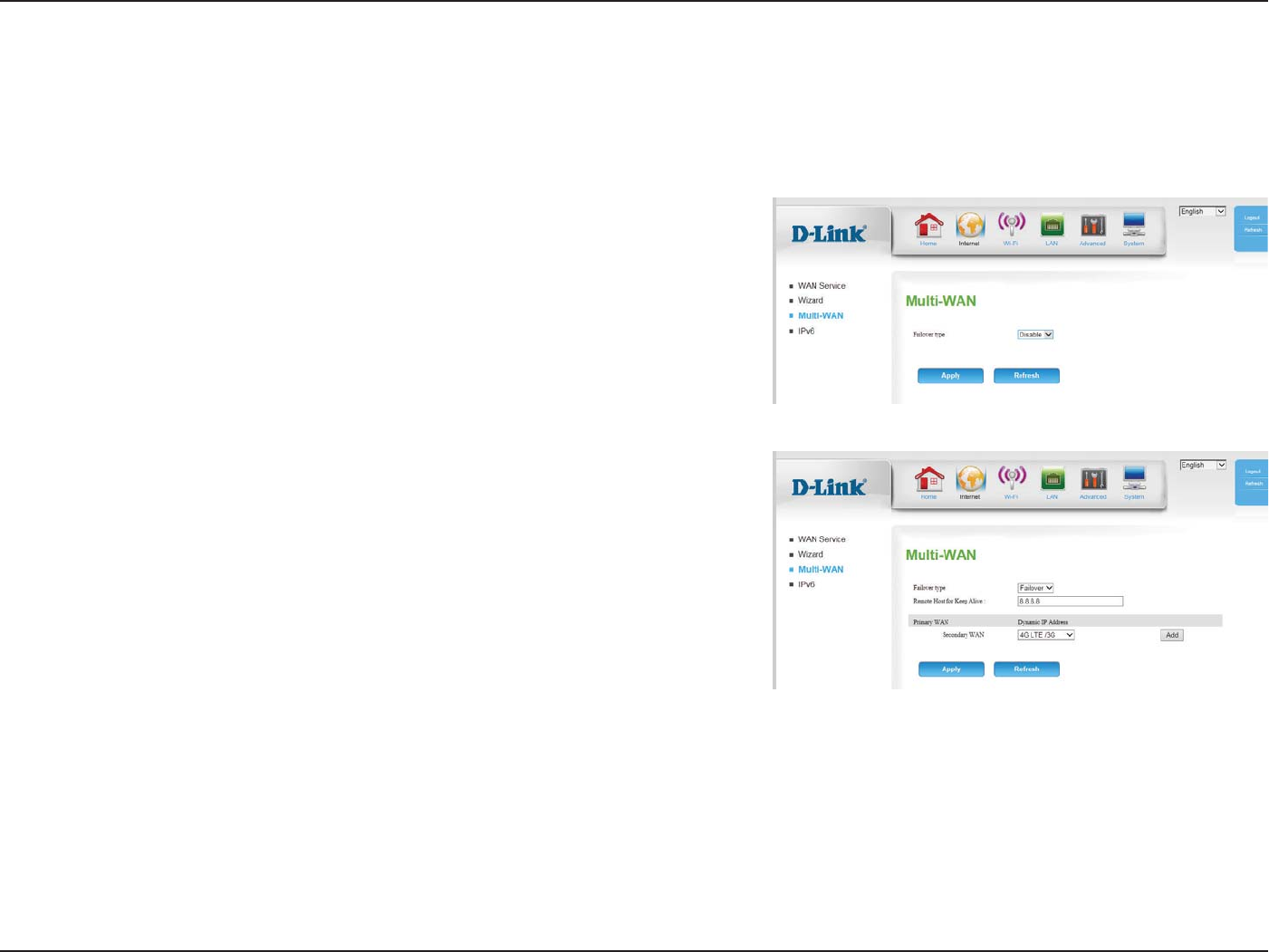
23D-Link DWR-9 User Manual
Section 4 - Conguration
Multi-WAN
Select Failover to enable the failover function.
This option should be set to an external IP address that can be
used to ensure that the 4G LTE connection will be kept from
going oine due to inactivity. An example would be Google’s
public DNS servers (8.8.8.8 or 8.8.4.4) or your Internet service
provider’s DNS servers.
This will automatically be set to the currently congured Internet
connection type.
This can be set by clicking on Add, the available options will be
shown in the drop down box that appears.
Click Apply to save your settings, or Refresh to revert to your
previous settings.
Failover type:
Remote Host for
Keep Alive:
Primary WAN:
Secondary WAN:
The DWR-9’s multi-WAN feature allows you to set your router to automatically switch to a secondary Internet connection if your primary Internet
connection is lost. Note that you must rst specify your primary Internet connection either on the WAN Service tab (see page 8) or the Wizard
(see “Wizard” on page 19) before you can specify a secondary Internet connection. By default, the primary connection is 4G.
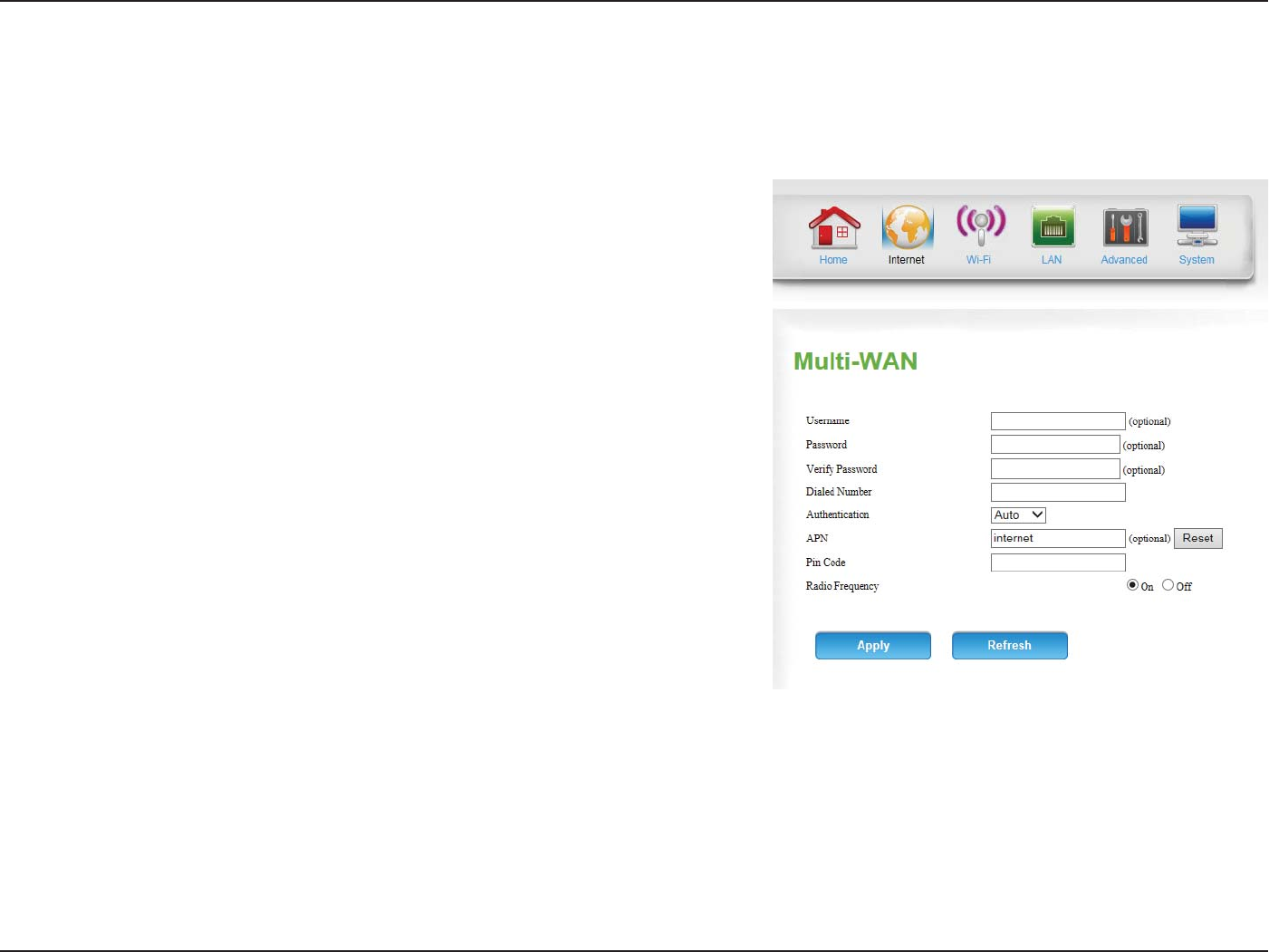
24D-Link DWR-9 User Manual
Section 4 - Conguration
Multi-WAN Conguration
Fill in only if requested by your ISP (optional).
Fill in only if requested by you ISP (optional).
Retype password if required above.
If your ISP provides you with a dial-in number, enter it here. Empty
by default.
Select PAP, CHAP or Auto if requested by your carrier. The default
authentication method is Auto.
Enter the APN (Access Point Name) for your 4G connection.
Press Reset to restore your APN setting to factory default. This
button leaves all other settings unchanged, including those on
this page.
If your SIM/UICC card has a PIN, enter it here (optional).
Turns the cellular radio on or o. This setting is intended to disable
the cellular radio for areas where radio transmissions may be
restricted.
Click Apply to save your settings, or Refresh to revert to your
previous settings.
Username:
Password:
Verify Password:
Dialed Number:
Authentication:
APN:
Reset:
Pin Code:
Radio
Frequency:
After selecting a secondary WAN and clicking apply, you will be directed to a setup screen for the relevant connection type.
4G LTE failover
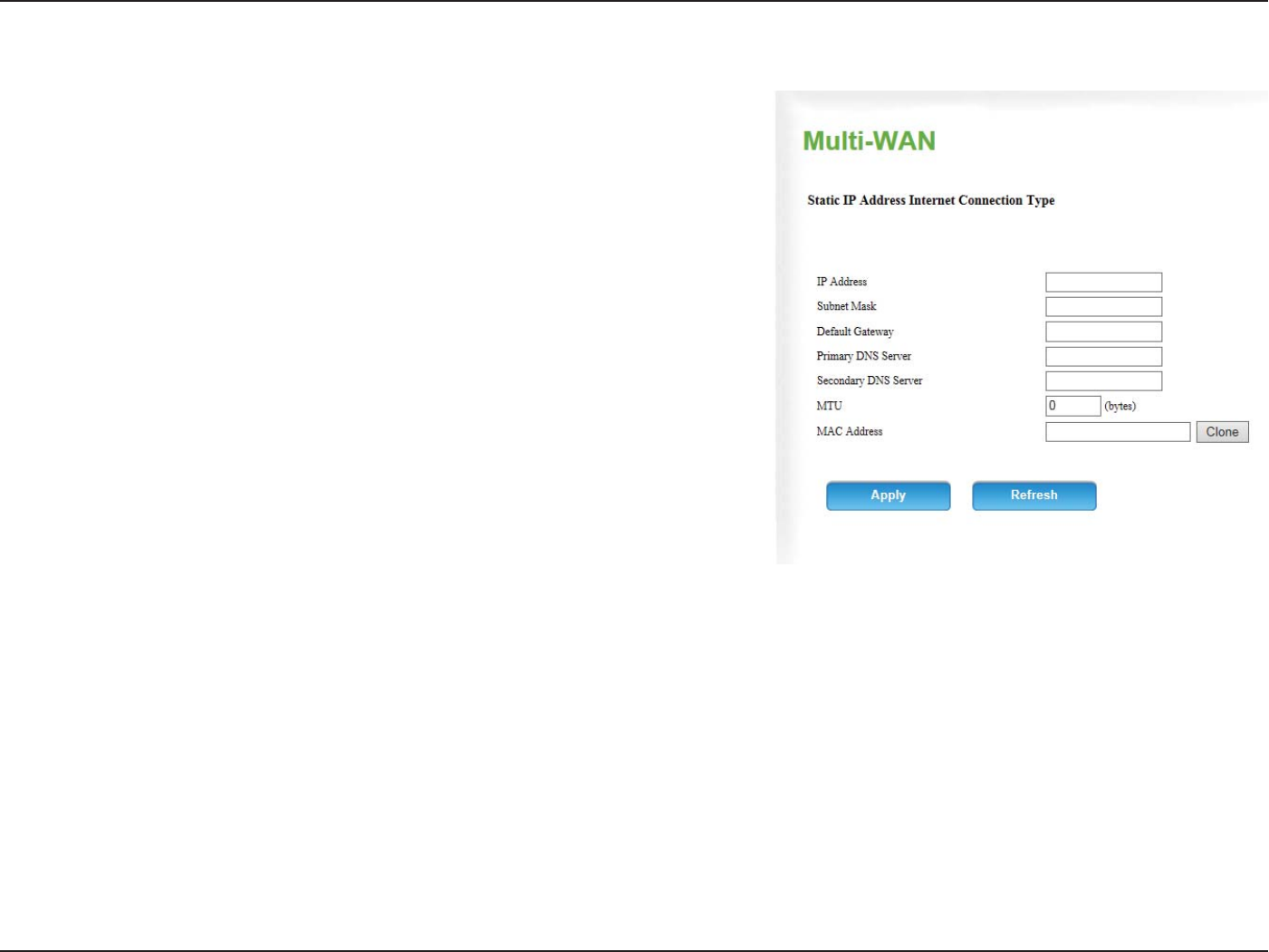
25D-Link DWR-9 User Manual
Section 4 - Conguration
Static IP Address Failover
Enter the IP address assigned to your network connection.
Enter the subnet mark.
Enter the default gateway.
Enter the primary DNS server.
Enter the secondary DNS server.
You may need to change the Maximum Transmission Unit (MTU)
for optimal performance. The default value is 0.
The default MAC address is set to the WAN port’s physical interface
MAC address. Changing it is not recommended unless required
to do so by your ISP. You can use the Clone button to replace the
WAN port’s MAC address with the MAC address of your PC.
Click Apply to save your settings, or Refresh to revert to your
previous settings.
IP Address:
Subnet Mask:
Default Gateway:
Primary DNS
Server:
Secondary DNS
Server:
MTU:
MAC Address:
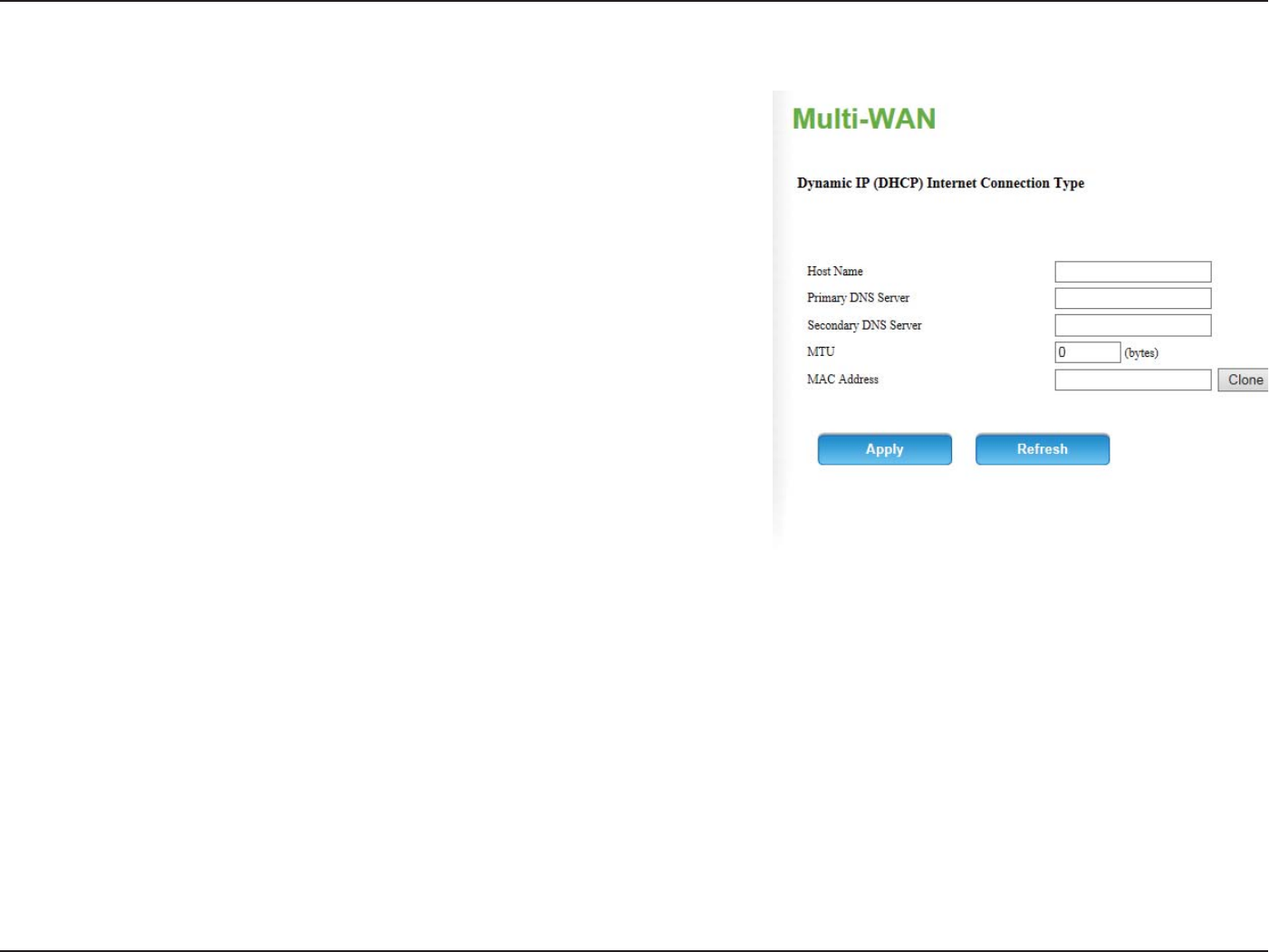
26D-Link DWR-9 User Manual
Section 4 - Conguration
Dynamic IP Failover
If your ISP requires you to enter a host name, enter it here. In most
cases, you may leave this blank.
Enter the primary DNS server.
Enter the secondary DNS server.
You may need to change the Maximum Transmission Unit (MTU)
for optimal performance. The default value is 0.
The default MAC address is set to the WAN port’s physical interface
MAC address. Changing it is not recommended unless required
to do so by your ISP. You can use the Clone button to replace the
WAN port’s MAC address with the MAC address of your PC.
Click Apply to save your settings, or Refresh to revert to your
previous settings.
Host Name:
Primary DNS
Server:
Secondary DNS
Server:
MTU:
MAC Address:
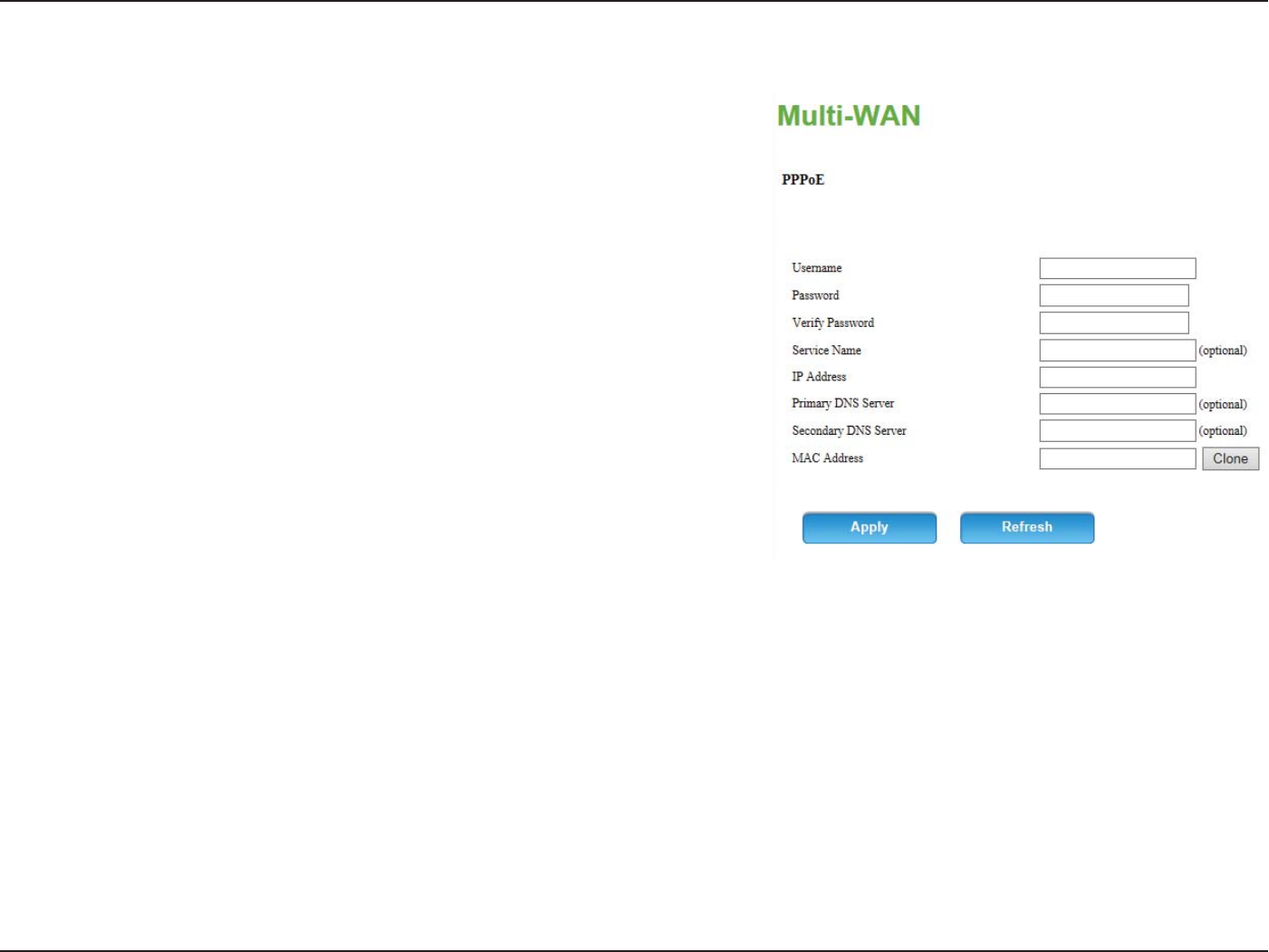
27D-Link DWR-9 User Manual
Section 4 - Conguration
PPPoE Failover
The username provided by your ISP for your PPPoE account.
The password provided by your ISP for your PPPoE account
Re-type your password in this eld.
Fill in if provided by your ISP (optional).
Fill in if provided by your ISP. If not, keep the default value.
Enter the primary DNS server.
Enter the secondary DNS server.
The default MAC address is set to the WAN port’s physical interface
MAC address. Changing it is not recommended unless required
to do so by your ISP. You can use the Clone button to replace the
WAN port’s MAC address with the MAC address of your PC.
Click Apply to save your settings, or Refresh to revert to your
previous settings.
Username:
Password:
Verify Password:
Service Name:
IP Address:
Primary DNS
Server:
Secondary DNS
Server:
MAC Address:
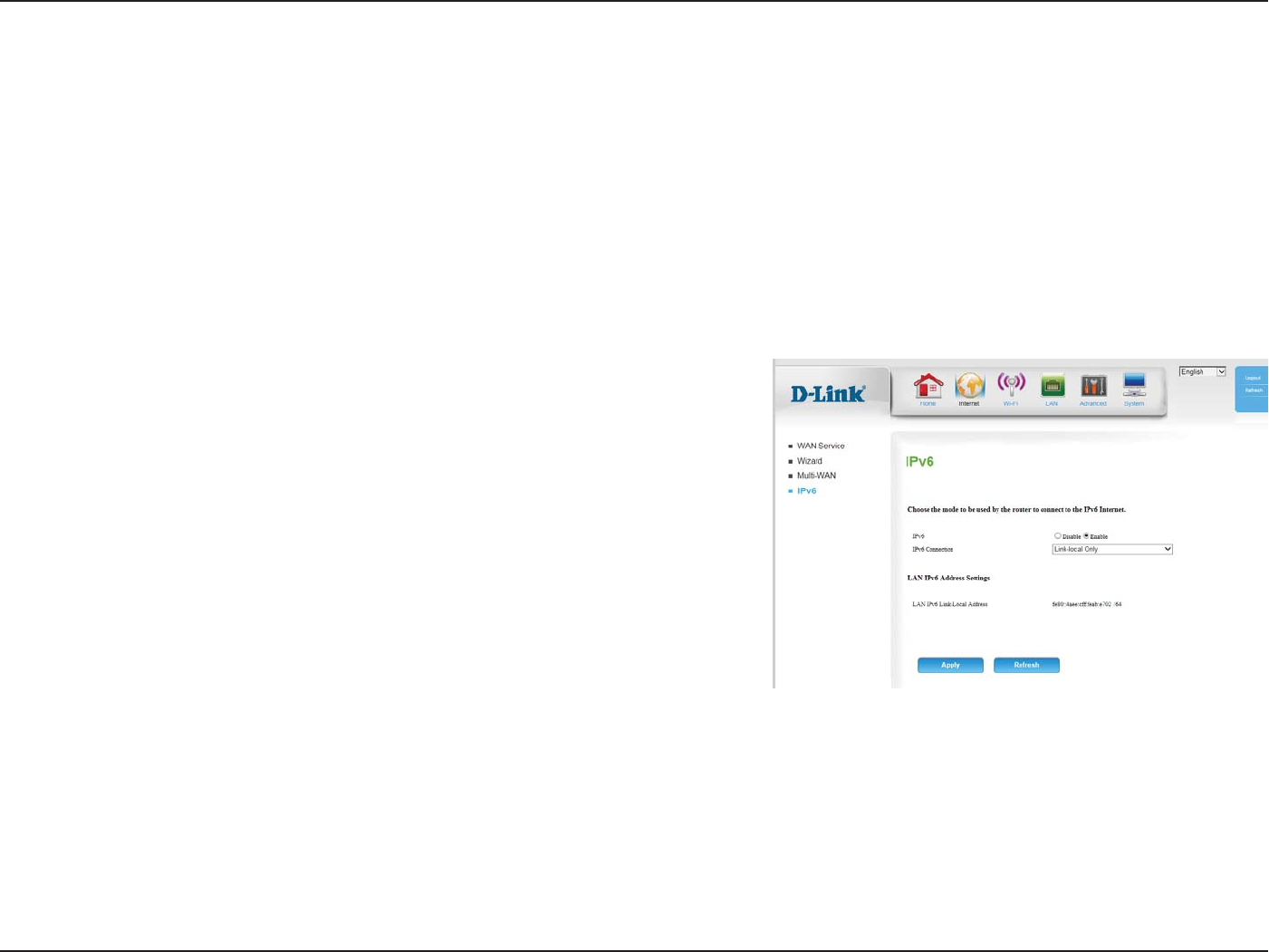
28D-Link DWR-9 User Manual
Section 4 - Conguration
IPv6
Link-local Only
Displays the IPv6 address of the router.
Click Apply to save your settings, or Refresh to revert to your
previous settings.
LAN IPv6 Link-
Local Address:
To enable IPv6, select Enable.
Select the IPv6 connection type specied by your ISP. The
corresponding settings will be displayed below. Please see the
following sections for details on how to congure these dierent
connection types.
IPv6:
IPv6 Connection:
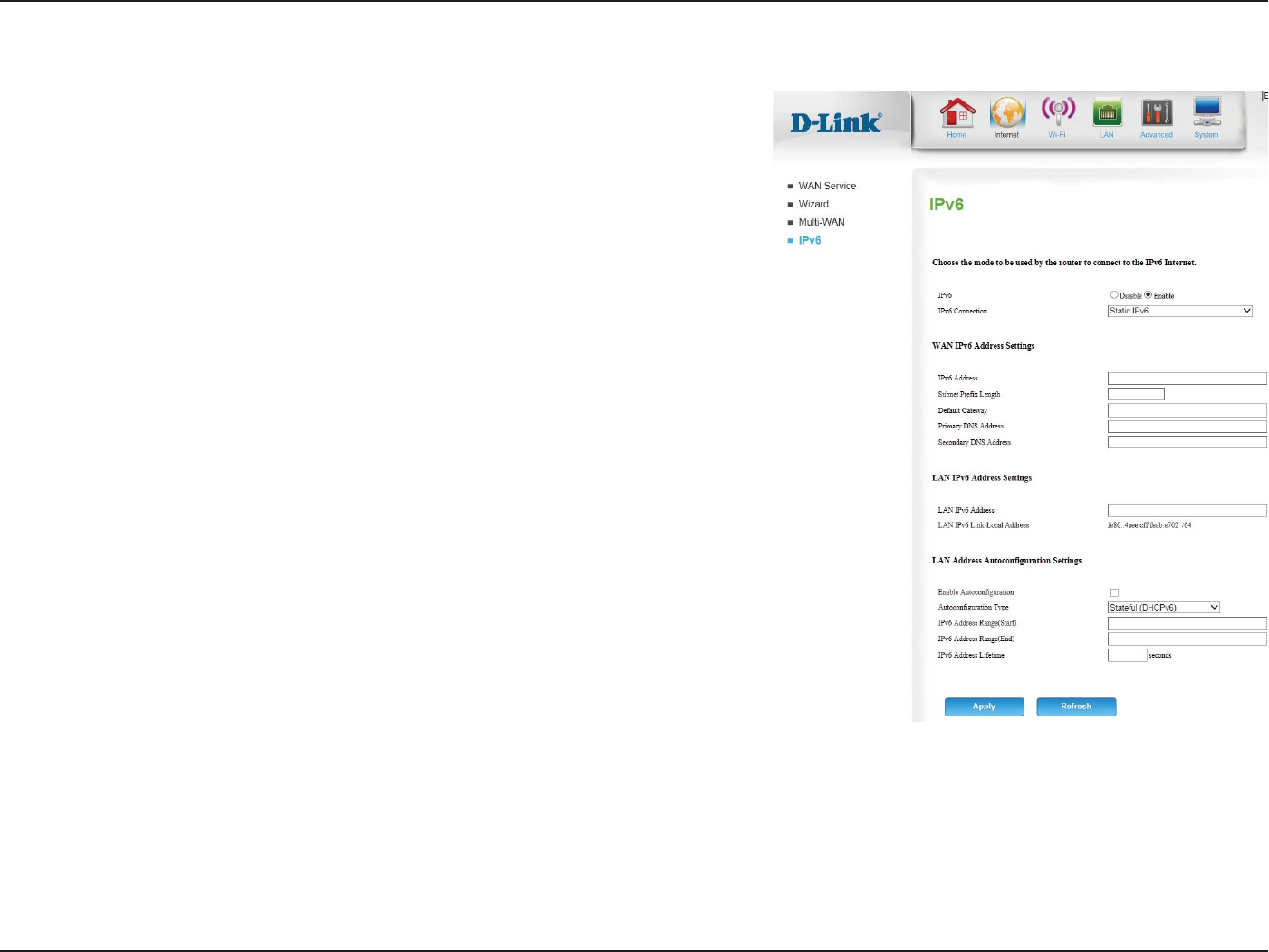
29D-Link DWR-9 User Manual
Section 4 - Conguration
Static IPv6
Enter the static IPv6 address of the router.
Enter the subnet prex length.
Enter the default gateway address.
Enter the primary and secondary DNS server addresses.
Enter the LAN (local) IPv6 address for the router.
Displays the router’s LAN link-local address.
Check to enable the autoconguration feature for LAN devices.
Select Stateful (DHCPv6) or SLAAC + Stateless DHCPv6. This will
determine the conguration type for you IPv6 LAN.
If you selected Stateful (DHCPv6), enter the address range start.
If you selected Stateful (DHCPv6), enter the address range end.
Enter the IPv6 address lifetime (in seconds).
Click Apply to save your settings, or Refresh to revert to your
previous settings.
IPv6 Address:
Subnet Prex
Length:
Default Gateway:
DNS Addresses:
LAN IPv6 Address:
LAN IPv6 Link-
Local Address:
Enable
Autoconguration:
Autoconguration
Type:
IPv6 Address
Range (Start):
IPv6 Address
Range (End):
Router
Advertisement
Lifetime:
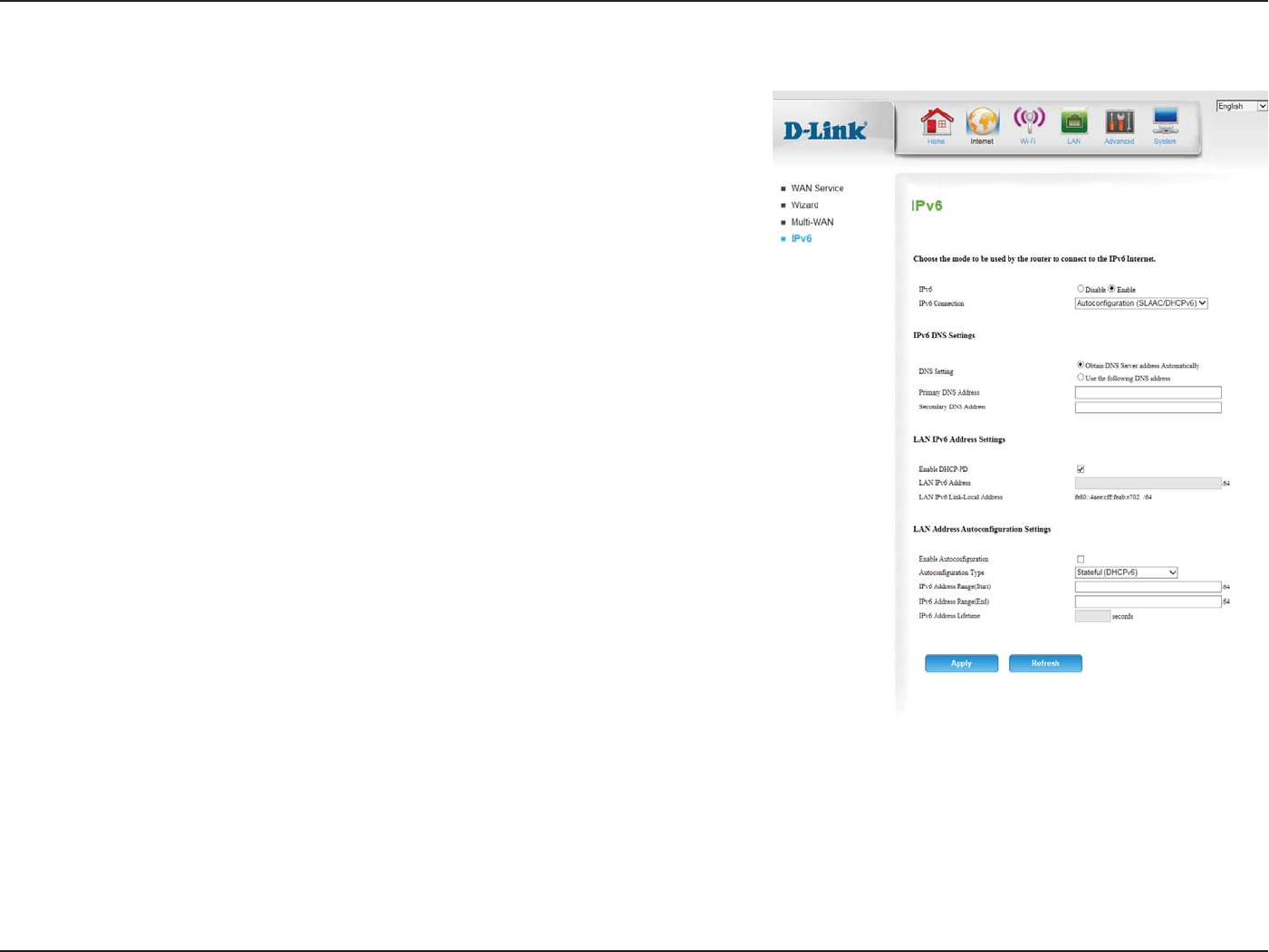
30D-Link DWR-9 User Manual
Section 4 - Conguration
Autoconguration (SLAAC/DHCPv6)
Select either Obtain DNS server address automatically or Use
the following DNS address.
Enter the primary and secondary DNS server addresses.
Check to enable the DHCP-PD feature.
If you did not enable DHCP-PD, enter the LAN (local) IPv6 address
for the router.
Displays the router’s LAN link-local address.
Check to enable the autoconguration feature.
Select Stateful (DHCPv6) or SLAAC + Stateless DHCPv6. This will
determine the conguration type for you IPv6 LAN.
If you selected Stateful (DHCPv6), enter the address range start.
If you selected Stateful (DHCPv6), enter the address range end.
Enter the IPv6 address lifetime (in seconds).
Click Apply to save your settings, or Refresh to revert to your
previous settings.
DNS Setting:
DNS Addresses:
Enable DHCP-PD:
LAN IPv6 Address:
LAN IPv6 Link-
Local Address:
Enable
Autoconguration:
Autoconguration
Type:
IPv6 Address
Range (Start):
IPv6 Address
Range (End):
IPv6 Address
Lifetime:
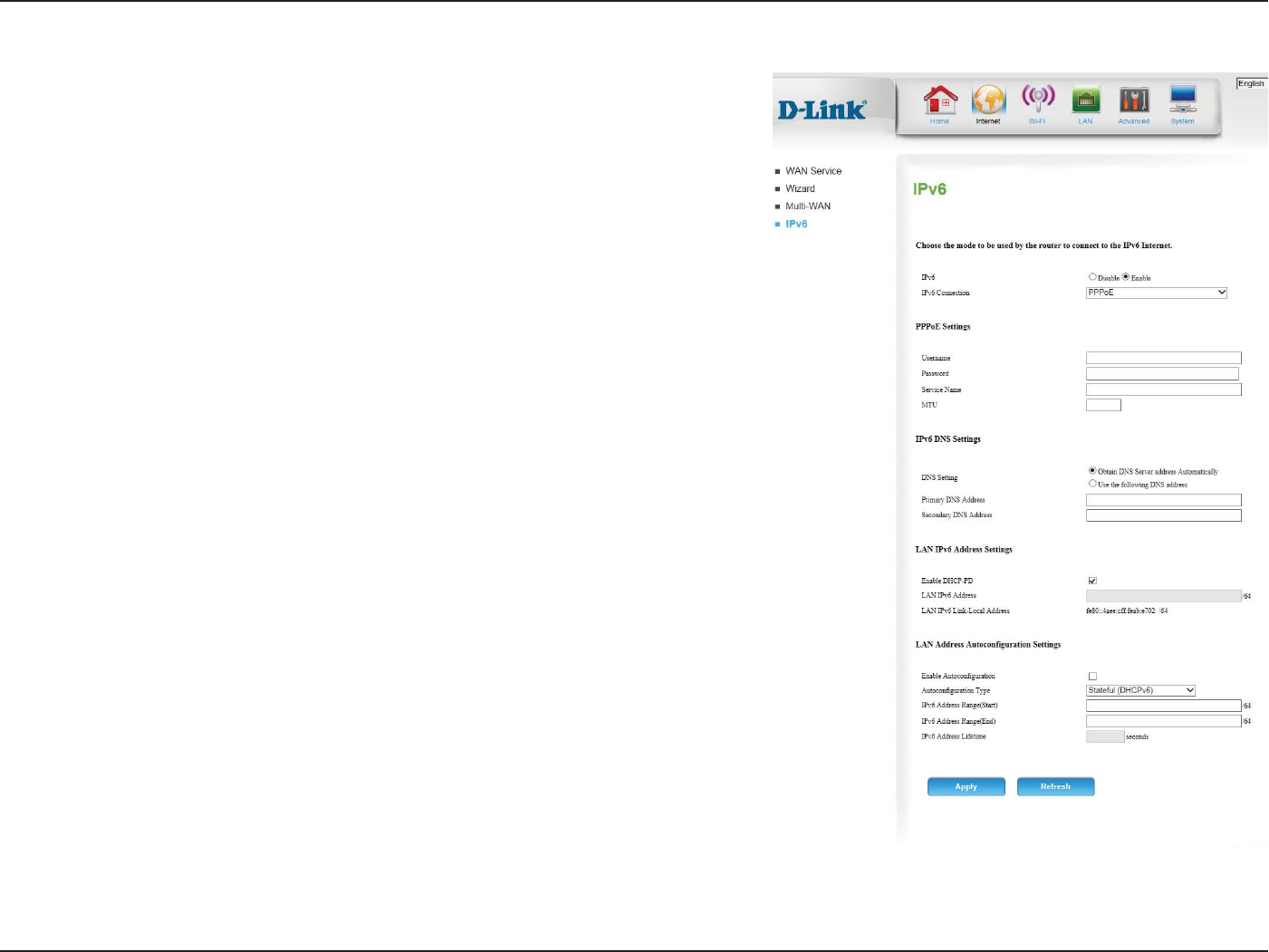
31D-Link DWR-9 User Manual
Section 4 - Conguration
PPPoE
Enter your PPPoE user name.
Enter your PPPoE password.
Enter the ISP Service Name (optional).
Maximum Transmission Unit - you may need to change the MTU
for optimal performance with your specic ISP.
Select either Obtain DNS Server address Automatically or Use
the following DNS address.
Enter the primary and secondary DNS server addresses.
Check to enable the DHCP-PD feature.
If you did not enable DHCP-PD, enter the LAN (local) IPv6 address.
Displays the router’s LAN link-local address.
Check to enable the autoconguration feature.
Select Stateful (DHCPv6) or SLAAC + Stateless DHCPv6. This will
determine the conguration type for you IPv6 LAN.
If you selected Stateful (DHCPv6), enter the address range start.
If you selected Stateful (DHCPv6), enter the address range end.
Username:
Password:
Service Name:
MTU:
DNS Setting:
DNS Addresses:
Enable DHCP-PD:
LAN IPv6 Address:
LAN IPv6 Link-
Local Address:
Enable
Autoconguration:
Autoconguration
Type:
IPv6 Address
Range (Start):
IPv6 Address
Range (End):
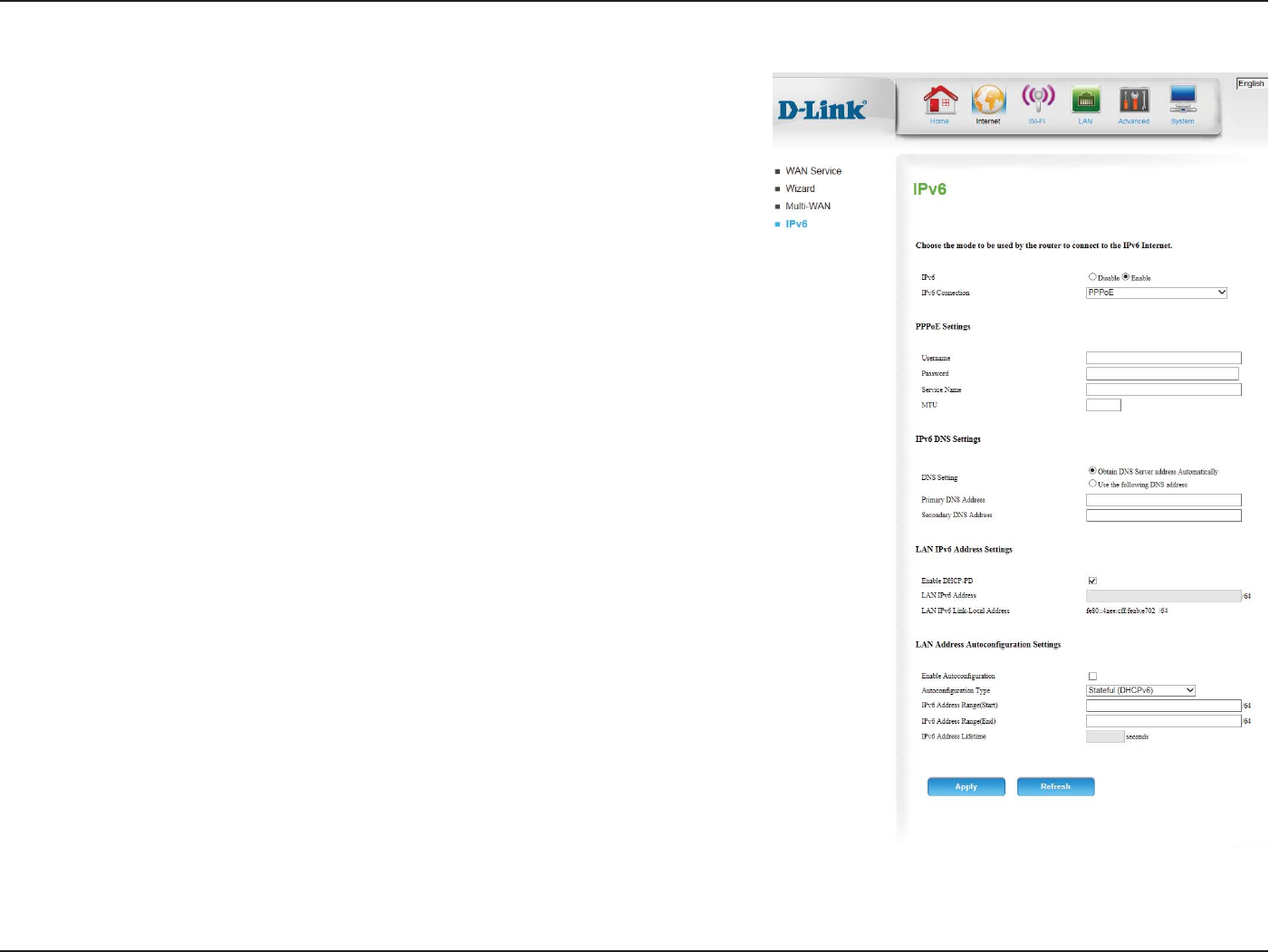
32D-Link DWR-9 User Manual
Section 4 - Conguration
PPPoE
Enter the IPv6 address lifetime (in seconds).
Click Apply to save your settings, or Refresh to revert to your
previous settings.
IPv6 Address
Lifetime:
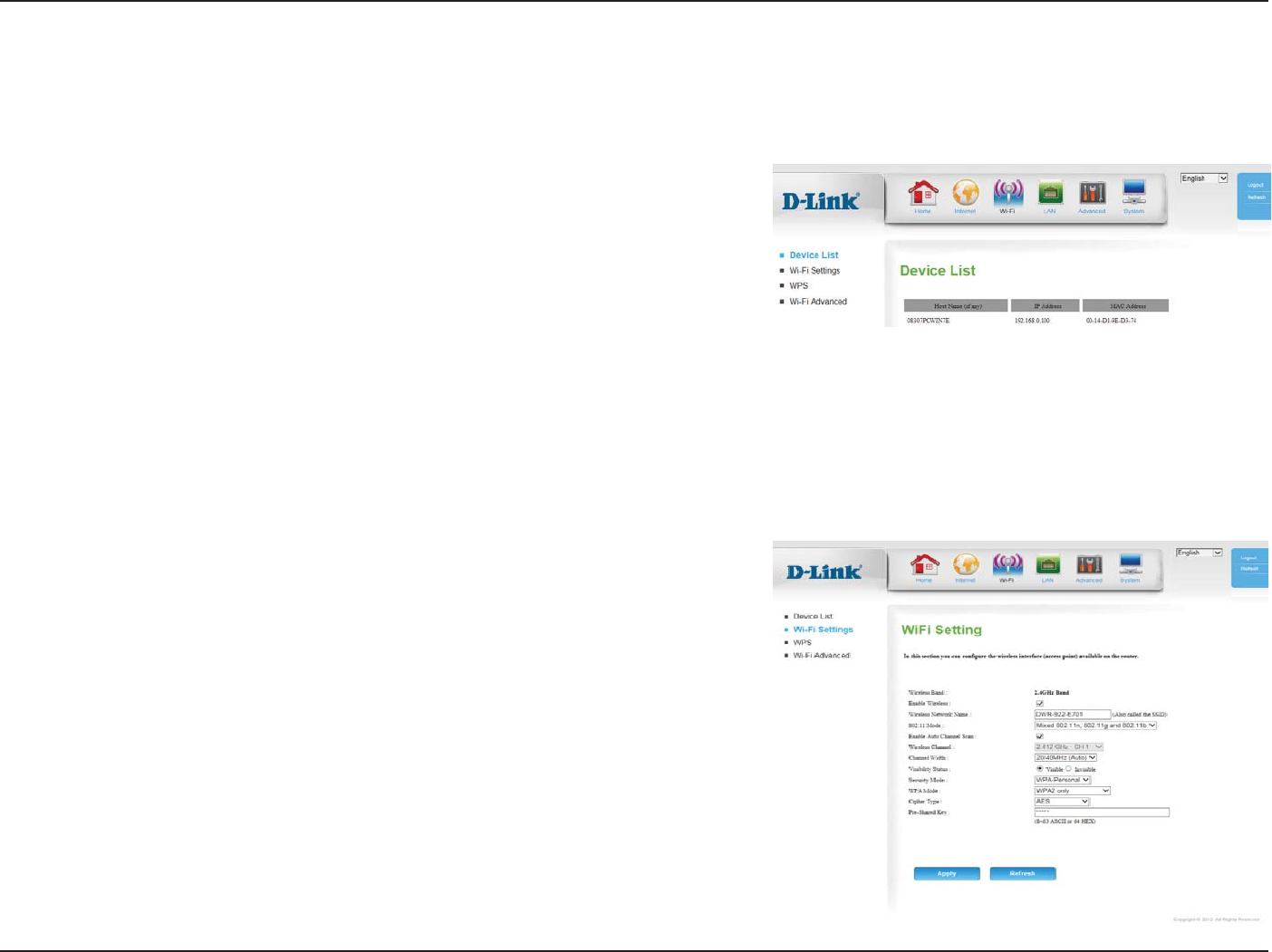
33D-Link DWR-9 User Manual
Section 4 - Conguration
Wi-Fi
Device List
This page displays a list of currently-connected wireless clients, and their
respective MAC addresses.
Wi-Fi Settings
Check this box to enable wireless access. When you enable this
option, the following parameters take eect.
Also known as the SSID (Service Set Identier), this is the name of
your Wireless Local Area Network (WLAN). Enter a name using up
to 32 alphanumeric characters. The SSID is case-sensitive.
Select the IEEE 802.11 standard used by your wireless clients.
Enabling this feature will allow the router to automatically scan for
the best wireless channel to use.
If Auto Channel Scan is disabled, select the desired channel here.
Enable Wireless:
Wireless
Network Name:
802.11 Mode:
Enable Auto
Channel Scan:
Wireless
Channel:
This page lets you set up your wireless network and choose a wireless security mode. Click Apply to save your settings, or Refresh to revert to your
previous settings.
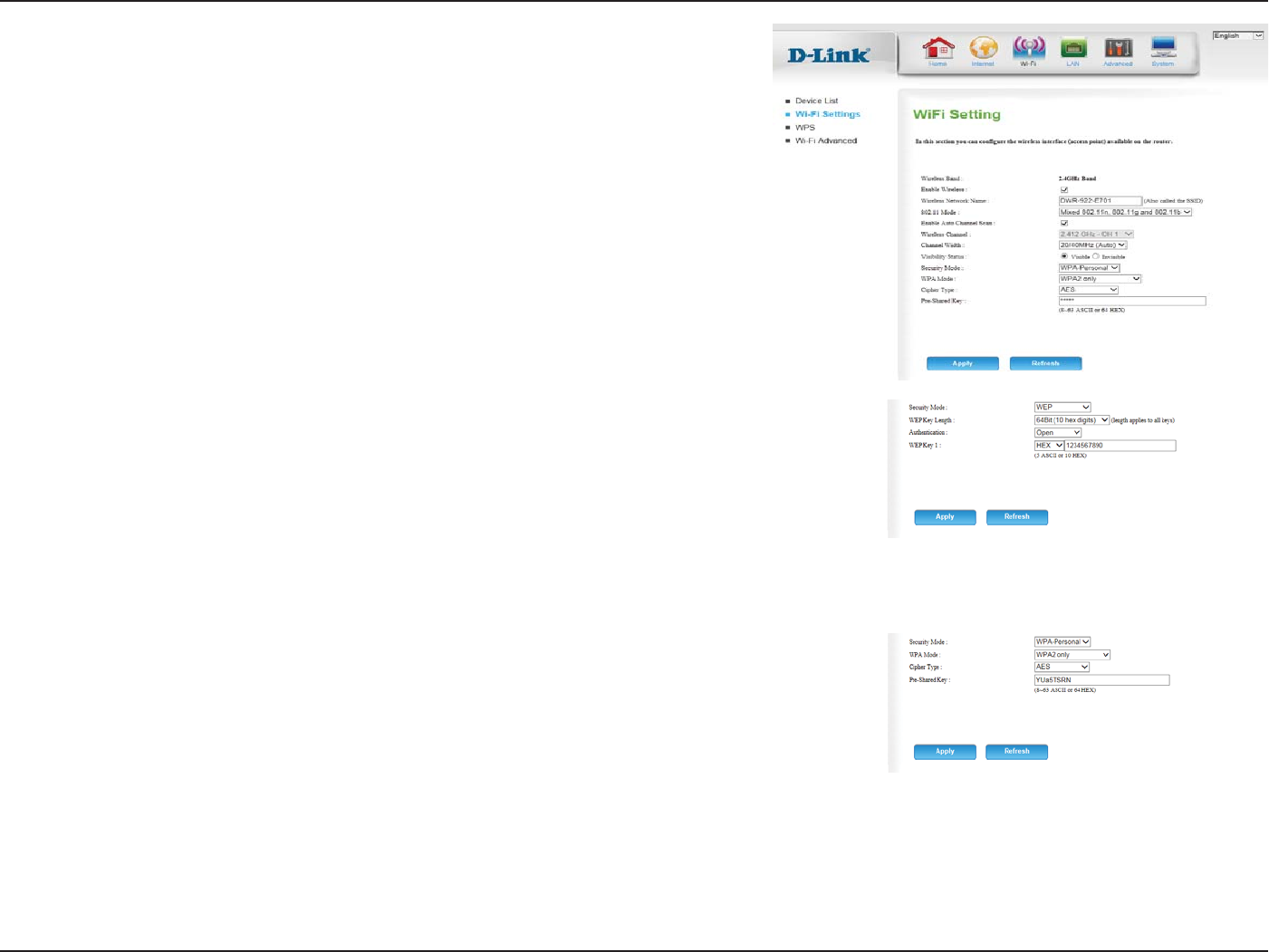
34D-Link DWR-9 User Manual
Section 4 - Conguration
A higher channel width allows for faster data transmission, at the
possible expense of wireless coverage and compatibility with
older wireless clients. Select the optimum channel width for your
wireless network from the drop-down menu.
The default setting is Visible. Select Invisible if you do not want
to broadcast the SSID of your wireless network.
Select the desired wireless encryption mode. WPA/WPA2 is
recommended if your clients support it.
Channel Width:
Visibility Status:
Security Mode:
Select whether to use WPA2 only or Auto (WPA or WPA2). WPA2
only is the most secure, provided that all of your clients support it.
Select whether to use the TKIP or AES cipher. The AES cipher is
the most secure, provided that all of your clients can support it.
Enter the key/password you want to use for your wireless network.
The key must be between 8 and 63 characters long, and may only
contain letters and numbers.
WPA Mode:
Cipher Type:
Pre-Shared Key:
If you choose WPA-Personal, the following options will appear:
Select whether to use 64-bit or 128-bit encryption.
Select whether to use Open or Shared authentication.
Set the WEP key/password for your wireless network. Based on
whether you are using 64 or 128-bit encryption, and whether
you are using a HEX or ASCII key, you will need to enter dierent
numbers of characters for your key, as indicated below the WEP
Key text box. ASCII keys may use letters and numbers only, and
HEX keys may use numbers 0-9 and letters A-F only.
WEP Key Length:
Authentication:
WEP Key 1:
If you choose WEP, the following options will appear:
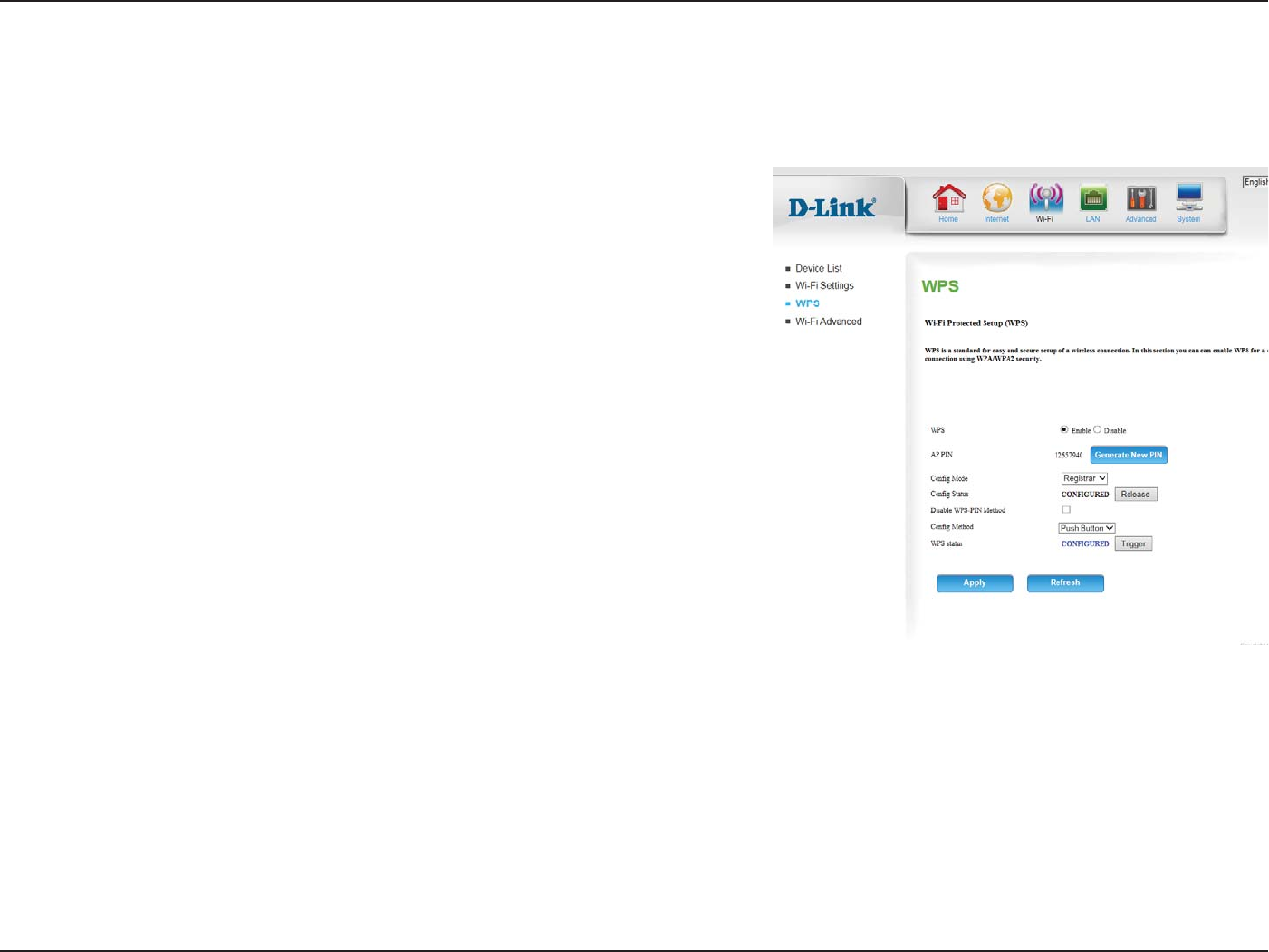
35D-Link DWR-9 User Manual
Section 4 - Conguration
Select whether you would like to Enable or Disable WPS features.
If you use Windows 7’s Connect to a network wizard to do initial
conguration of the router, you will have the option to enter the
WPS PIN/AP PIN into the wizard when prompted. The factory
default WPS PIN/AP PIN is printed on a label located on the
bottom of the router. You can click the Generate New PIN button
to change it to a randomly generated PIN.
Select whether the WPS cong mode should be set to Registrar or
Enrollee. In most cases, this should be set to Registrar so that you
can use WPS to connect new wireless clients.
If this is set to CONFIGURED, the router will be marked as “already
congured” to computers that try to use WPS conguration, such
as Windows 7’s Connect to a network wizard. You can click the
Release button to change the status to UNCONFIGURED to allow
for WPS conguration of the router.
If this is set to UNCONFIGURED, you can click the Set button to
change the status to CONFIGURED to block WPS conguration of
the router.
Enable this option to prevent clients from connecting to the router
using the PIN method. If this option is enabled, clients must use
the push-button method to connect.
WPS:
AP PIN:
Cong Mode:
Cong Status:
Disable WPS-PIN
Method:
The Wi-Fi Protected Setup page allows you to create a wireless connection between your router and a device automatically by simply pushing a
button or entering a PIN code.
WPS
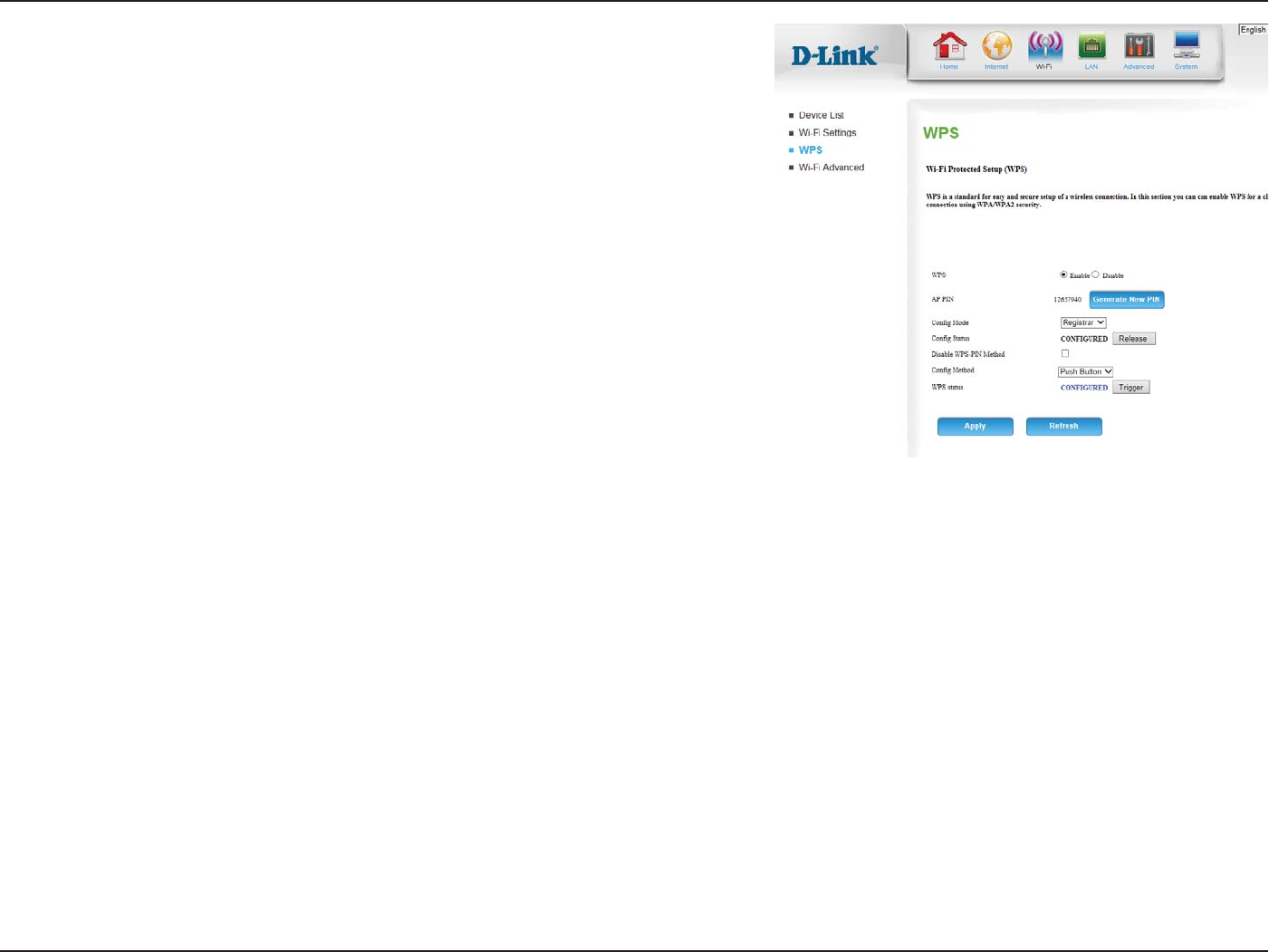
36D-Link DWR-9 User Manual
Section 4 - Conguration
This lets you choose whether to use the Push Button connection
method (PBC) or PIN method to connect to a wireless client when
the Trigger button is clicked. If you choose the PIN method, you
will need to enter an 8-digit PIN number that the wireless client
needs to use to connect to your router.
This will show the current WPS connection process status. Click
the Trigger button to initiate a WPS connection.
Click Apply to save your settings, or Refresh to revert to your
previous settings.
Cong Method:
WPS status:
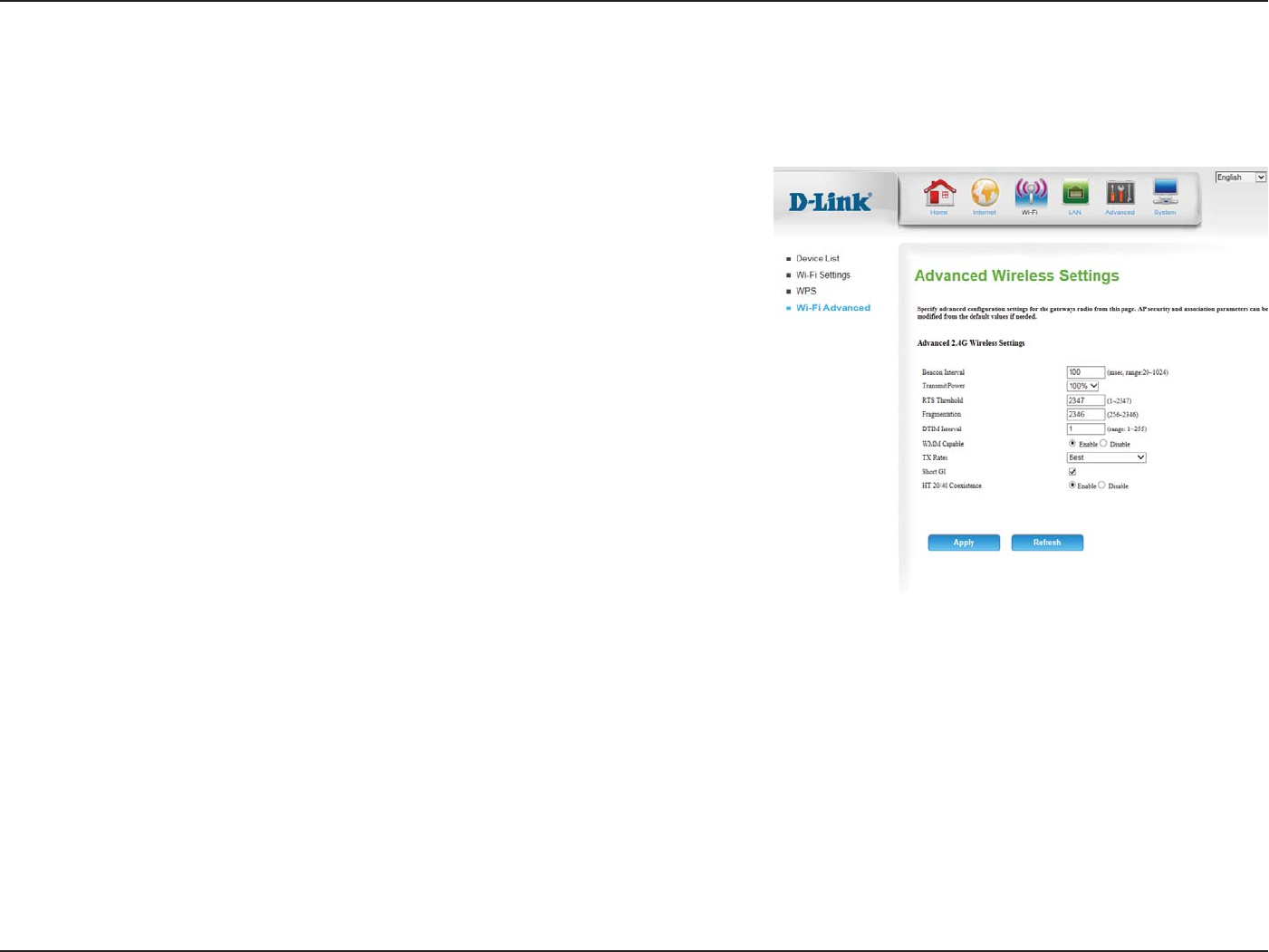
37D-Link DWR-9 User Manual
Section 4 - Conguration
Wi-Fi Advanced
This page contains settings which can negatively aect the performance of your router if congured improperly. Do not change these settings
unless you are already familiar with them or have been instructed to make the change by one of our support personnel.
Specify a value for the beacon interval. Beacons are packets sent
by an access point to synchronize a wireless network. 100 is the
default setting and is recommended.
Set the transmit power of the antennas.
This value should remain at its default setting of 2347. If
inconsistent data ow is a problem, only a minor modication
should be made.
The fragmentation threshold, which is specied in bytes,
determines whether packets will be fragmented. Packets
exceeding the 2346 byte setting will be fragmented before
transmission. 2346 is the default setting.
Set the interval for DTIM. A Delivery Trac Indication Message
(DTIM) is a countdown informing clients of the next window for
listening to broadcast and multicast messages. The default interval
is 1.
WMM (Wi-Fi Multimedia) is a QoS (Quality of Service) system for
your wireless network. Enable this option to improve the quality of
video and voice applications for your wireless clients.
Select the basic transfer rates based on the speed of wireless
adapters on your wireless network. It is strongly recommended to
keep this setting to Best.
Beacon Interval:
Transmit Power:
RTS Threshold:
Fragmentation:
DTIM Interval:
WMM Capable:
TX Rates:
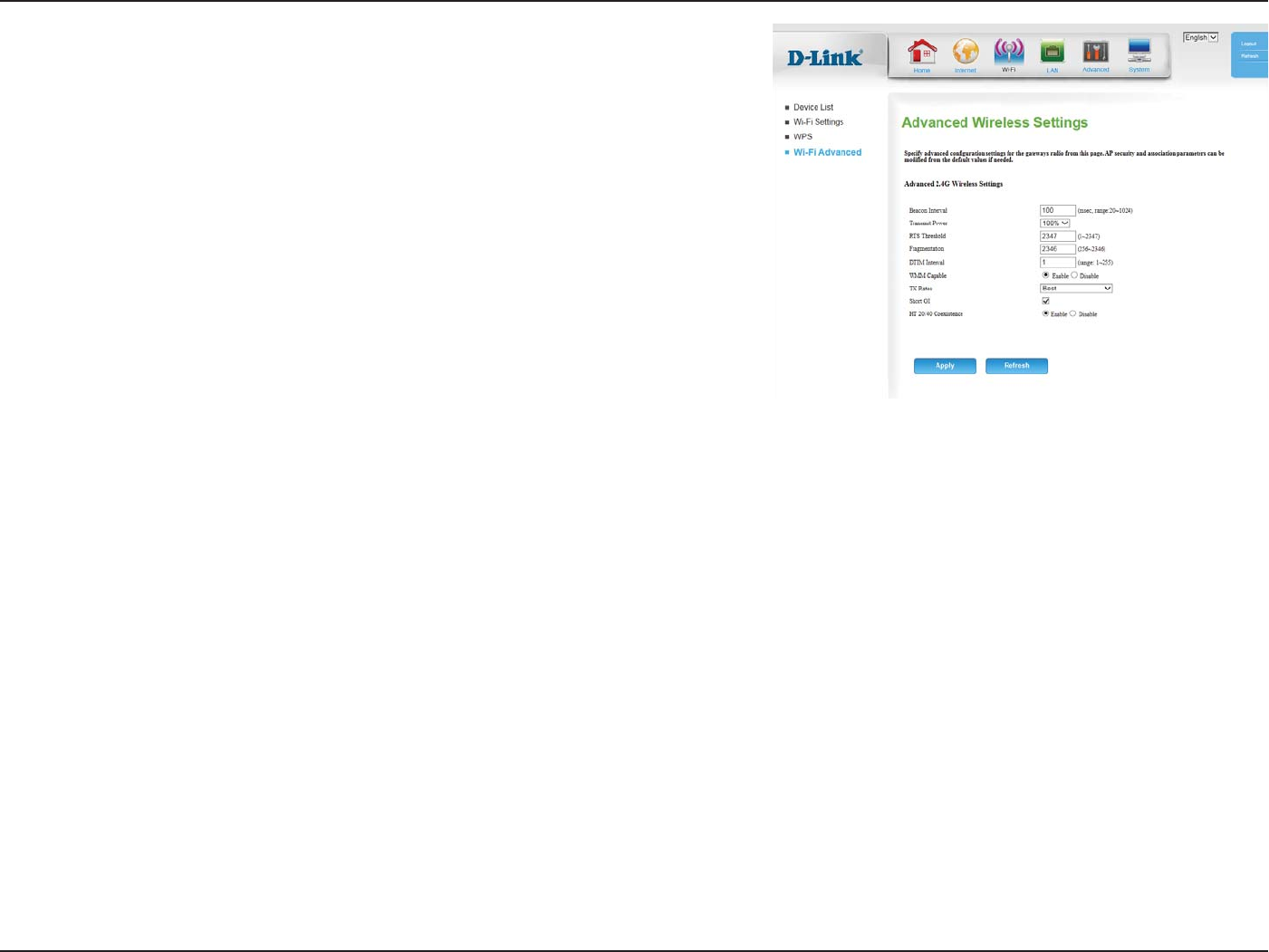
38D-Link DWR-9 User Manual
Section 4 - Conguration
Check this box to reduce the guard interval to 400 ns. This can
increase the throughput rate provided that the delay spread of the
connection is also low. However, it can also increase error rate in
some installations, due to increased sensitivity to radio-frequency
reections. Select the option that works best for your installation.
Enable this option to reduce interference from other wireless
networks in your area. If the channel width is operating at 40 MHz
and there is another wireless network’s channel over-lapping
and causing interference, the router will automatically change to
20MHz.
Click Apply to save your settings, or Refresh to revert to your
previous settings.
Short GI:
HT 20/40
Coexistence:
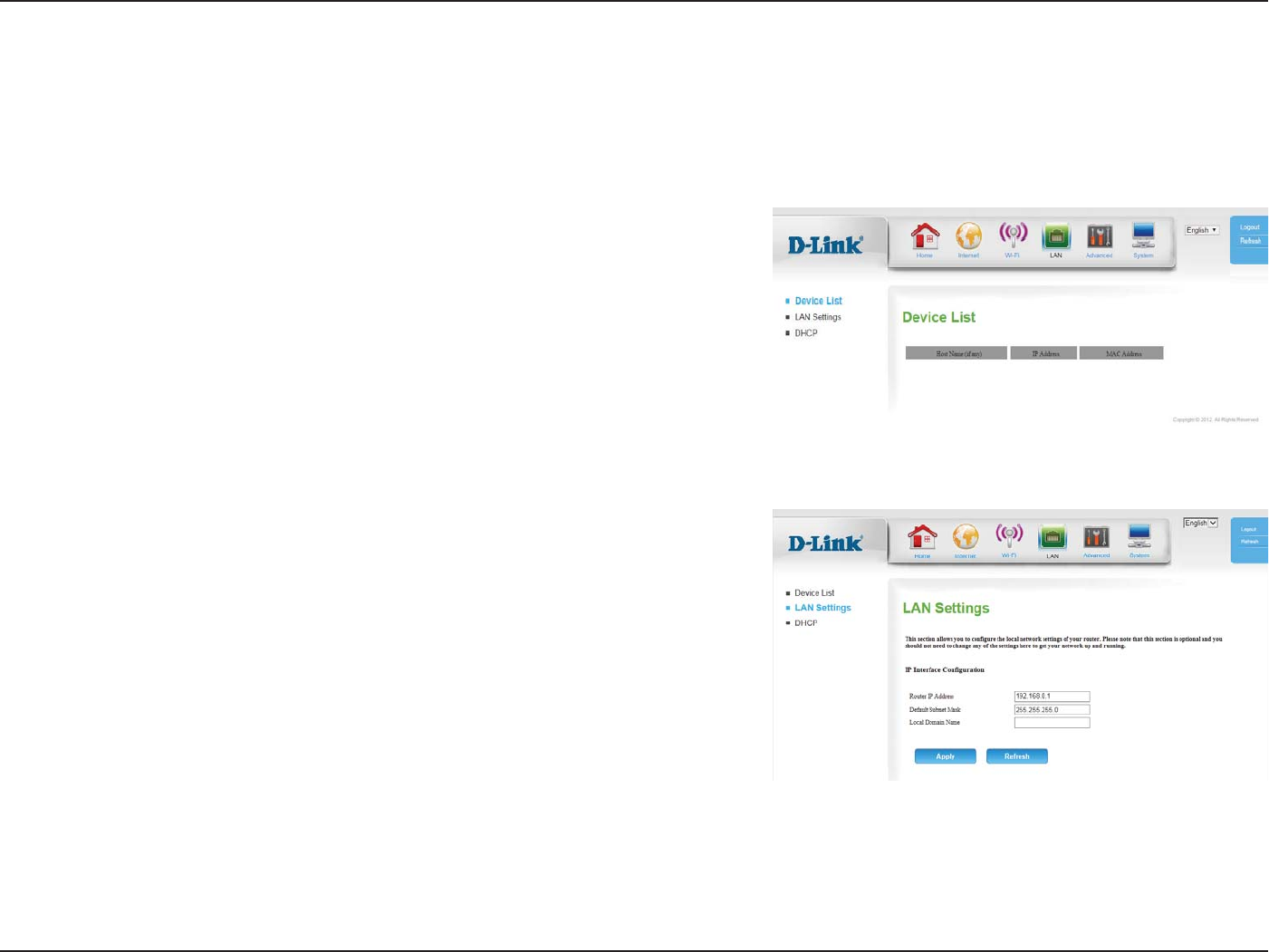
39D-Link DWR-9 User Manual
Section 4 - Conguration
LAN
Device List
This page displays a list of currently-connected wired clients, and their respective
MAC addresses.
LAN Settings
Enter the IP address you want to use for the router. The default
IP address is 192.168.0.1. If you change the IP address, you will
need to enter the new IP address in your browser to get into the
conguration utility.
Enter the subnet mask of the router. The default subnet mask is
255.255.255.0.
Enter the local domain name for your network.
Click Apply to save your settings, or Refresh to revert to your
previous settings.
Router IP Address:
Default Subnet
Mask:
Local Domain
Name:
This section will help you to change the local network settings of your router and to congure the DHCP Server settings.
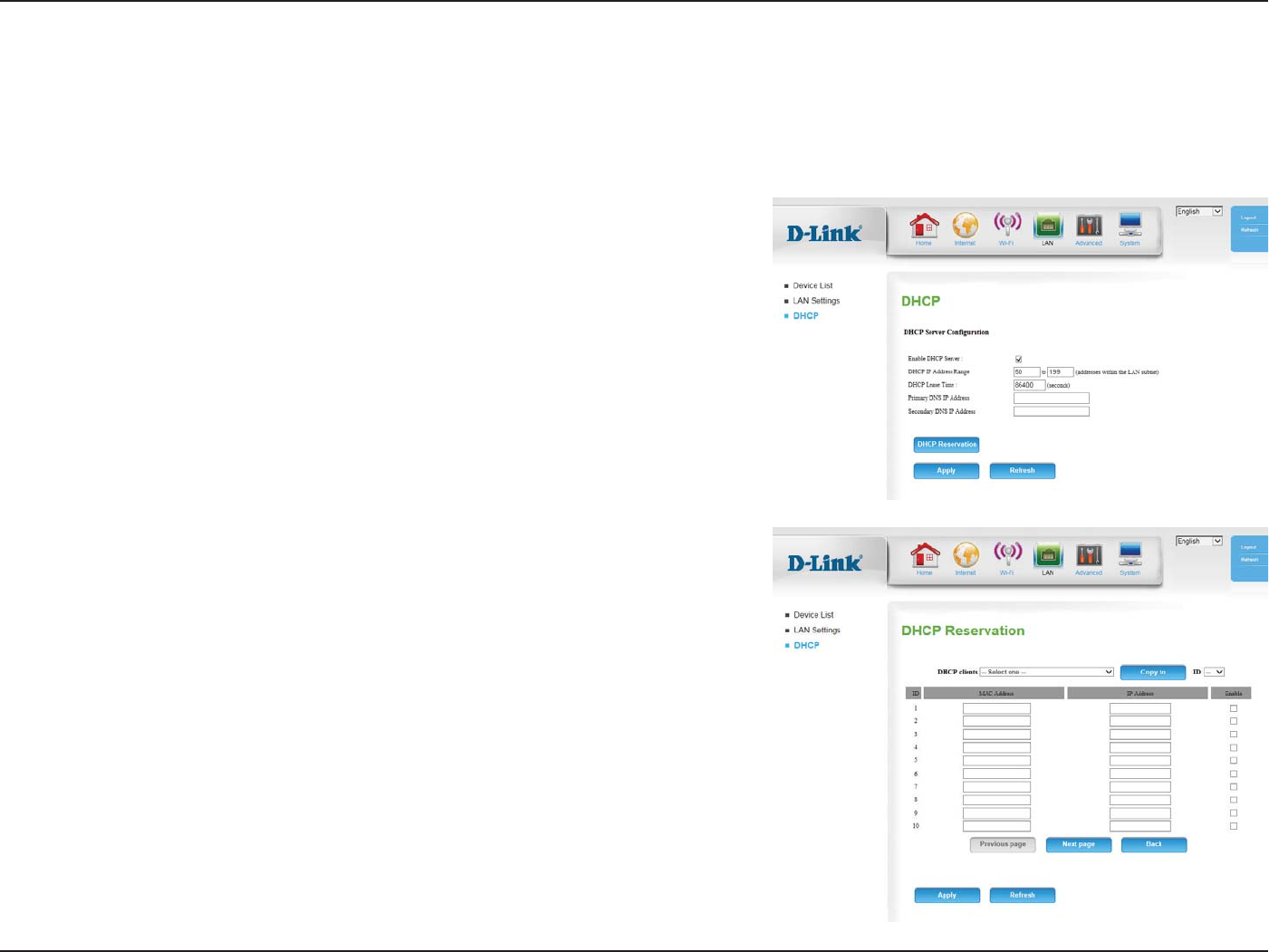
40D-Link DWR-9User Manual
Section 4 - Conguration
DHCP
Select this box to enable the DHCP server on your router.
Enter the range of IPs for the DHCP server to use to assign IP
addresses to devices on your network. These values will represent
the last octet of the IP addresses in the pool.
Enter the lease time for IP address assignments.
Enter the primary DNS IP address that will be assigned to DHCP
clients.
Enter the secondary DNS IP address that will be assigned to DHCP
clients.
Click DHCP Reservation to assign a dedicated IP to a specied
MAC address to be saved by the DHCP server. The Fixed Mapping
page will appear.
Select a DHCP client and click Copy to, or enter the MAC address
and IP address manually, to assign the IP address to the MAC
address. Click Enable to enable the rule.
Click Apply to save your settings, or Refresh to revert to your
previous settings.
Enable DHCP
Server:
DHCP IP Address
Range:
DHCP Lease Time:
Primary DNS IP
Address:
Secondary DNS IP
Address:
DHCP
Reservation:
The DWR-9 has a built-in DHCP (Dynamic Host Control Protocol) server. The DHCP server assigns IP addresses to devices on the network that
request them. By default, the DHCP Server is enabled on the device. The DHCP address pool contains a range of IP addresses, which are automatically
assigned to the clients on the network.
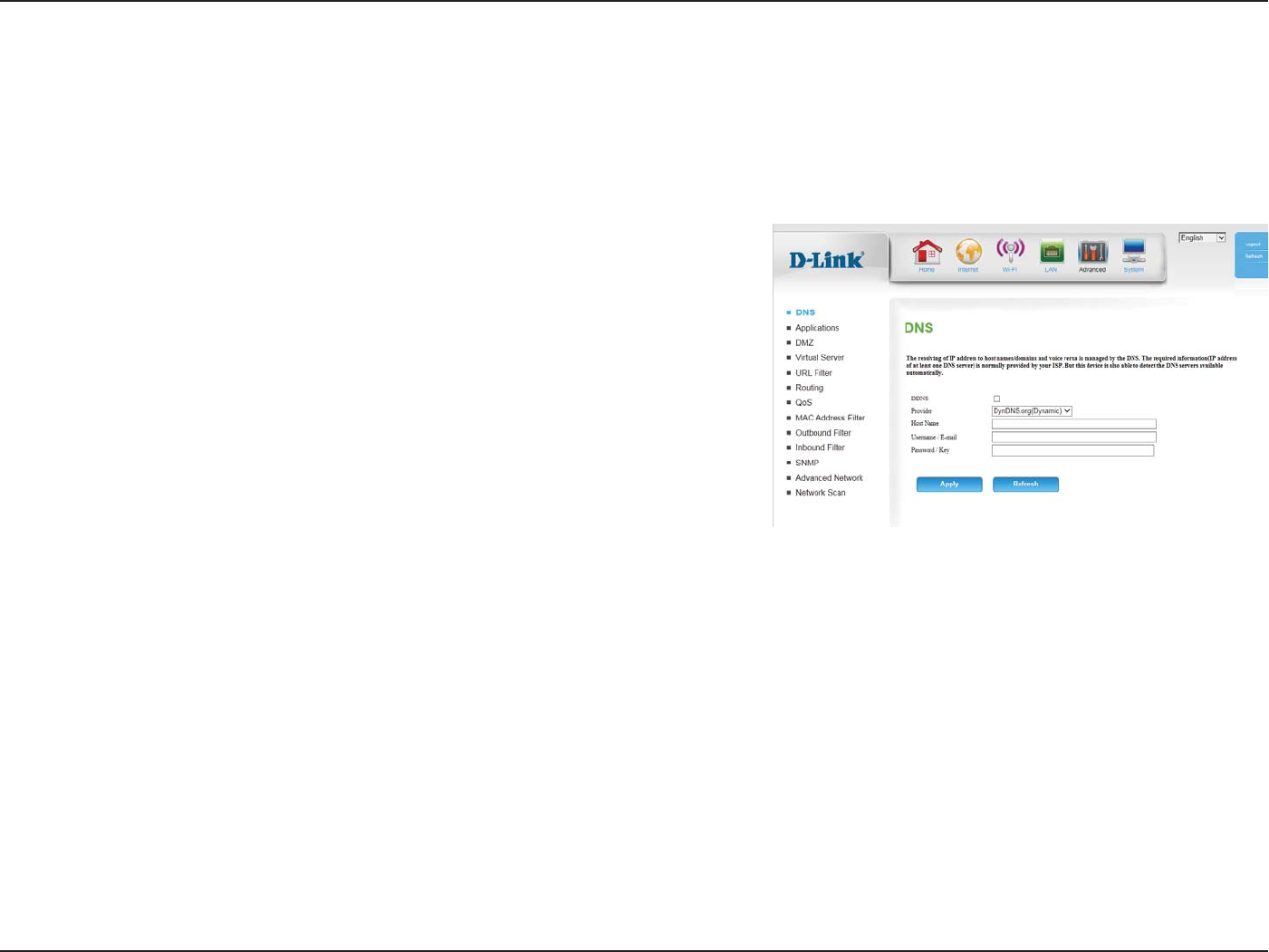
41D-Link DWR-9 User Manual
Section 4 - Conguration
Advanced
DNS
Tick this checkbox to enable the DDNS feature.
Select a DDNS service provider to use.
Enter the Host Name that you registered with your DDNS service
provider.
Enter the Username for your DDNS account.
Enter the Password for your DDNS account.
Click Apply to save your settings, or Refresh to revert to your
previous settings.
DDNS:
Provider:
Host Name:
Username /
E-mail:
Password / Key:
On this page you can congure the Domain Name System (DNS) server, which manages the resolution of host/domain names to IP addresses.
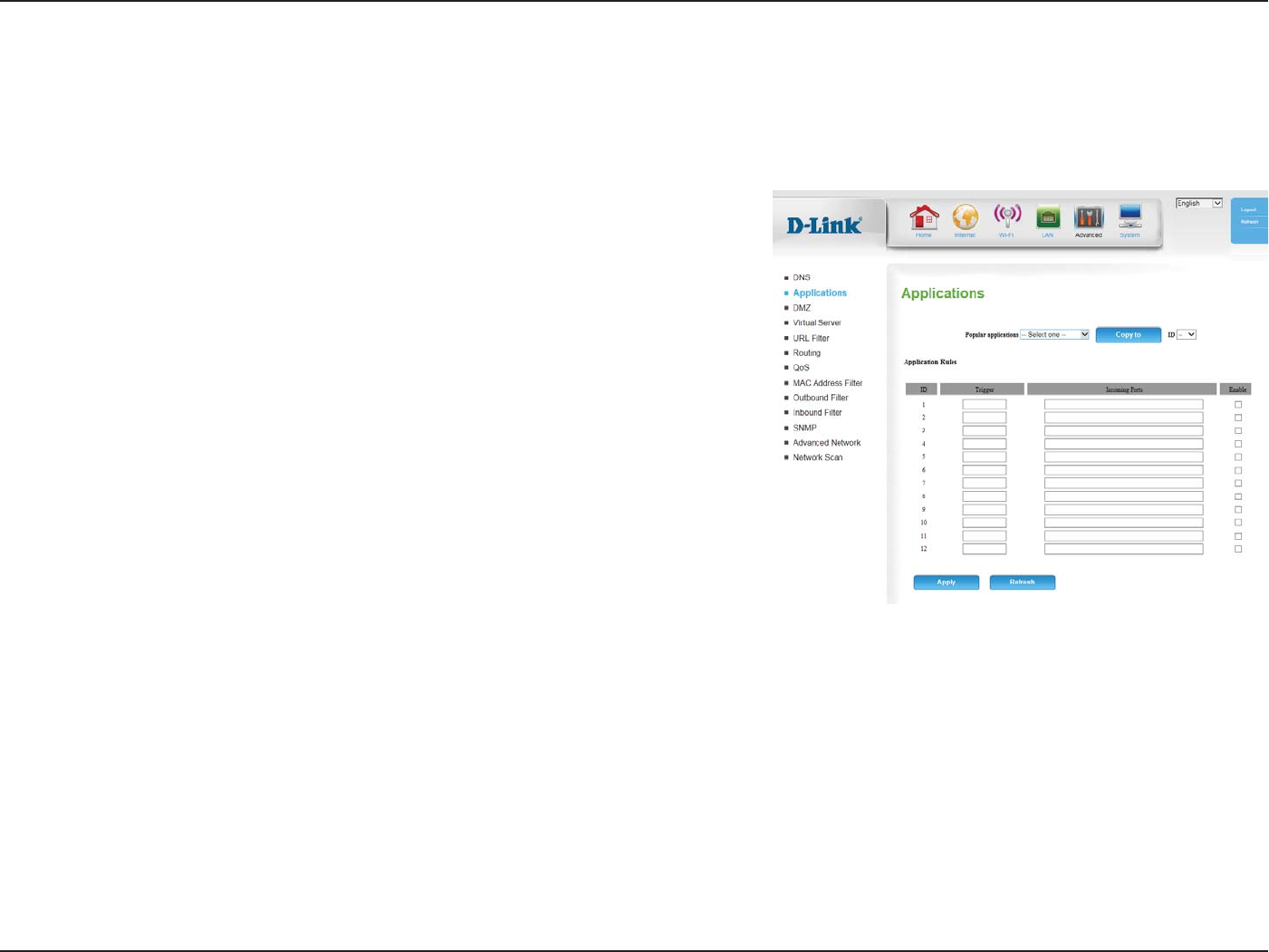
42D-Link DWR-9 User Manual
Section 4 - Conguration
Some applications require multiple connections, such as Internet gaming, video conferencing, and Internet telephony. These applications may
have diculty working through NAT (Network Address Translation). Applications allows some of these applications to work with the DWR-9 by
opening ports after detecting trac being sent through a trigger port.
Select from a list of popular applications. You can select a service,
select a rule ID, then click the Copy to button to copy the default
settings for that service to the specied rule ID.
Species which rule to copy the selected Popular applications
settings to when you click the Copy to button.
APPLICATION RULES
This identies the rule.
Enter the port to listen to in order to trigger the rule.
Specify the incoming port(s) to open when trac comes over the
Trigger port.
Check the box to enable the specied rule.
Click Apply to save your settings, or Refresh to revert to your
previous settings.
Popular
Applications:
ID:
ID:
Trigger:
Incoming Ports:
Enable:
Applications
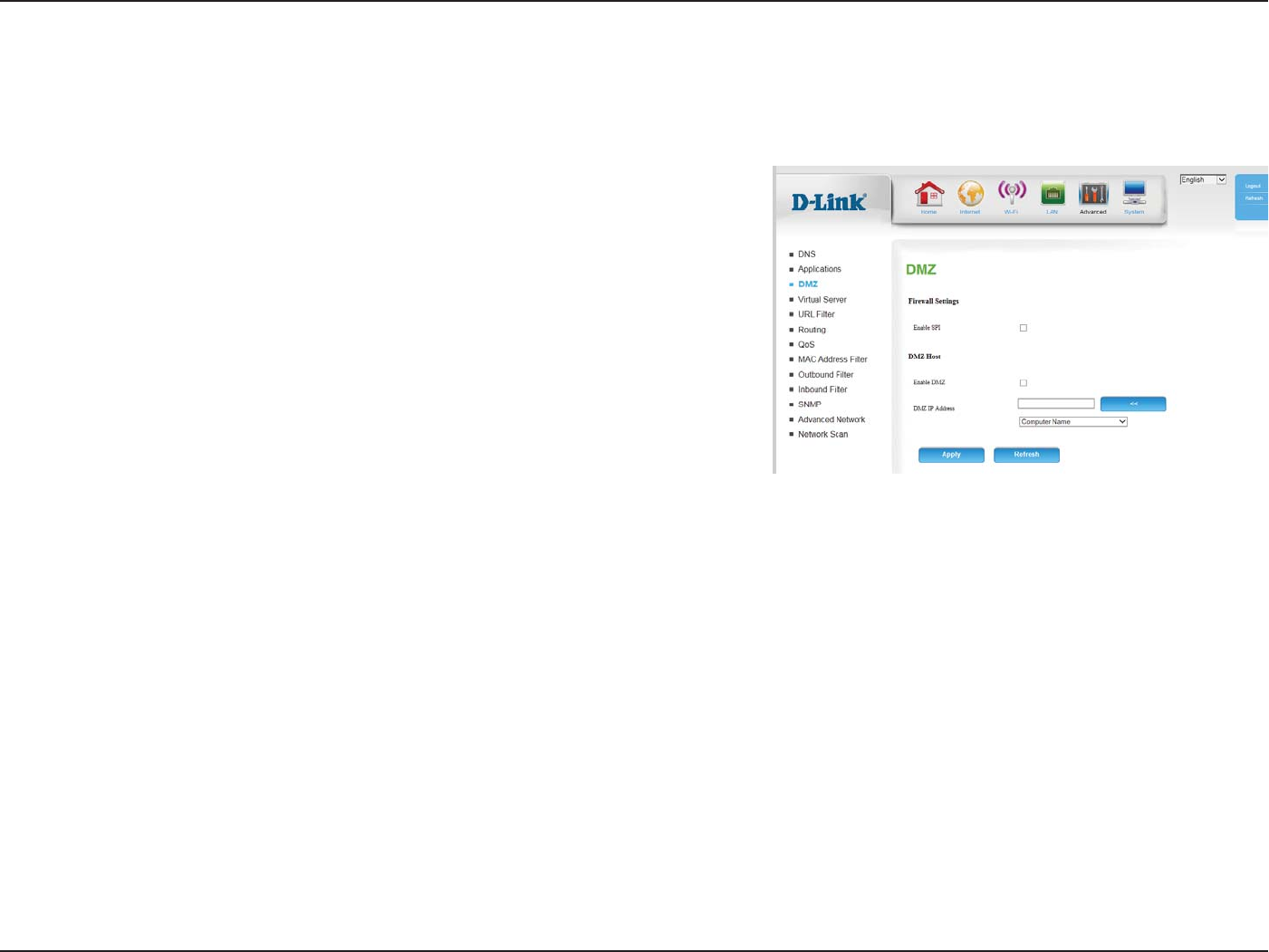
43D-Link DWR-9 User Manual
Section 4 - Conguration
Sometimes you may want a computer exposed to the Internet for certain types of applications. If you choose to expose a computer, you can enable
Demilitarized Zone (DMZ). This option will expose the chosen computer completely to the Internet. This is not recommended for normal use.
Enabling Stateful Packet Inspection (SPI) helps to prevent cyber
attacks by validating that the trac passing through the session
conforms to the protocol.
If an application has trouble working from behind the router, you
can expose one computer to the Internet and run the application
on that computer.
Note: Placing a computer in the DMZ may expose that
computer to a variety of security risks. Use of this option is only
recommended as a last resort.
Specify the IP address of the computer on the LAN that you want
to have unrestricted Internet communication. If this computer
obtains its IP address automatically using DHCP, be sure to make
a static reservation on the LAN > DHCP > DHCP Reservervation
page so that the IP address of the DMZ machine does not change.
Click Apply to save your settings, or Refresh to revert to your
previous settings.
Enable SPI:
Enable DMZ:
DMZ IP Address:
DMZ
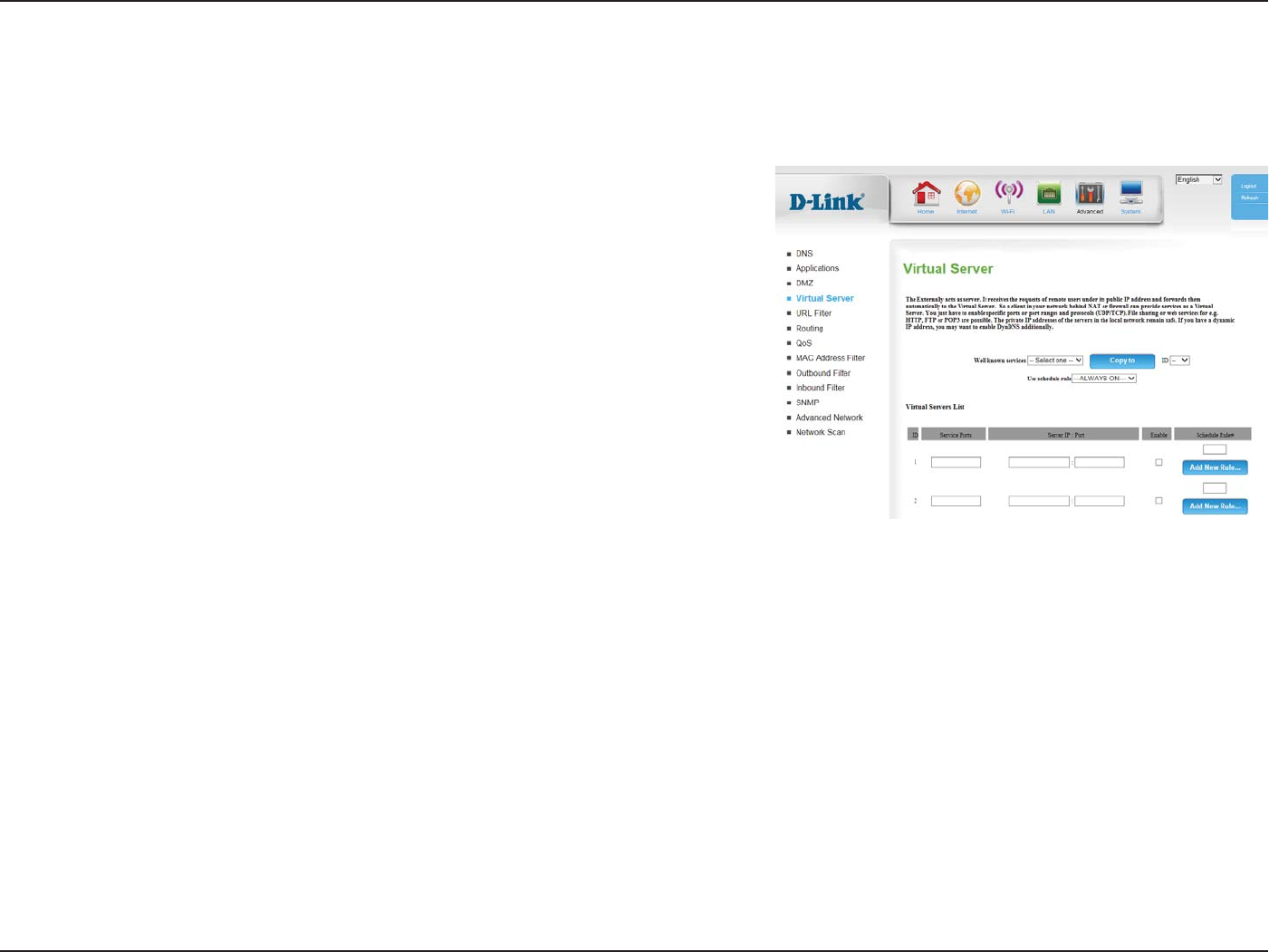
44D-Link DWR-9 User Manual
Section 4 - Conguration
The device can be congured as a virtual server so that users can access services such as Web or FTP via the public (WAN) IP address of the router.
You can also allow the settings to run on a specied schedule.
This contains a list of pre-dened services. You can select a service,
select a rule ID, then click the Copy to button to copy the default
settings for that service to the specied rule ID.
Species which rule to copy the selected Well known service
settings to when you click the Copy to button.
Select a schedule to use and copy to the specied rule ID when
you click the Copy to button. You may select Always On or use
a specic schedule that you have dened. To create and edit
schedules, please refer to Schedules on page 59.
Well-known
Services:
ID:
Use schedule
rule:
VIRTUAL SERVERS LIST
This identies the rule.
Enter the public port(s) you want to open.
Enter the IP address and port of the computer on your local
network that you want to forward the Service Ports to.
Check the box to enable the specied rule.
Specify the schedule rule number. To create schedules, click on
the Add New Rule button. For further information on schedules,
please refer to Schedules on page 59.
Click Apply to save your settings, or Refresh to revert to your
previous settings.
ID:
Service Ports
Server IP: Port:
Enable:
Schedule Rule #:
Virtual Server
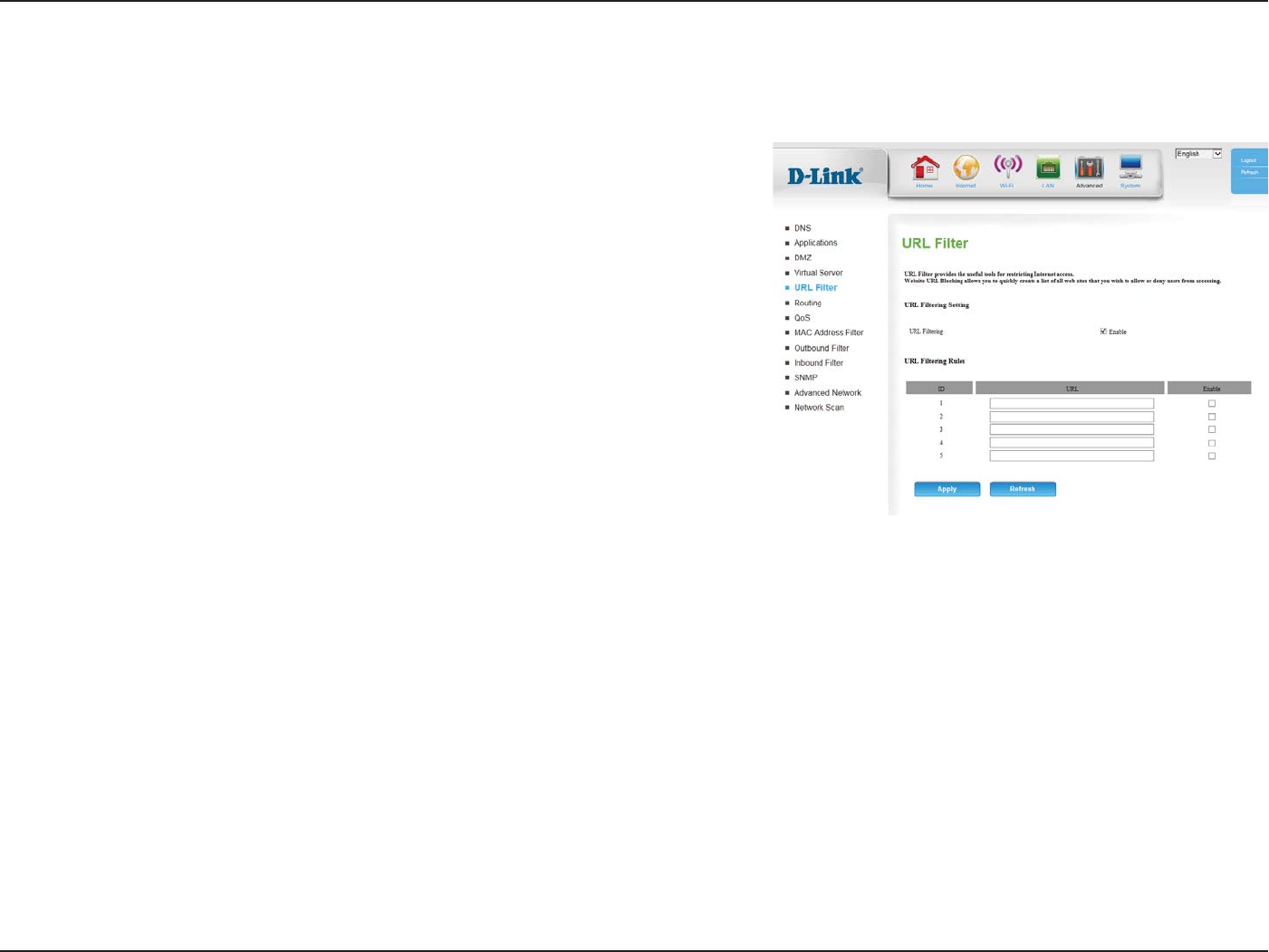
45D-Link DWR-9 User Manual
Section 4 - Conguration
Check the box to enable URL Filtering.
URL FILTERING RULES
This identies the rule.
Enter URL that you would like to block. All URLs that begin with
this address will be blocked.
Check the box to enable the specied rule.
Click Apply to save your settings, or Refresh to revert to your
previous settings.
URL Filter allows you to set up a list of websites that will be blocked from users on your network.
URL Filtering:
ID:
URL:
Enable:
URL Filter
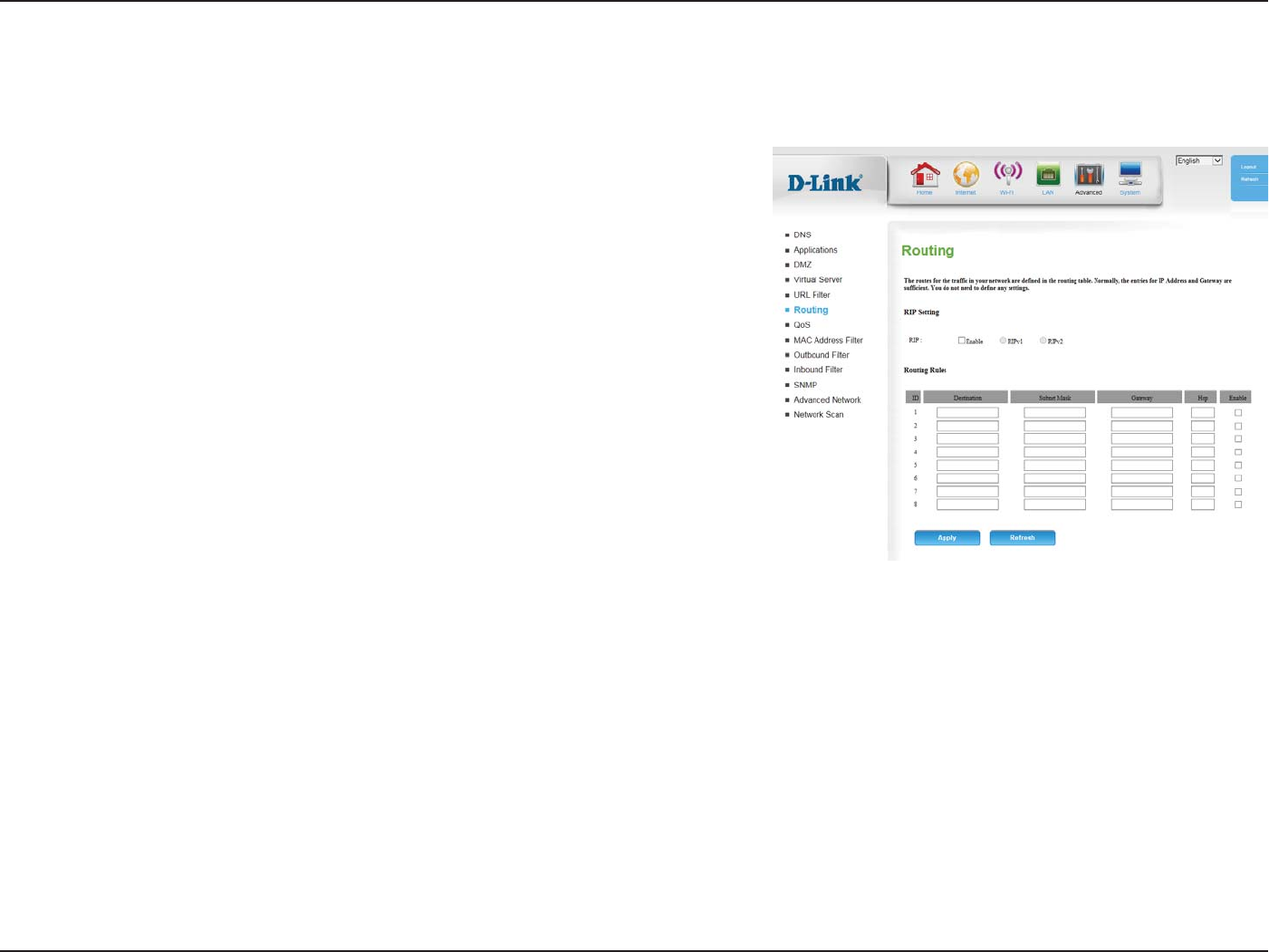
46D-Link DWR-9 User Manual
Section 4 - Conguration
Check the box to enable routing, then select which routing
protocol to use:
• RIPv1: Protocol in which the IP address is routed
through the Internet.
• RIPv2: Enhanced version of RIPv1 with added
features such as authentication, routing domain, next
hop forwarding, and subnet-mask exchange.
RIP:
The Routing page allows you to specify custom routes that determine how data is moved around your network.
ROUTING RULES
This identies the rule.
Enter in the IP of the specied network that you want to access
using the static route.
Enter in the subnet mask to be used for the specied network.
Enter in the gateway IP address for the specied network.
Enter in the amount of hops it will take to reach the specied
network.
Note: In a transmission path, each link is terminated at a network
device such as a router or gateway. The number of hops equals
the number of routers or gateways that data must pass through
before reaching the destination.
Select this box to enable the rule.
Click Apply to save your settings, or Refresh to revert to your
previous settings.
ID:
Destination:
Subnet Mask:
Gateway:
Hop:
Enable:
Routing
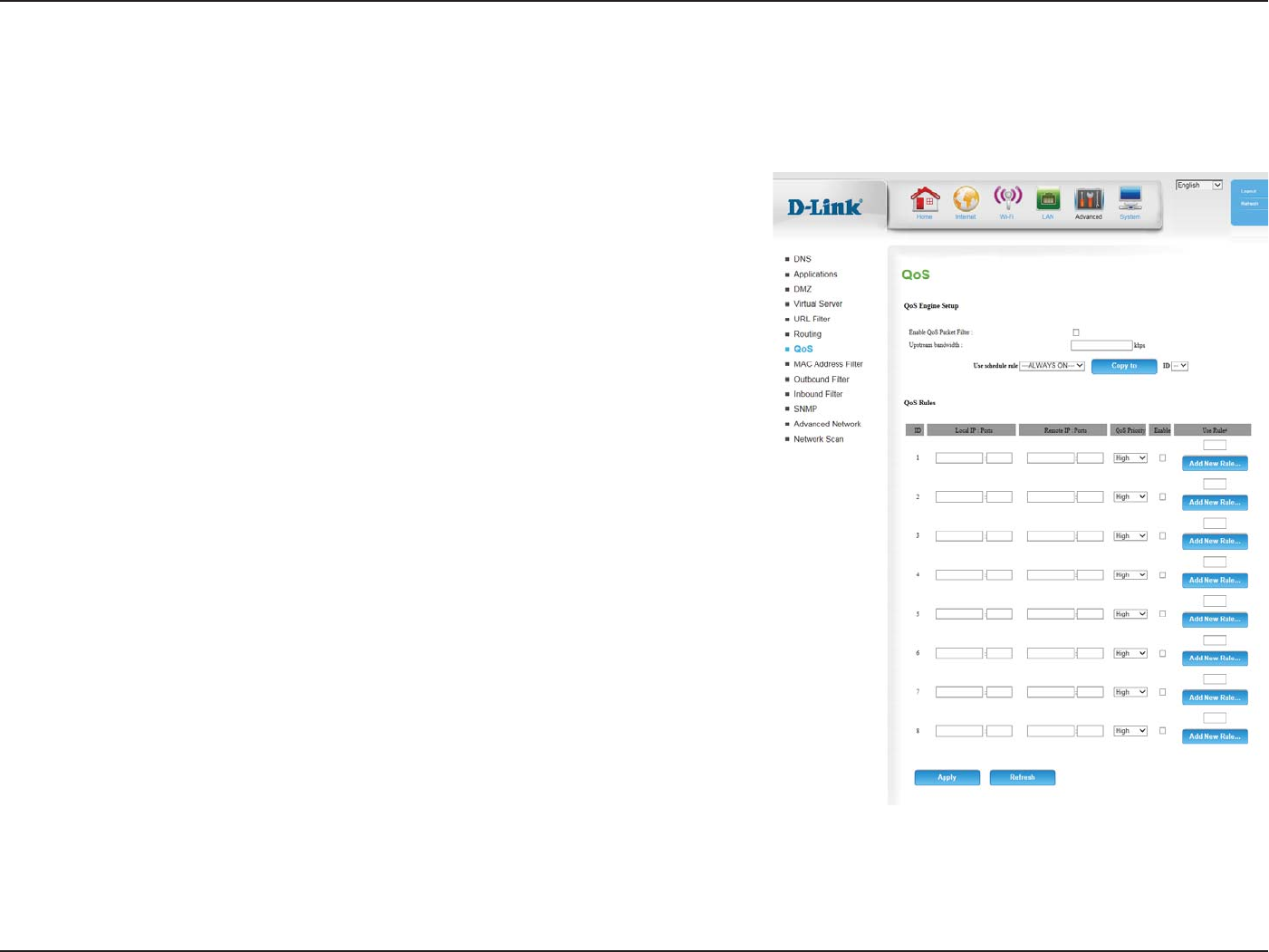
47D-Link DWR-9 User Manual
Section 4 - Conguration
Select this box to enable the QoS feature.
Specify the maximum upstream bandwidth here (e.g. 400 Kbps).
Select a schedule to use and copy to the specied rule ID when
you click the Copy to button. You may select Always On or use
a specic schedule that you have dened. To create and edit
schedules, please refer to Schedules on page 59.
QOS RULES
This identies the rule.
Specify the local IP address(es) and port(s) for the rule to aect.
Specify the remote IP address(es) and port(s) for the rule to aect.
Select what priority level to use for trac aected by the rule:
Low, Normal, or High.
Check the box to enable the specied rule.
Specify the schedule rule number. To create a new schedule,
click on the Add New Rule button. For more information about
schedules, please refer to Schedules on page 59.
Click Apply to save your settings, or Refresh to revert to your
previous settings.
Enable QOS
Packet Filter:
Upstream
Bandwidth:
Use Schedule
Rule:
ID:
Local IP : Ports:
Remote IP : Ports:
QoS Priority:
Enable:
Use Rule #:
The QoS Engine improves your online gaming or streaming media experience by ensuring that your game or media trac is prioritized over other
network trac, such as FTP or web.
QoS
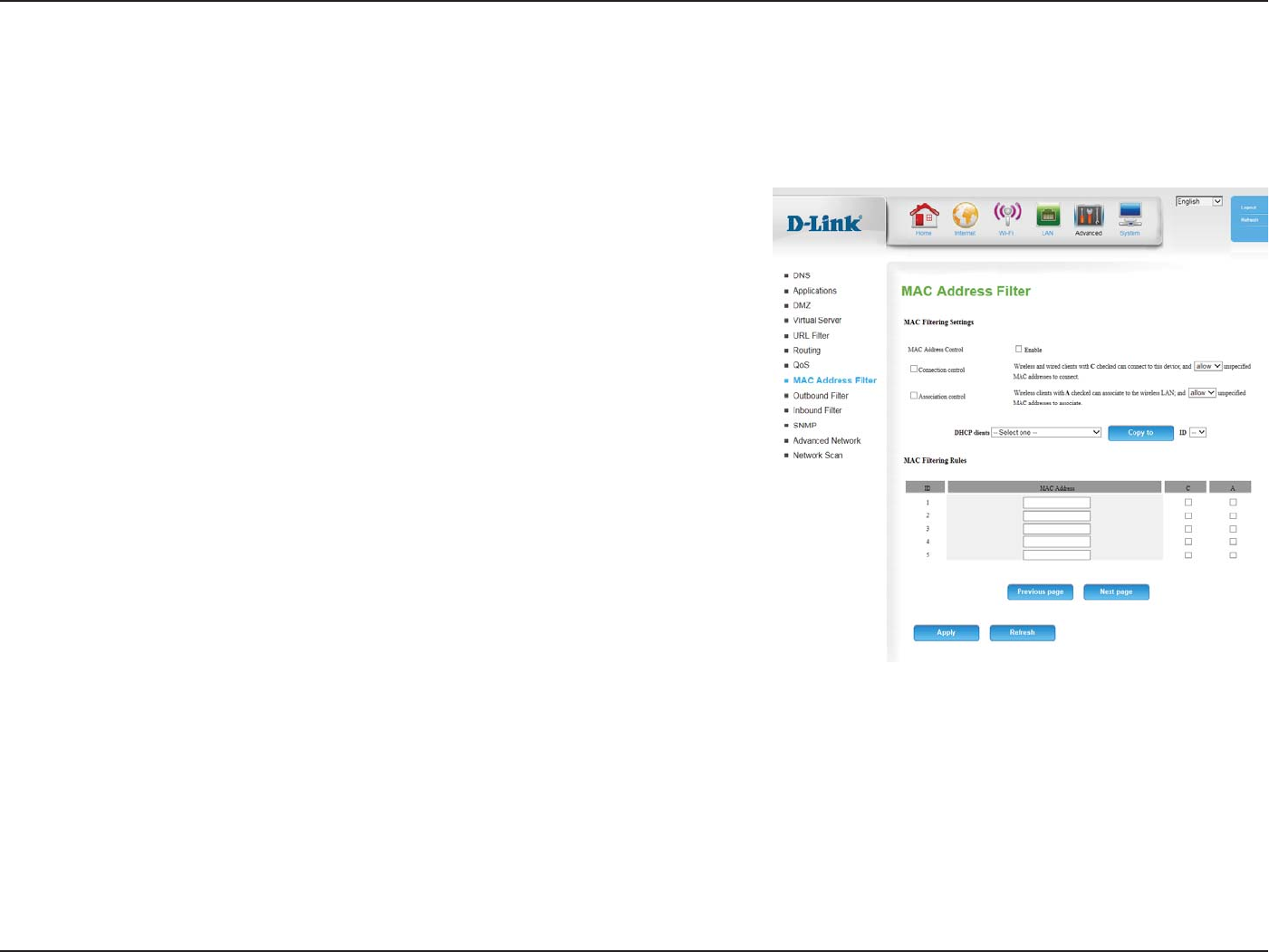
48D-Link DWR-9 User Manual
Section 4 - Conguration
Check this box to enable MAC Filtering.
Check the box to allow wireless and wired clients with C selected
to connect to this device. You can also select to allow or deny
connections from unspecied MAC addresses.
Check the box to allow wireless clients with A selected can
associate to the wireless LAN. You can also select to allow or deny
connections from unspecied MAC addresses.
MAC FILTERING RULES
This identies the rule.
Specify the MAC address of the computer to be ltered.
Specify the last section of the IP address.
If this box is ticked, the rule will follow the connection control
setting specied in MAC ltering settings specied above.
If this box is ticked, the rule will follow the association control
setting specied in MAC ltering settings specied above.
Click Apply to save your settings, or Refresh to revert to your
previous settings.
MAC Address
Control:
Connection
Control:
Association
Control:
ID:
MAC Address:
IP Address:
C:
A:
The MAC (Media Access Controller) Address Filter option is used to control network access based on the MAC address of the network adapter.
A MAC address is a unique ID assigned by the manufacturer of the network adapter. This feature can be congured to ALLOW or DENY network/
Internet access.
MAC Address Filter
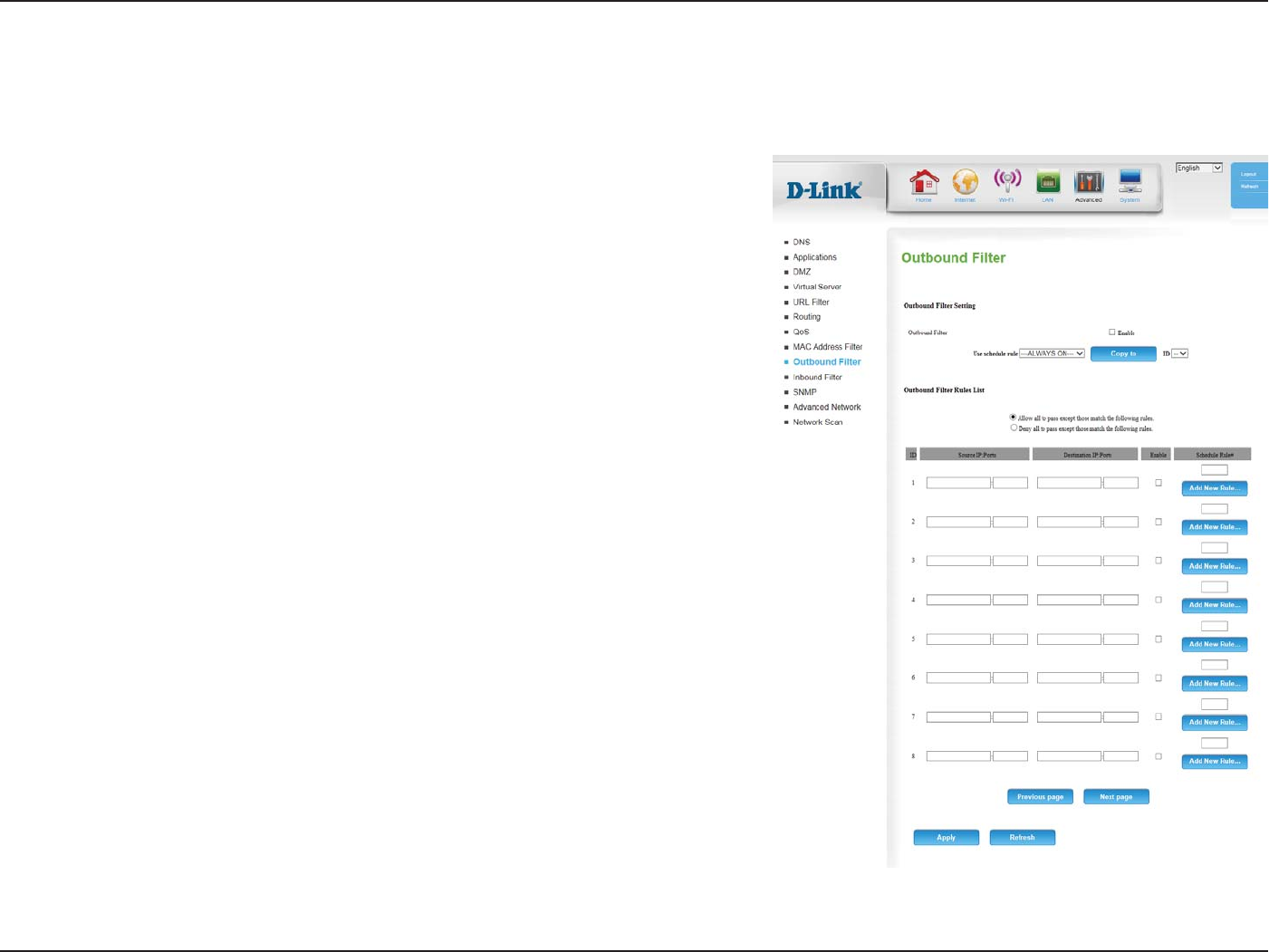
49D-Link DWR-9 User Manual
Section 4 - Conguration
Select this box to Enable outbound ltering.
Select a schedule to use and copy to the specied rule ID when
you click the Copy to button. You may select Always On or use
a specic schedule that you have dened. To create and edit
schedules, please refer to Schedules on page 59.
OUTBOUND FILTER RULES LIST
Here, you can select whether to Allow or Deny all outgoing trac
except for trac that matches the listed rules.
This identies the rule.
Specify the local IP address and then specify the port after the
colon.
Specify the remote IP address and then the port after the colon.
Check the box to enable the specied rule.
Specify the schedule rule number. Click on the Add New Rule
button to create a new schedule rule.
Go back to the previous lter page.
Advance to the next lter page.
Click Apply to save your settings, or Refresh to revert to your
previous settings.
Outbound Filter:
Use Schedule Rule:
ID:
Source IP : Ports:
Destination IP :
Ports:
Enable:
Schedule Rule #:
Previous Page:
Next Page:
Outbound Filter enables you to control what packets are allowed to be sent out to the Internet. The outbound lter applies to all outbound packets.
Outbound Filter
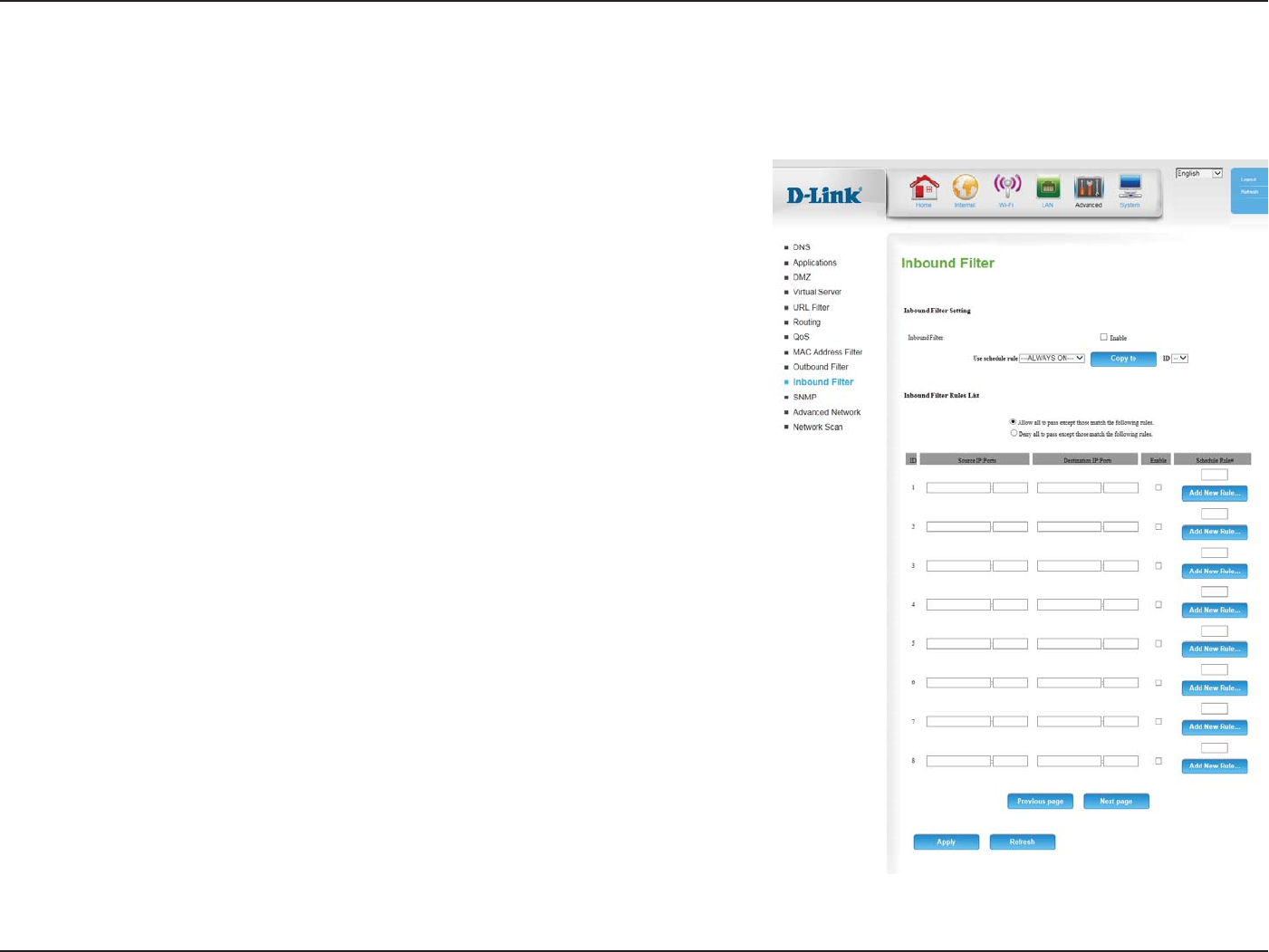
50D-Link DWR-9 User Manual
Section 4 - Conguration
Select this box to Enable the lter.
Select a schedule to use and copy to the specied rule ID when
you click the Copy to button. You may select Always On or use
a specic schedule that you have dened. To create and edit
schedules, please refer to Schedules on page 59.
INBOUND FILTER RULES LIST
Here, you can select whether to Allow or Deny all incoming trac
except for trac that matches the listed rules.
This identies the rule.
Specify the local IP address and then specify the port after the
colon.
Specify the remote IP address and then the port after the colon.
Check the box to enable the specied rule.
Specify the schedule rule number. Click on the Add New Rule
button to create a new schedule rule.
Go back to the previous lter page.
Advance to the next lter page.
Click Apply to save your settings, or Refresh to revert to your
previous settings.
Inbound Filter:
Use Schedule
Rule:
ID:
Source IP : Ports:
Destination IP :
Ports:
Enable:
Schedule Rule #:
Previous Page:
Next Page:
Inbound Filter enables you to control what packets are allowed to come in to your network from the Internet. The inbound lter only applies to
packets that are destined for Virtual Servers or DMZ hosts.
Inbound Filter
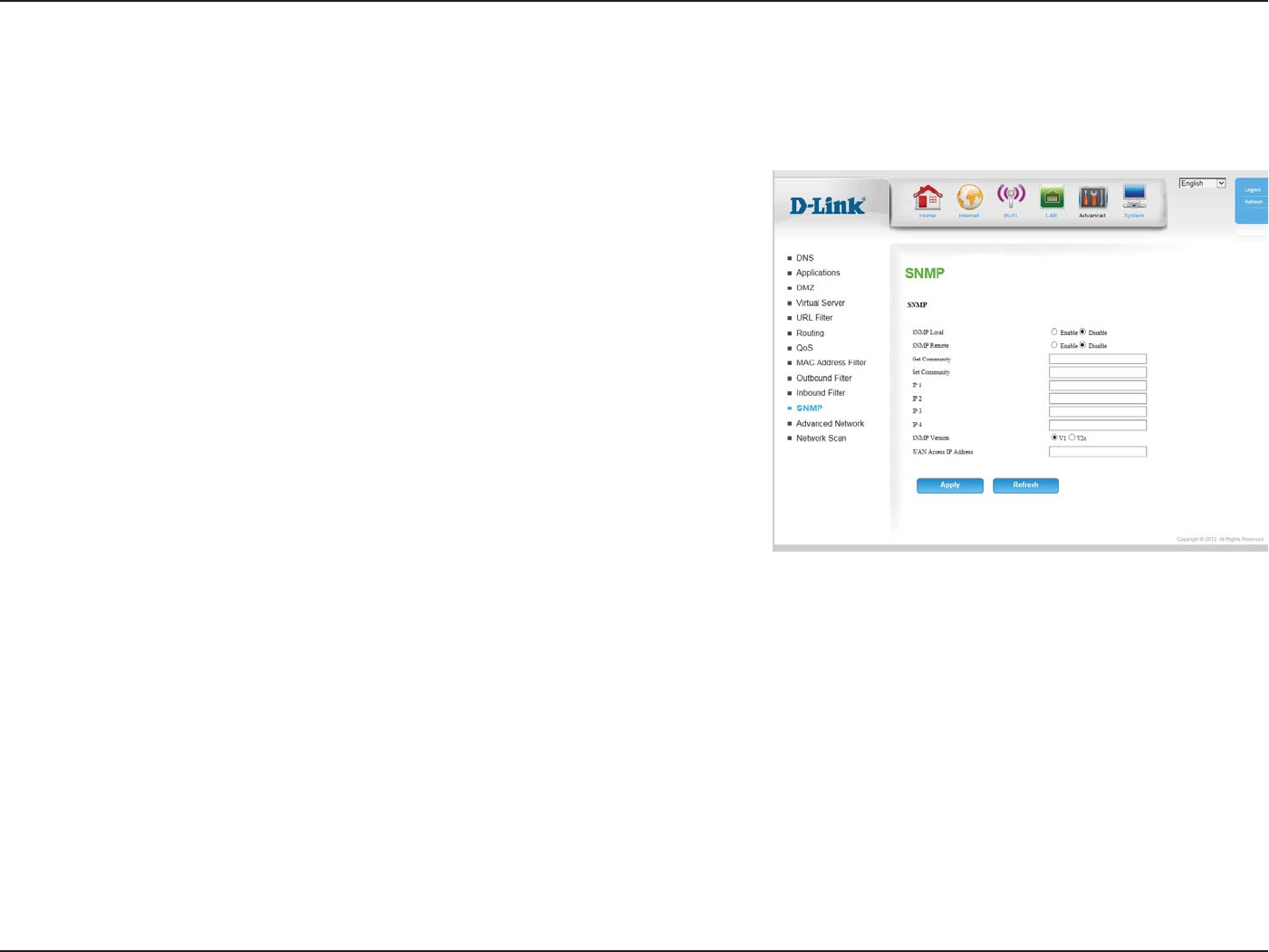
51D-Link DWR-9 User Manual
Section 4 - Conguration
Select whether to Enable or Disable local SNMP administration.
Select whether to Enable or Disable remote SNMP administration.
Enter the password public in this eld to allow read-only access
to network administration using SNMP. You can view the network,
but no conguration is possible with this setting.
Enter the password private in this eld to enable read/write
access to the network using SNMP.
Enter up to 4 IP addresses to use as trap targets for your network.
Select the SNMP version of your system.
If you want to limit remote access SNMP access, enter the IP
address of the remote computer you will use to access this device;
all other IP addresses will be denied remote SNMP access.
Click Apply to save your settings, or Refresh to revert to your
previous settings.
SNMP Local:
SNMP Remote:
Get Community:
Set Community:
IP 1/IP 2/IP 3/IP 4:
SNMP Version:
WAN Access
IP Address
SNMP (Simple Network Management Protocol) is a widely used network monitoring and control protocol that reports activity on each network device
to the administrator of the network. SNMP can be used to monitor trac and statistics of the DWR-9. The DWR-9 supports SNMP v1 and v2c.
SNMP
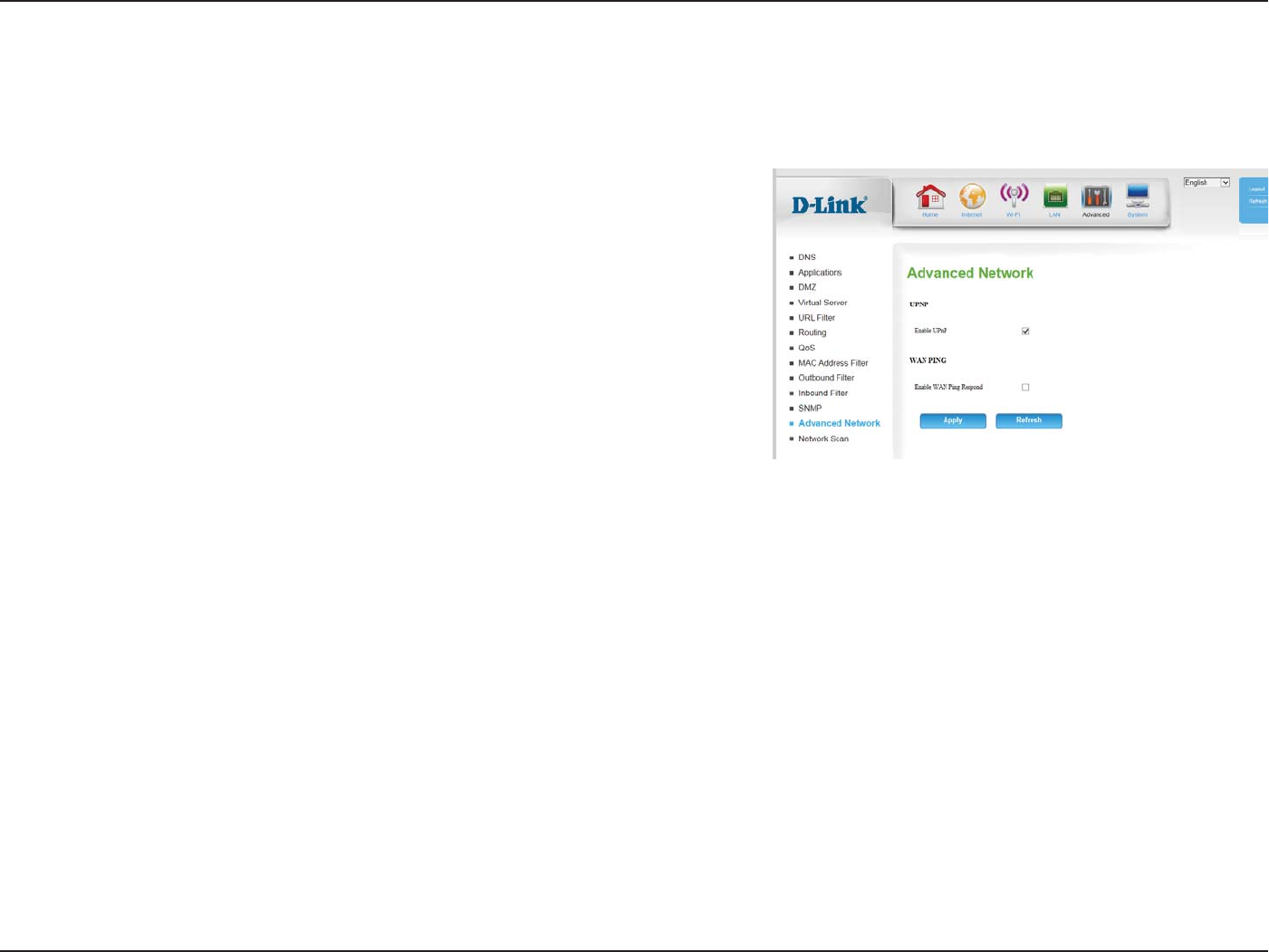
52D-Link DWR-9 User Manual
Section 4 - Conguration
Check the box to enable the Universal Plug and Play (UPnP™)
feature. UPNP provides compatibility with various networking
equipment, software, and peripherals.
Select the box to allow the WAN port to be “pinged.” Blocking WAN
pings may provide some extra security from hackers.
Click Apply to save your settings, or Refresh to revert to your
previous settings.
Advanced Network contains settings which can change the way the router handles certain types of trac. We recommend that you do not change
any of these settings unless you are already familiar with them or have been instructed to make the change by one of our support personnel.
Enable UPnP:
Enable WAN Ping
Respond:
Advanced Network
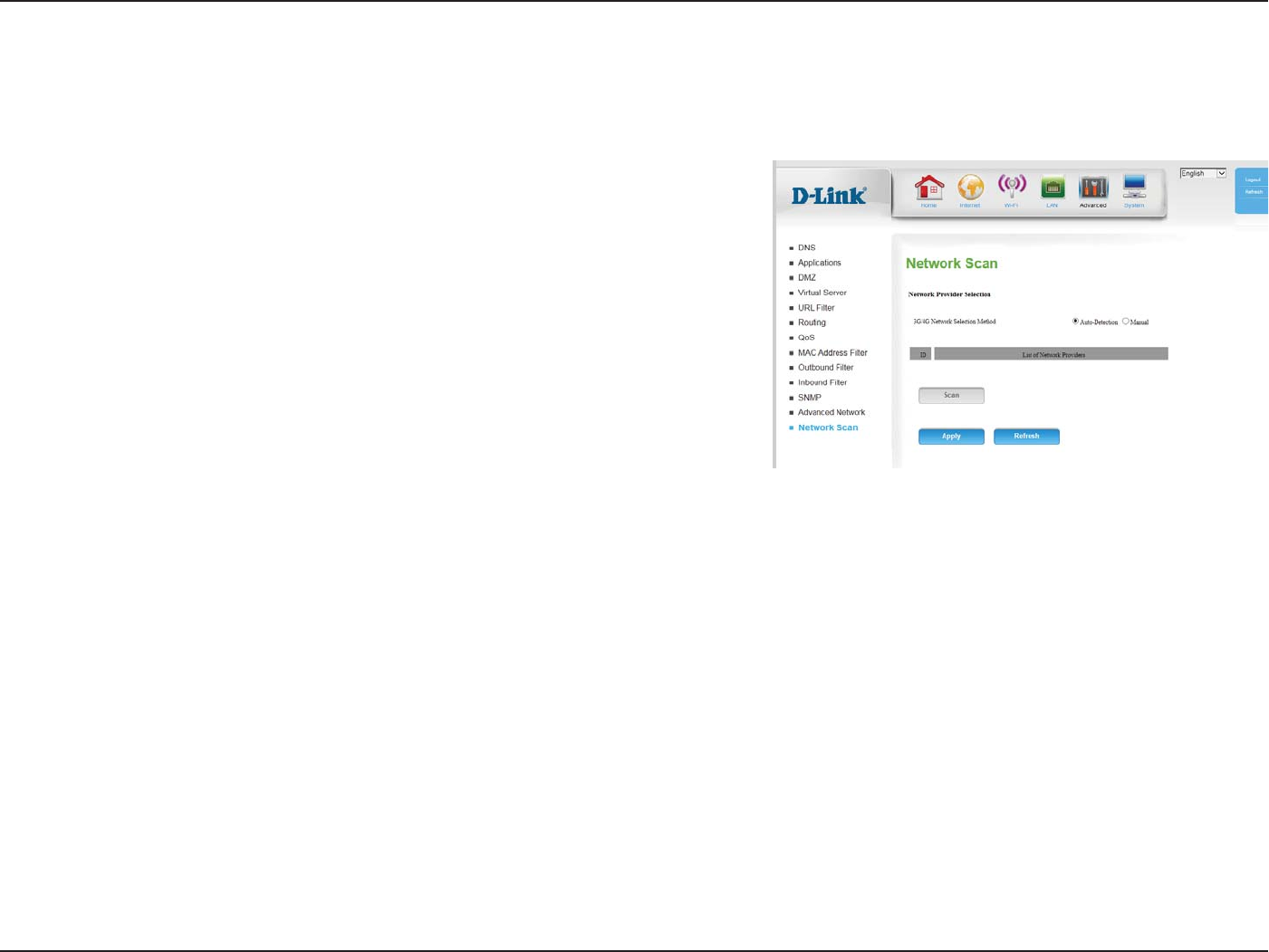
53D-Link DWR-9 User Manual
Section 4 - Conguration
Leave this setting on Auto to allow the DWR-9 to automatically
select a cellular network to connect to. If you need to select a
network manually, select Manual, click the Scan button, then
select an available network to connect to.
Note: You will only be able to scan for networks if the DWR-9 is
not currently connected to a 4G network.
Click Apply to save your settings, or Refresh to revert to your
previous settings.
This page lets you set whether to allow the DWR-9 to automatically select a 4G network based on the inserted SIM/UICC card, and allows you
to manually scan for networks and select one to connect to.
( Network
Selection
Method:
Network Scan
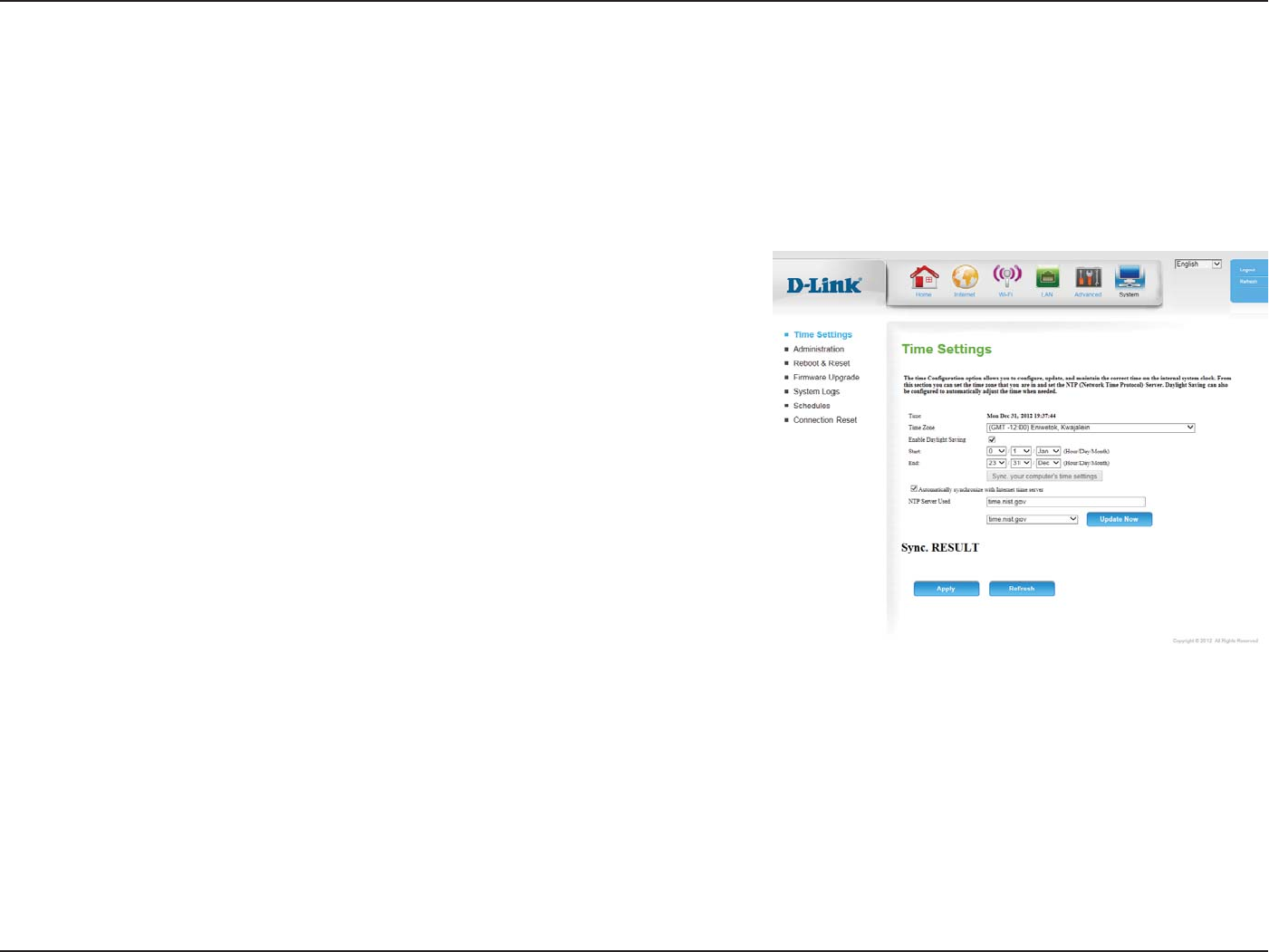
54D-Link DWR-9 User Manual
Section 4 - Conguration
Select the appropriate Time Zone from the drop-down box.
Check the box to allow for daylight saving adjustments. Use the
drop-down boxes to specify a start date and end date for daylight
saving time adjustments.
This button allows the router to set time zone and current time
based on your computer’s conguration. To use this setting,
ensure that Automatic Synchronization is unchecked and applied.
Check the box to allow the router to use an NTP server to update
the router’s internal clock.
Enter an NTP server to use for time synchronization, or use the
drop-down box to select one. Click the Update Now button to
synchronize the time with the NTP server.
Click Apply to save your settings, or Refresh to revert to your
previous settings.
This section will help you set the time zone that you are in and an NTP (Network Time Protocol) server to use. Daylight Saving can also be congured
to adjust the time when needed.
Time Zone:
Enable Daylight
Saving:
Sync your
computer’s time
settings:
Automatically
synchronize with
Internet time
server:
NTP Server Used:
System
Time Settings
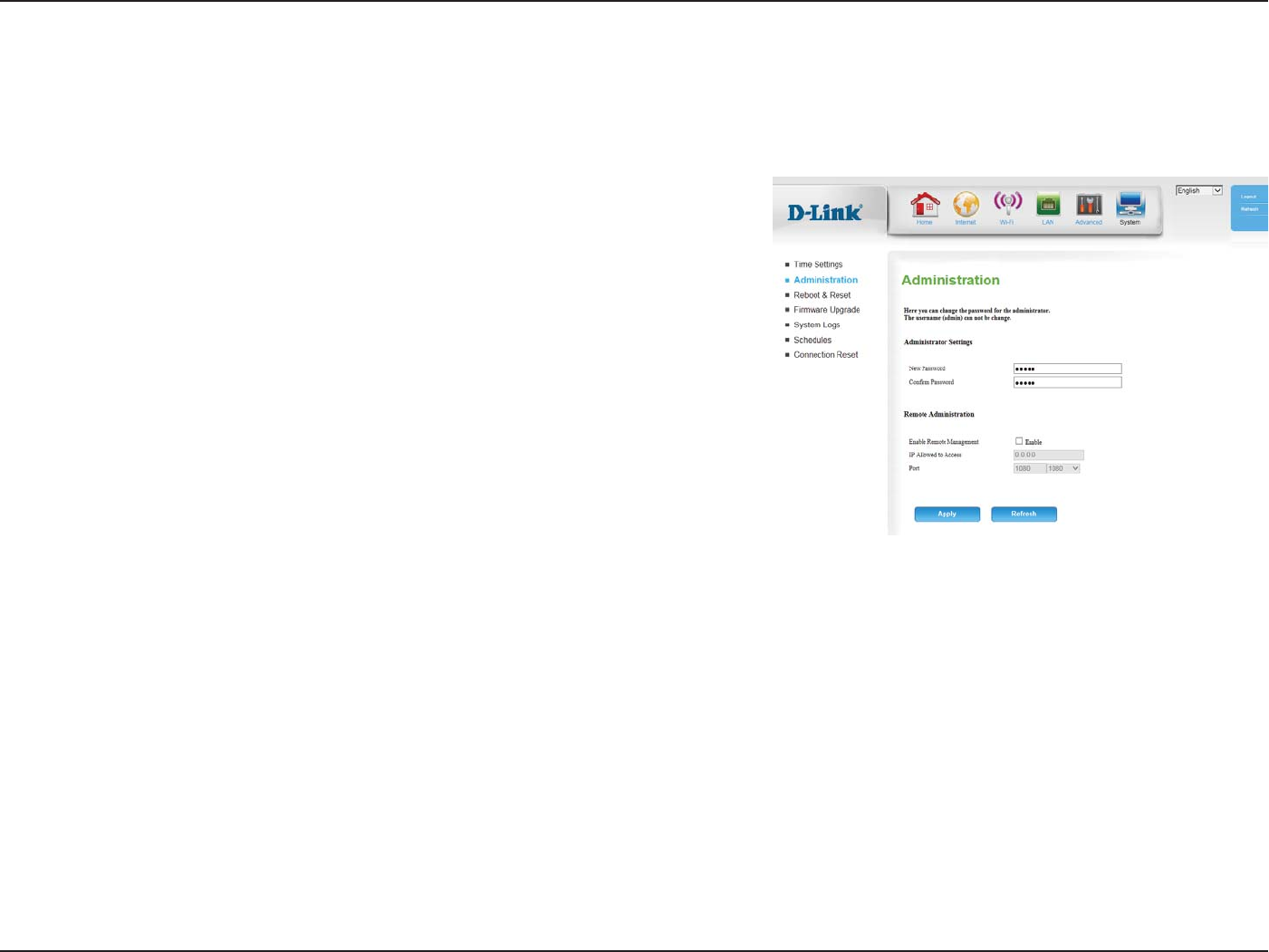
55D-Link DWR-9 User Manual
Section 4 - Conguration
Enter and conrm the password that the admin account will use to
access the router’s management interface.
Tick this check box to enable remote management. Remote
management allows the DWR-9 to be congured over the
Internet through a web browser. A username and password will
still be required to access the web-management interface.
Enter the Internet IP address of the PC that has access to the
broadband router. If you enter an asterisk (*) in this eld, then
anyone will be able to access the router. Adding an asterisk (*) into
this eld could present a security risk and is not recommended.
This is the port number used to access the router. 8080 is the port
usually used for the web-management interface.
Click Apply to save your settings, or Refresh to revert to your
previous settings.
The Admin page allows you to change the Administrator password and enable Remote Management. The admin has read/write access while users
only have read-only access. Only the admin has the ability to change both admin and user account passwords.
Admin Password:
Remote
Management:
IP Allowed to
Access:
Port:
Administration
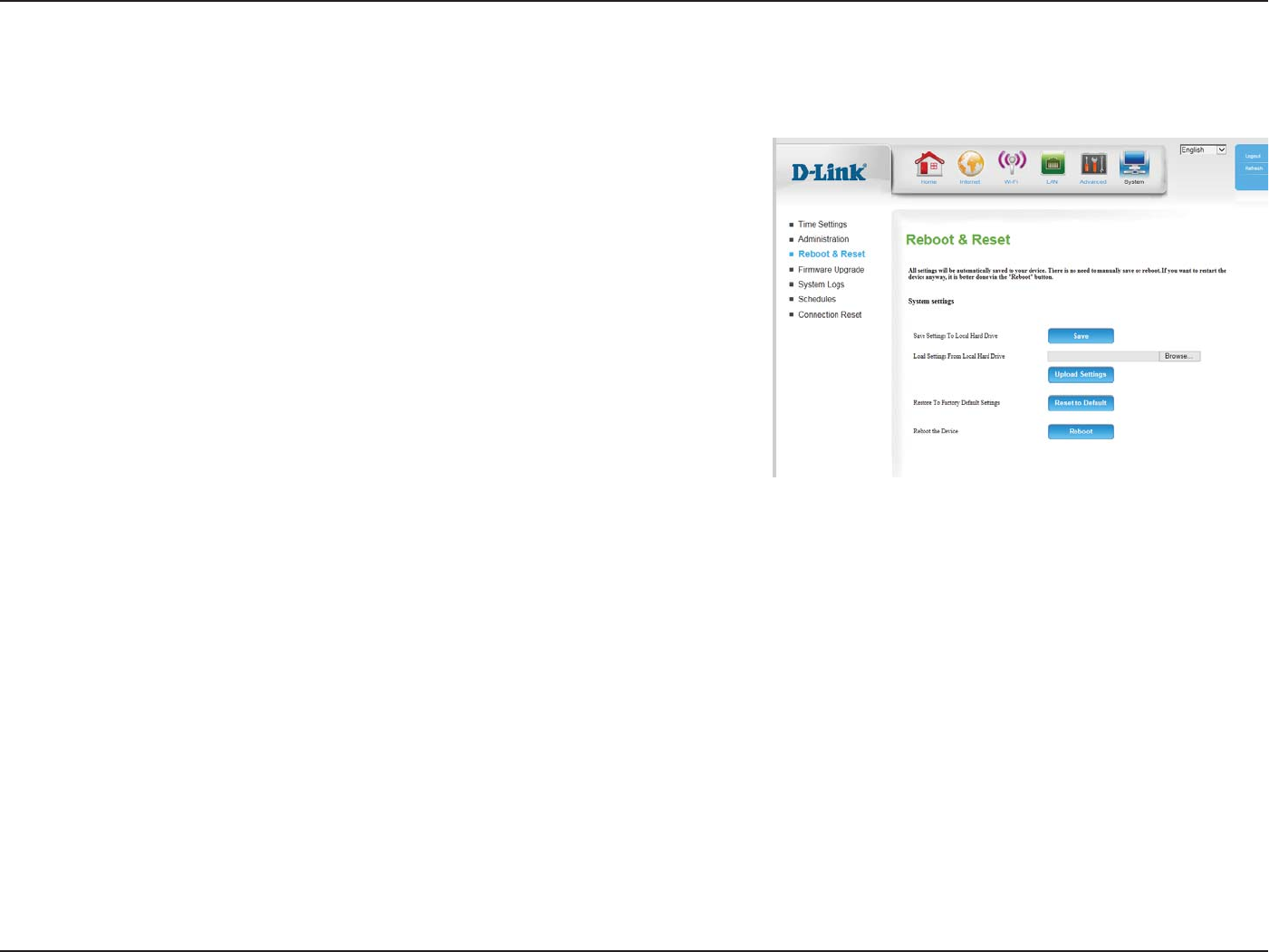
56D-Link DWR-9 User Manual
Section 4 - Conguration
Use this option to save your current router conguration settings
to a le. Click Save to open a le dialog, and then select a location
and le name for the settings.
Use this option to load previously saved router conguration
settings. Click Choose File and select the saved le and then click
the Upload Settings button to upload the settings to the router.
This option will restore all settings back to their defaults. Any
settings that have not been backed up will be lost, including any
rules that you have created.
This option will reboot the router.
Save Settings To
Local Hard Drive
Load Settings
From Local Hard
Drive:
Restore To Factory
Default Settings:
Reboot the
Device:
Here, you can save the current system settings to a local hard drive.
Reboot & Reset
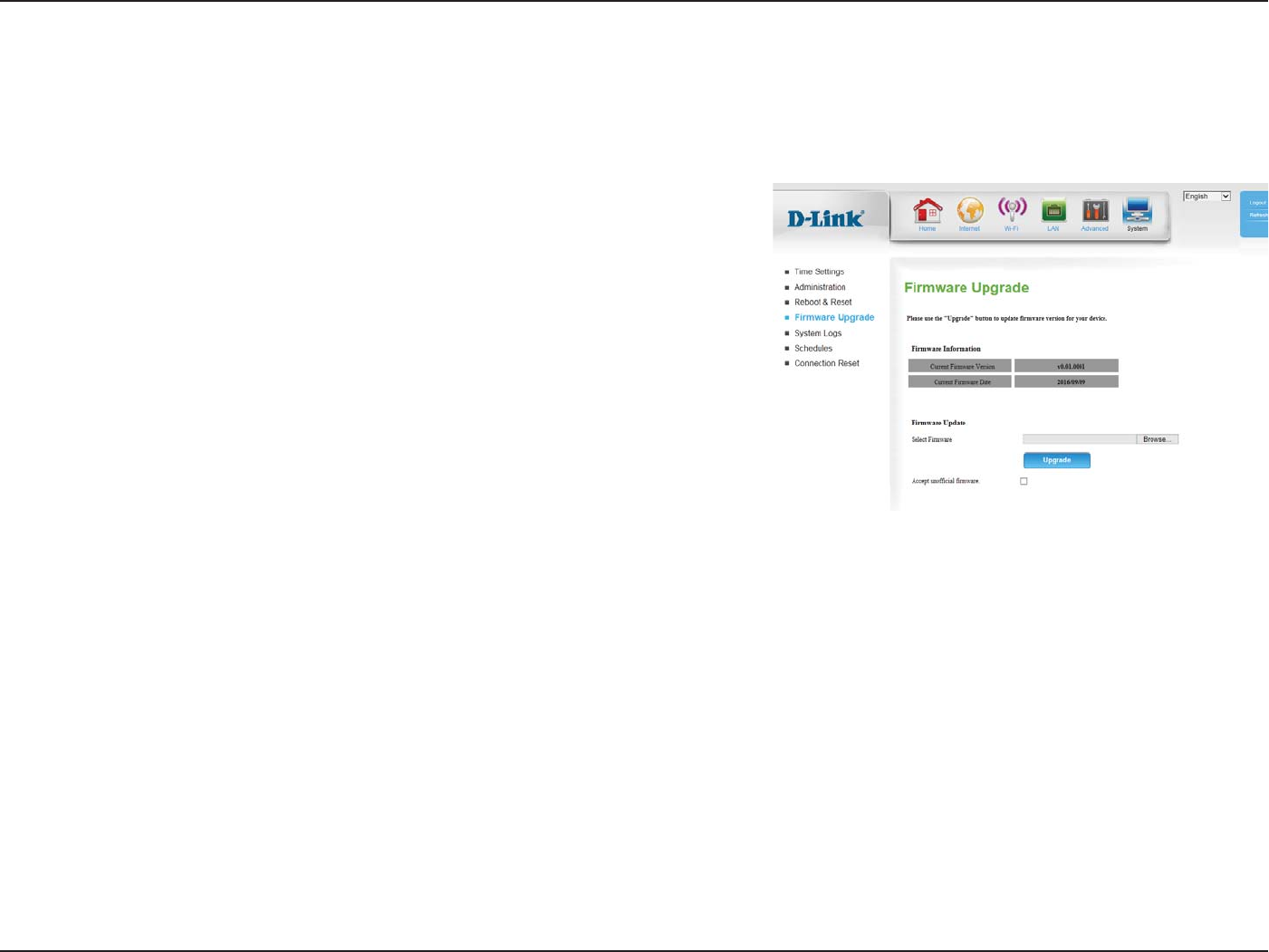
57D-Link DWR-9 User Manual
Section 4 - Conguration
Displays your current rmware’s version.
Displays your current rmware’s release date.
After you have downloaded a new rmware, click Browse to
locate the rmware on your computer, then click Upload to start
the rmware upgrade.
Warning: You must use a wired connection to upload the rmware
le; do not use a wireless connection. During the upgrade
process, do not power o your computer or router, and
do not refresh the browser window until the upgrade is
complete.
If the rmware you want to install is not an ocial D-Link release,
you will need to check this box.
Warning: Unocial rmware is not supported, and may cause
damage to your device. Use of unocial rmware is at
your own risk.
computer and then click Browse !
http://support.dlink.com.
Current Firmware
Version:
Current Firmware
Date:
Select Firmware:
Accept Unocial
Firmware:
Firmware Upgrade
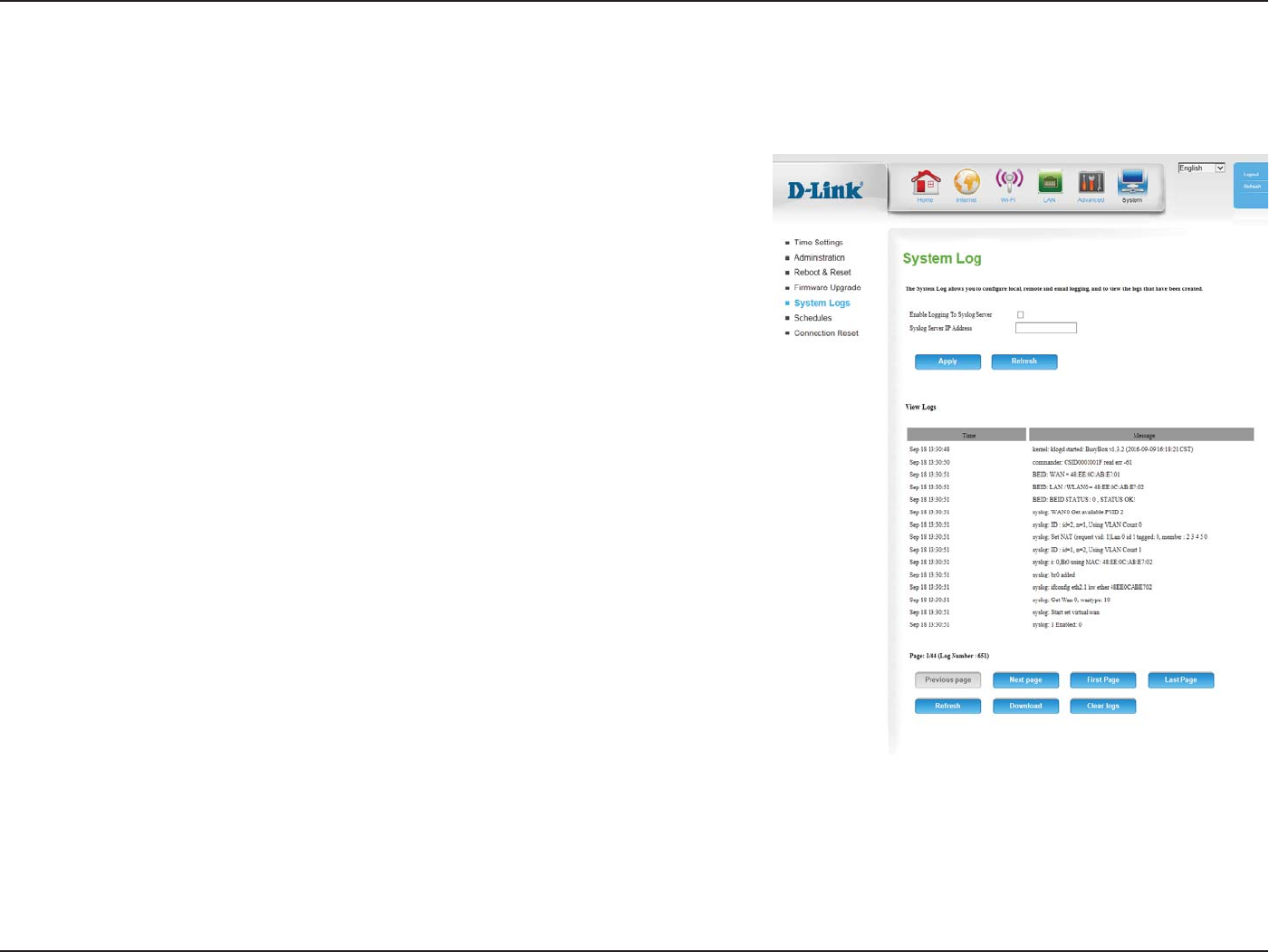
58D-Link DWR-9 User Manual
Section 4 - Conguration
Check the box to send the router logs to a Syslog server.
Enter the IP address of the Syslog server that the router will send
the logs to.
Click Apply to save your settings, or Refresh to revert to your
previous settings.
The DWR-9 keeps a running log of events and activities occurring on the router. You may send these logs to a Syslog server on your network.
Enable Logging to
Syslog Server:
Syslog Server IP
Address:
System Logs
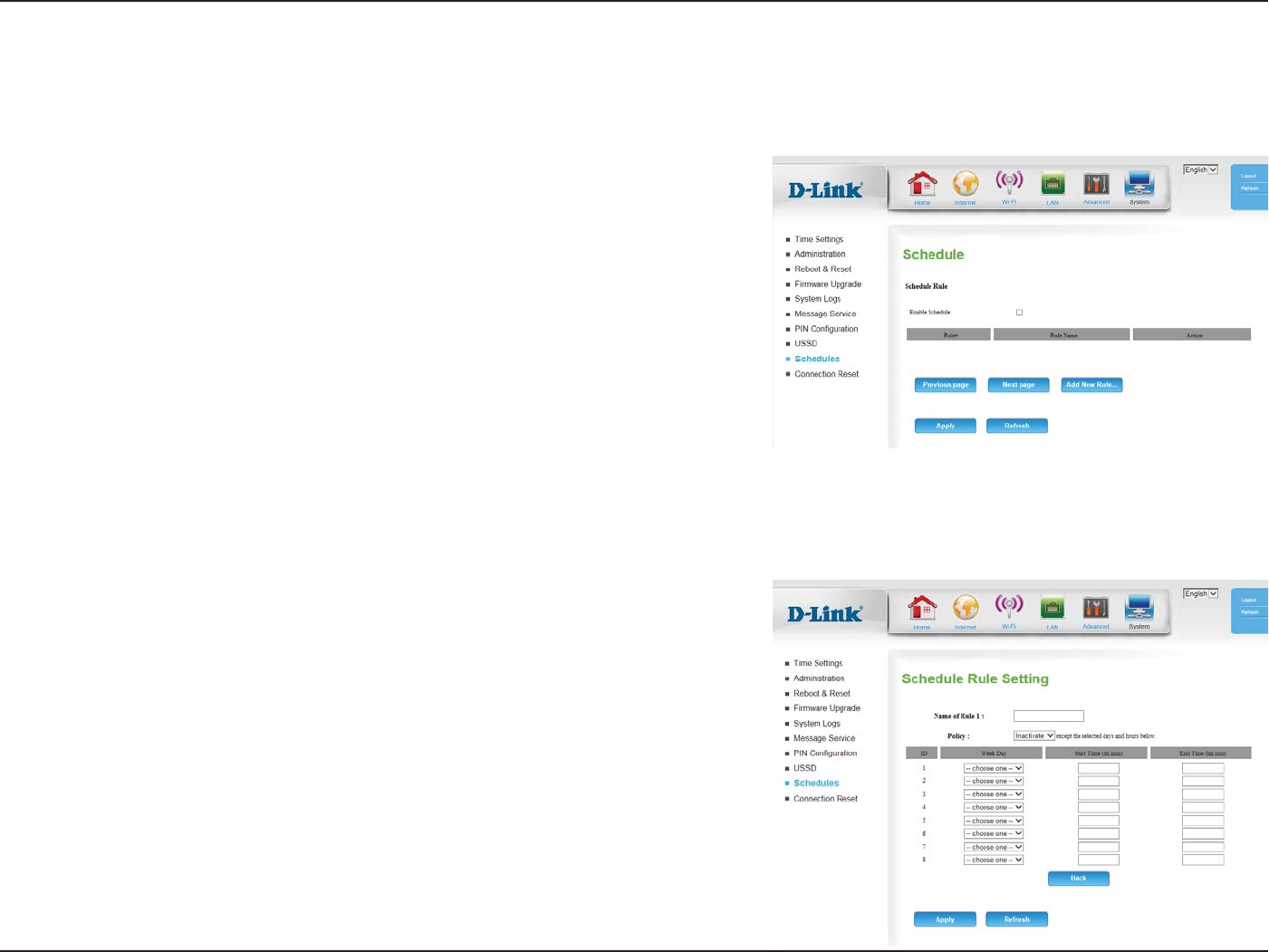
59D-Link DWR-9 User Manual
Section 4 - Conguration
Check this box to enable schedules.
Click this icon to edit the selected rule. (see below)
Click this icon to delete the selected rule.
Click this button to go to the previous page of rules.
Click this button to go to the next page of rules.
Click this button to specify the start time, end time, and name of
the rule.
Click this button to create a new rule. (see below)
This section allows you to manage schedule rules for various rewall and parental control features. Click Apply to save your settings, or Refresh to
revert to your previous settings.
Enable Schedule:
Edit:
Delete:
Previous Page:
Next Page:
Add New Rule..:
Enter a name for your new schedule.
Select Activate or Inactivate to decide whether features that use
the schedule should be active or inactive except during the times
specied.
Select a day of the week for the start time and end time.
Enter the time at which you would like the schedule to become
active.
Select the time at which you would like the schedule to become
inactive.
Name of Rule #:
Policy:
Week Day:
Start Time
(hh:mm):
End Time
(hh:mm):
Schedules
Add New Rule
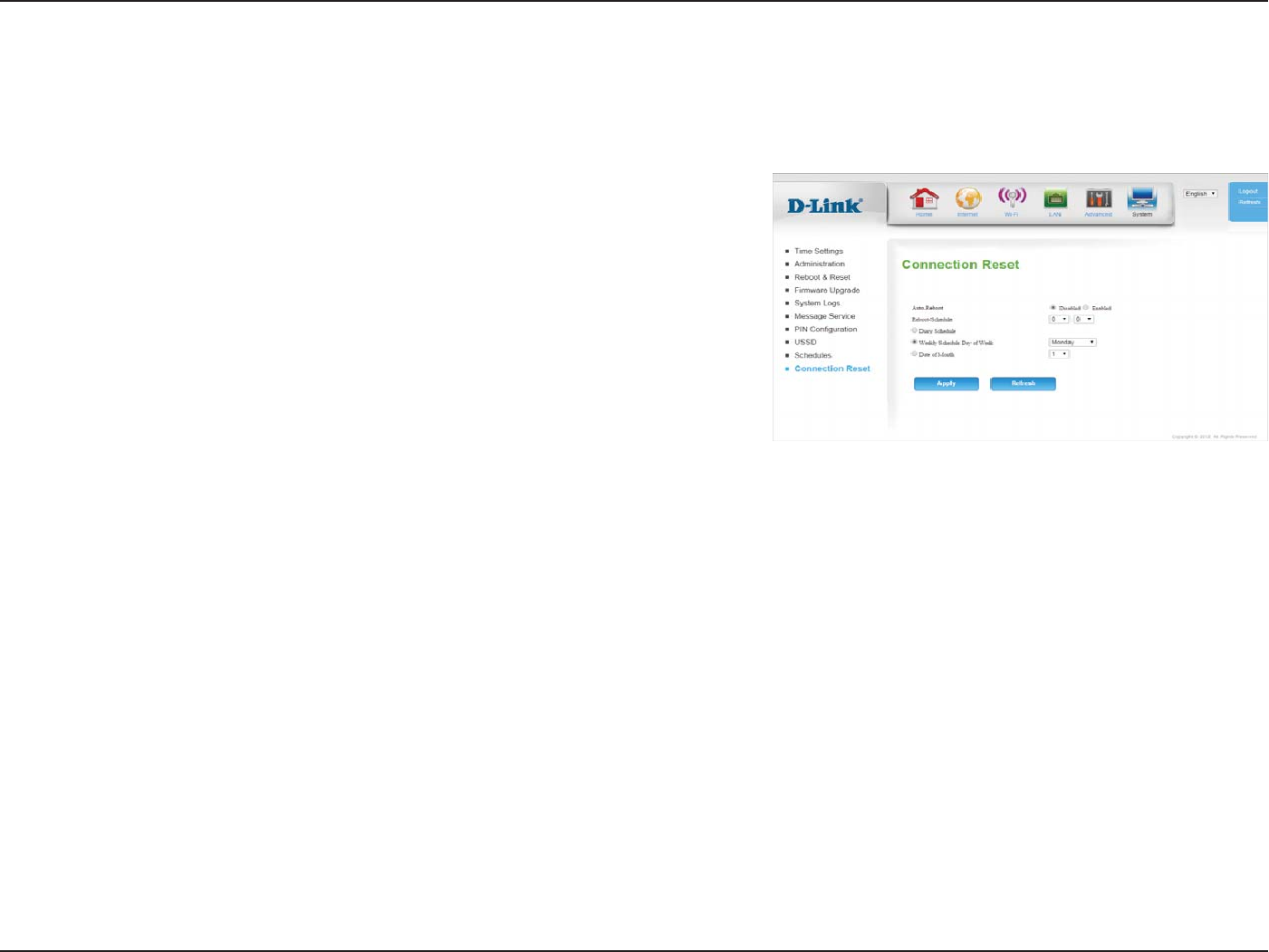
60D-Link DWR-9 User Manual
Section 4 - Conguration
Select whether the connection reset feature should be enabled or
disabled.
If the connection reset feature is enabled, select when it should
activate via the hour and minute from the dropdown boxes.
Select this option if you want the connection reset feature to
activate on a daily schedule.
Select this option if you want the connection reset feature to
activate only on a certain day of the week.
Select this option if you want the connection reset feature to
activate only on a certain day of the month.
This feature allows you to reset the Internet connection on your router by periodically resetting the connection. You can choose to have this happen
on a predetermined schedule by conguring the options on this page.
Auto-Reboot:
Reboot-Schedule:
Daily Schedule:
Weekly Schedule
Day of Week:
Date of Month:
Connection Reset
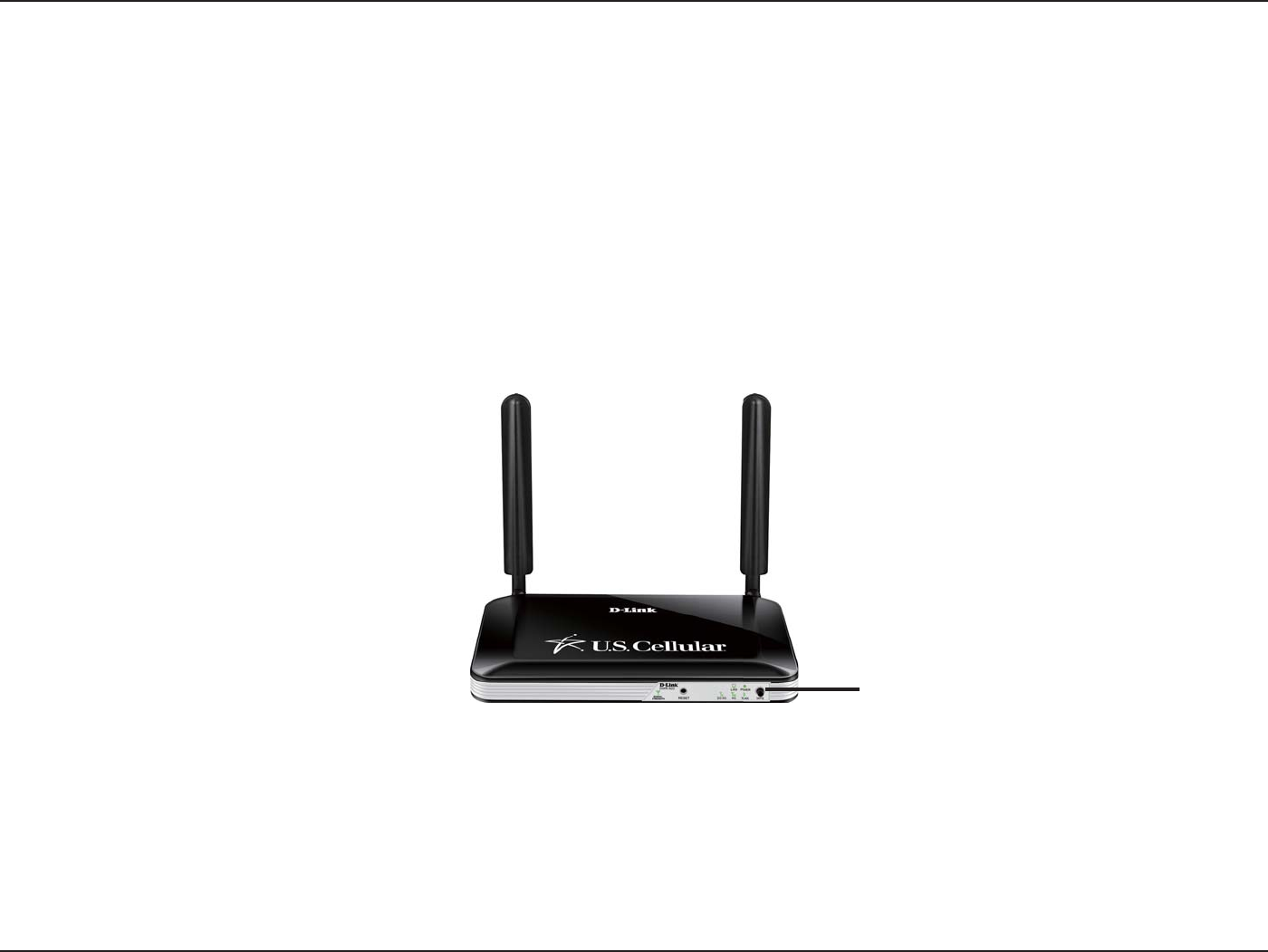
61D-Link DWR-9 User Manual
Section 5 - Connecting to a Wireless Network
Connect a Wireless Client to your Router
WPS Button
Step 2 - Within 2 minutes, press the WPS button on your wireless client (or launch the software utility and start the WPS
process).
The easiest and most secure way to connect your wireless devices to the router is with WPS (Wi-Fi Protected Setup). Most wireless
devices such as wireless adapters, media players, Blu-ray DVD players, wireless printers and cameras will have a WPS button
(or a software utility with WPS) that you can press to connect to the DWR-9 router. Please refer to your user manual for the
wireless device you want to connect to make sure you understand how to enable WPS. Once you know, follow the steps below:
Step 1 - Press the WPS button on the DWR-9 for about 6 seconds. The WLAN LED on the front will start to blink.
Step 3 - Allow up to 1 minute for your connection to be congured. Once the Internet light stops blinking, you will be connected
and your wireless connection will be secure with WPA2.
WPS Button
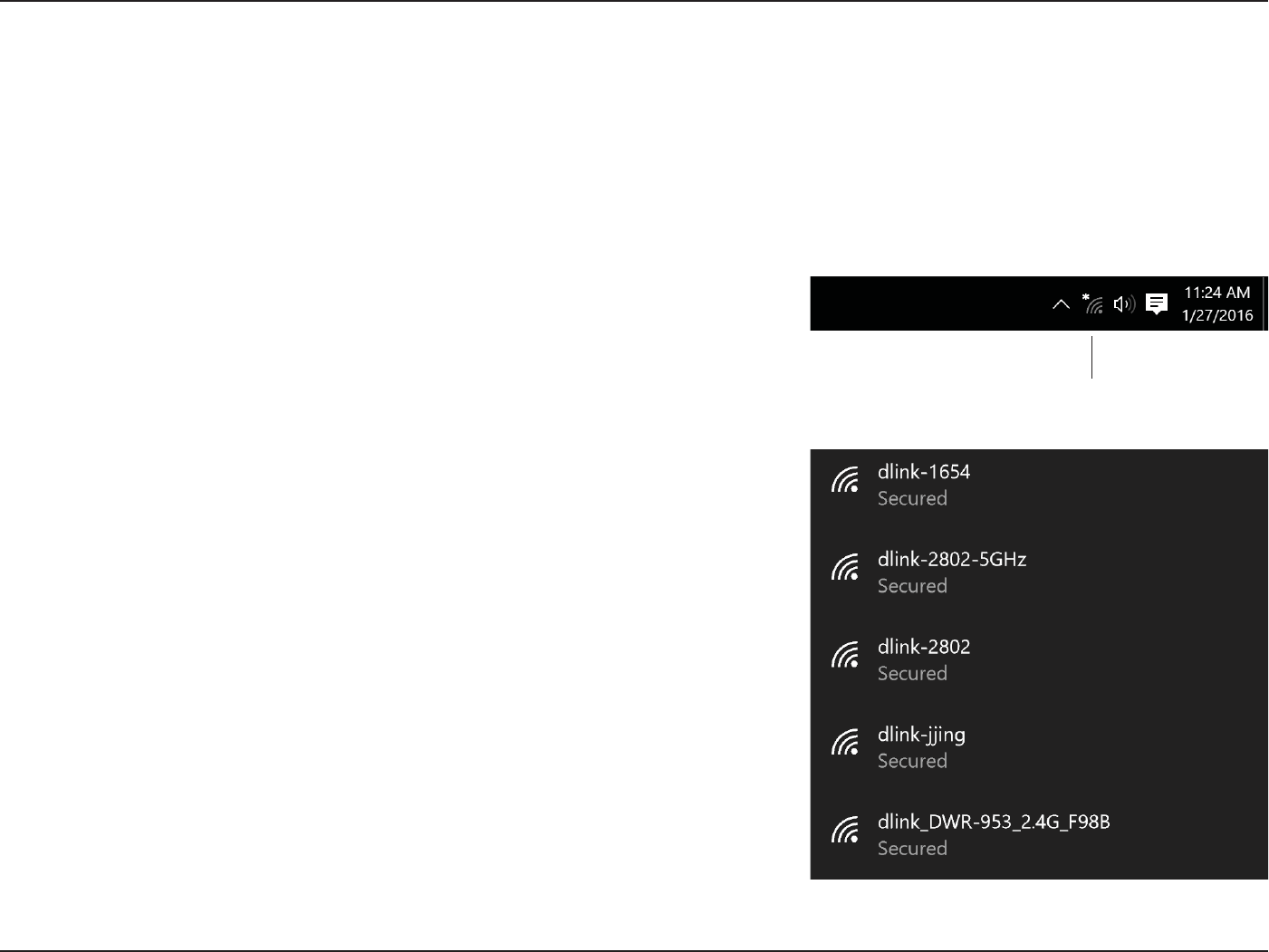
62D-Link DWR-9 User Manual
Section 4 - Connecting a Wireless Client
To connect to a wireless network using Windows 10, you will need to know the wireless network name (SSID) and Wi-Fi password
(security key) of the device you are connecting to.
To join an existing network, locate the wireless network icon in the taskbar,
next to the time display and click on it.
Wireless Icon
Clicking on this icon will display a list of wireless networks which are within
range of your computer. Select the desired network by clicking on its SSID.
Connecting to a Wireless Network
Windows® 10
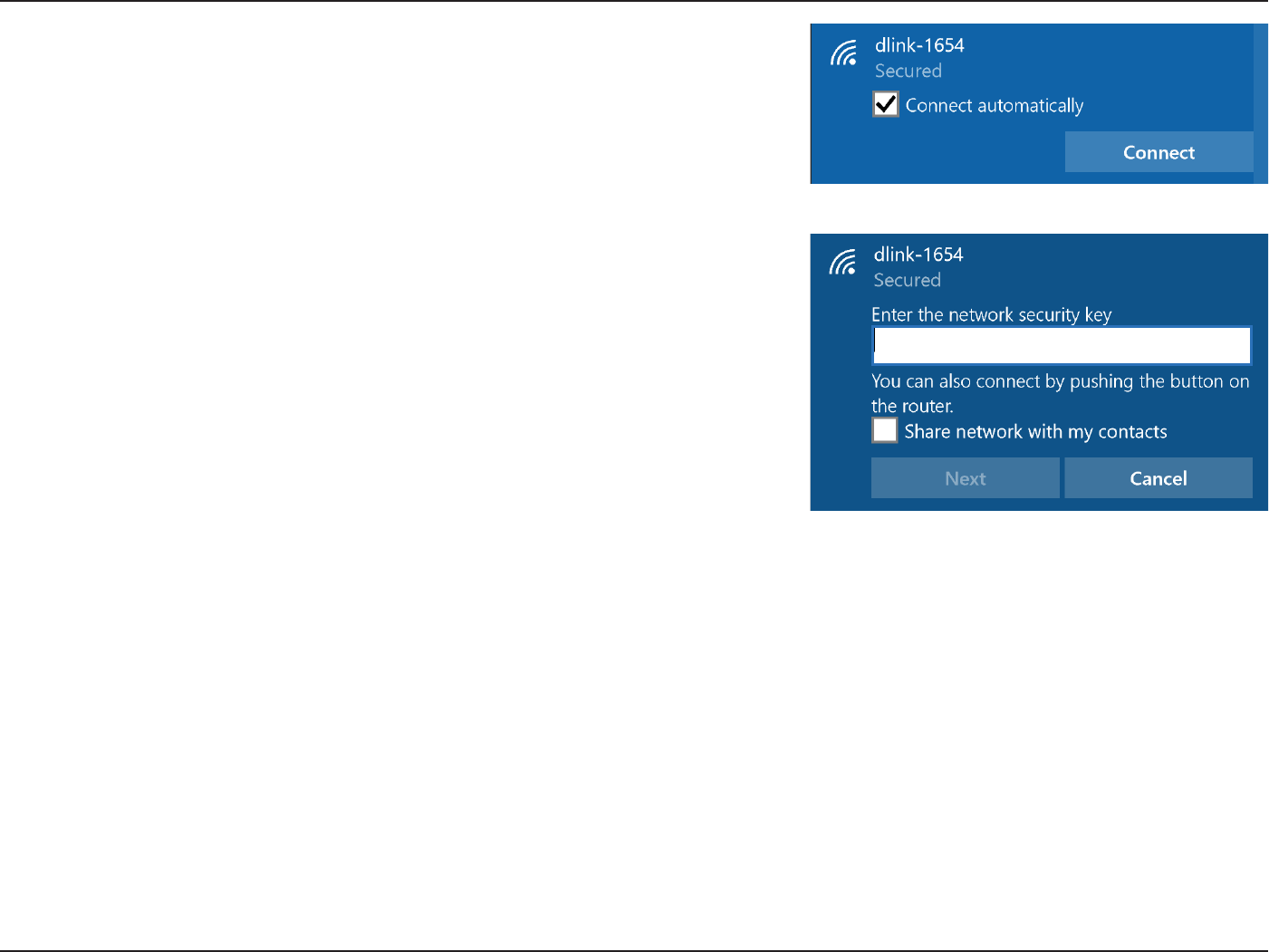
63D-Link DWR-9User Manual
Section 4 - Connecting a Wireless Client
To connect to the network, click Connect.
To automatically connect when your device is in range, click the Connect
Automatically check box. Your computer will now automatically connect to
this wireless network whenever it is detected.
You will then be prompted to enter the Wi-Fi password (network security key)
for the wireless network. Enter the password into the box and click Next to
connect to the network.
You can also use Wi-Fi Protected Setup (WPS) to connect to the wireless network.
Press the WPS button on your device and you will be automatically connected.
It may take 20-30 seconds to connect to the wireless network. If the connection
fails, please verify that the security settings are correct. The key or passphrase
must be exactly the same as the one on the wireless router.
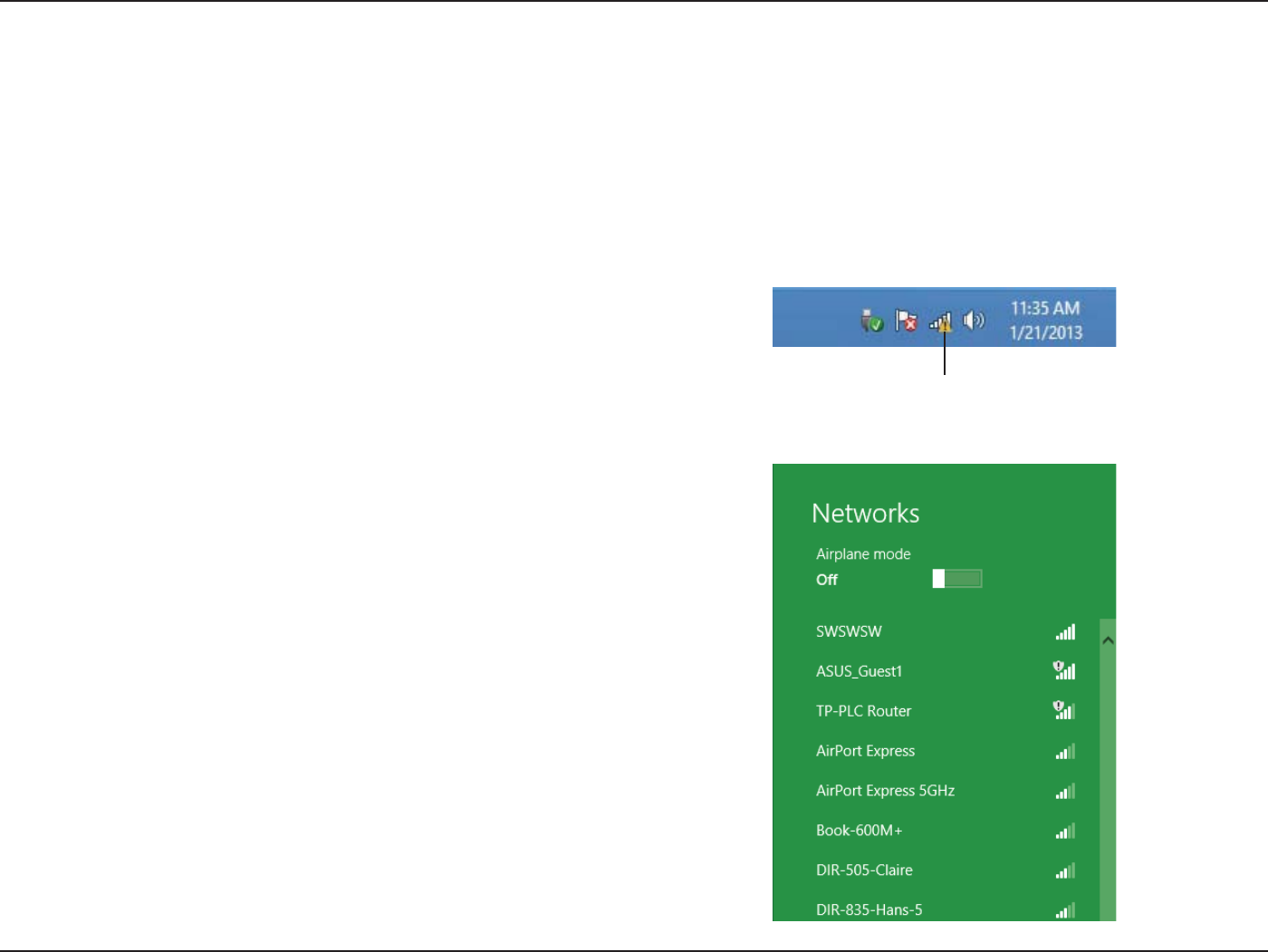
64D-Link DWR-9 User Manual
Section 5 - Connecting to a Wireless Network
Windows® 8
WPA/WPA2
It is recommended that you enable wireless security (WPA/WPA2) on your wireless router or access point before conguring
your wireless adapter. If you are joining an existing network, you will need to know the security key (Wi-Fi password) being used.
To join an existing network, locate the wireless network icon in the
taskbar next to the time display.
Wireless Icon
Clicking on this icon will display a list of wireless networks that are within
connecting proximity of your computer. Select the desired network by
clicking on the network name.
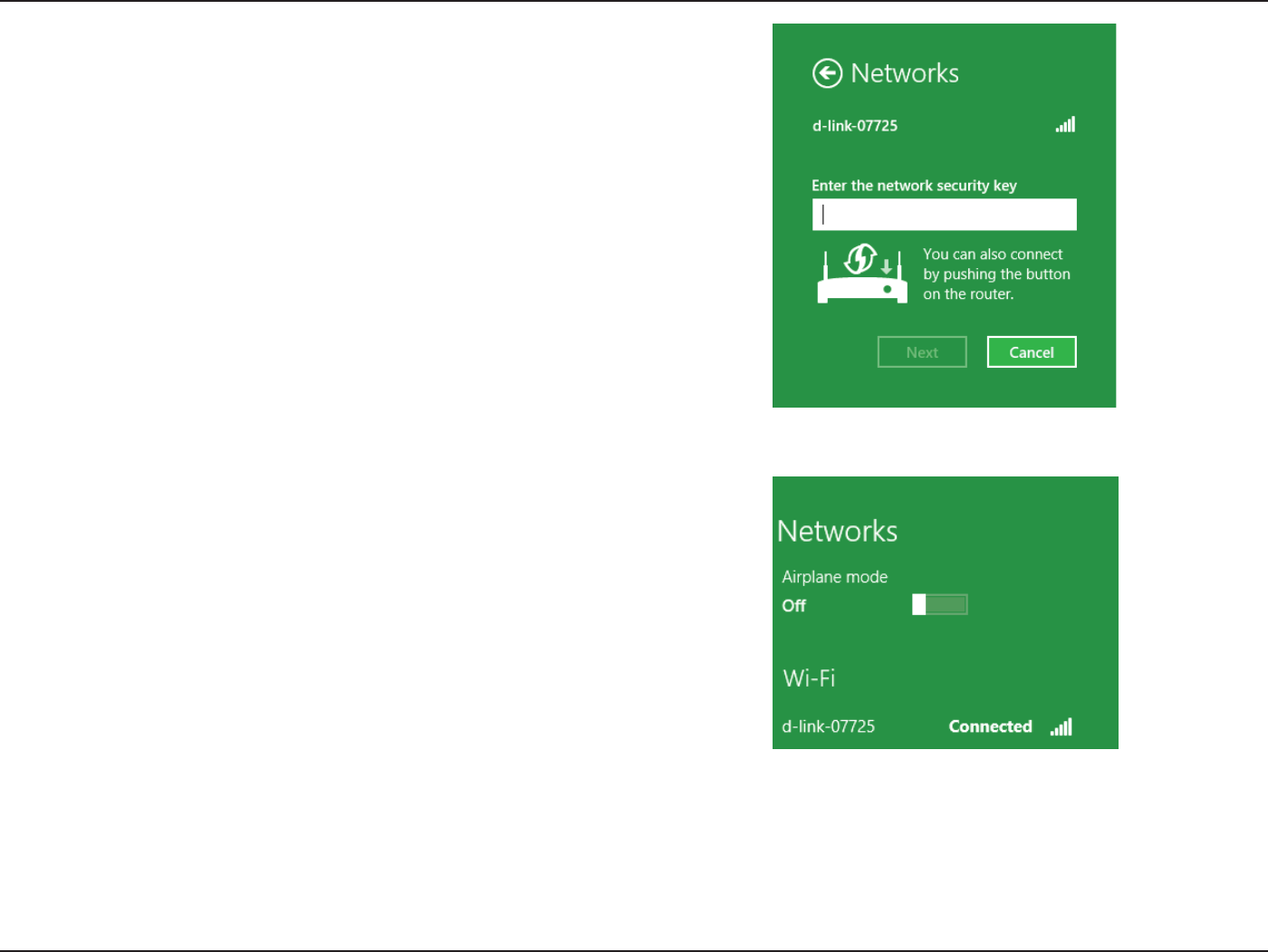
65D-Link DWR-9 User Manual
Section 5 - Connecting to a Wireless Network
You will then be prompted to enter the network security key (Wi-Fi
password) for the wireless network. Enter the password into the box
and click Next.
If you wish to use Wi-Fi Protected Setup (WPS) to connect to the router,
you can also press the WPS button on your router during this step to
enable the WPS function.
When you have established a successful connection to a wireless network,
the word Connected will appear next to the name of the network to
which you are connected to.
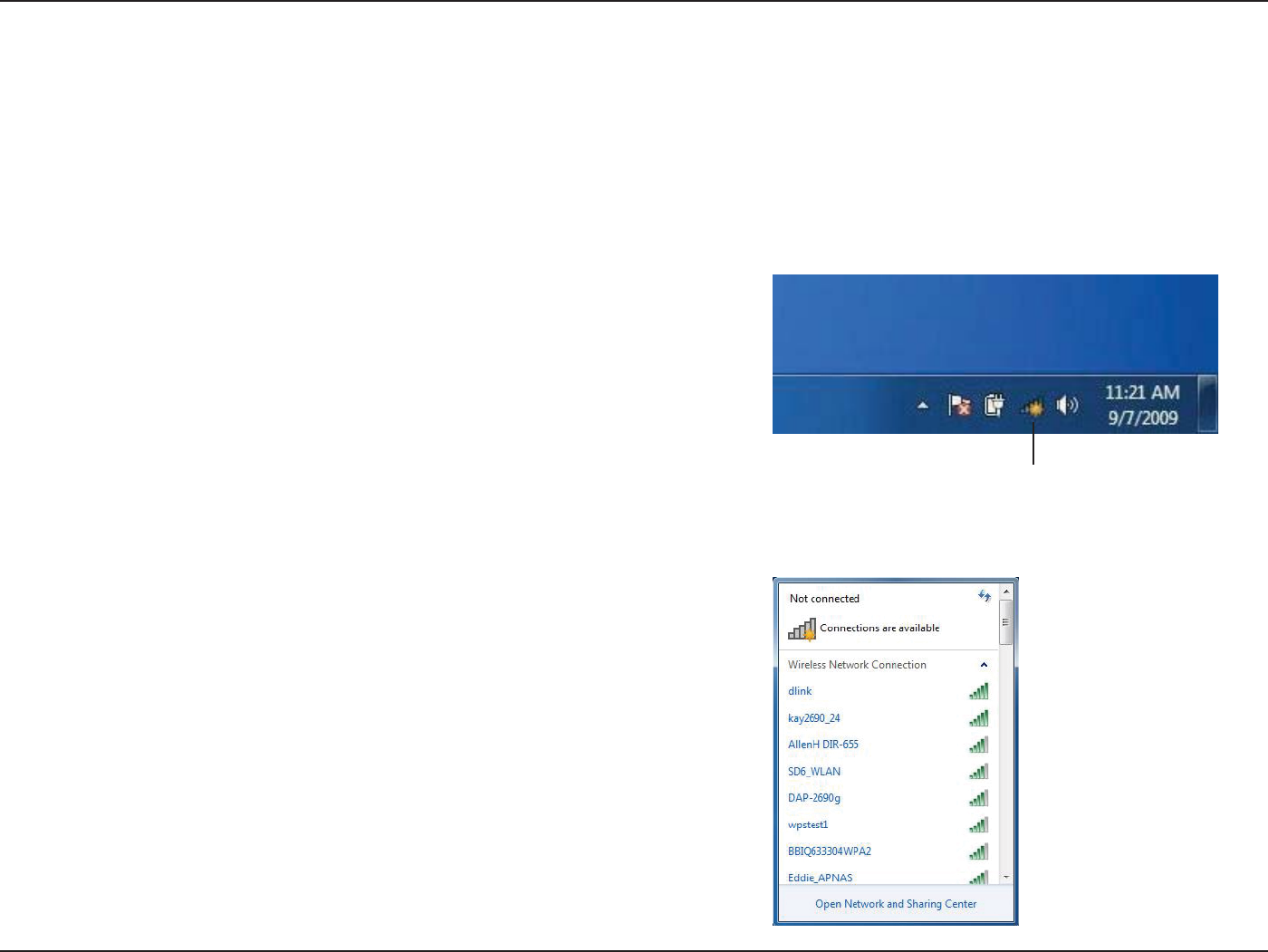
66D-Link DWR-9 User Manual
Section 5 - Connecting to a Wireless Network
Windows® 7
It is recommended that you enable wireless security (WPA/WPA2) on your wireless router or access point before conguring
your wireless adapter. If you are joining an existing network, you will need to know the security key or passphrase being used.
1. Click on the wireless icon in your system tray (lower-right corner).
2. The utility will display any available wireless networks in your area.
Wireless Icon
WPA/WPA2
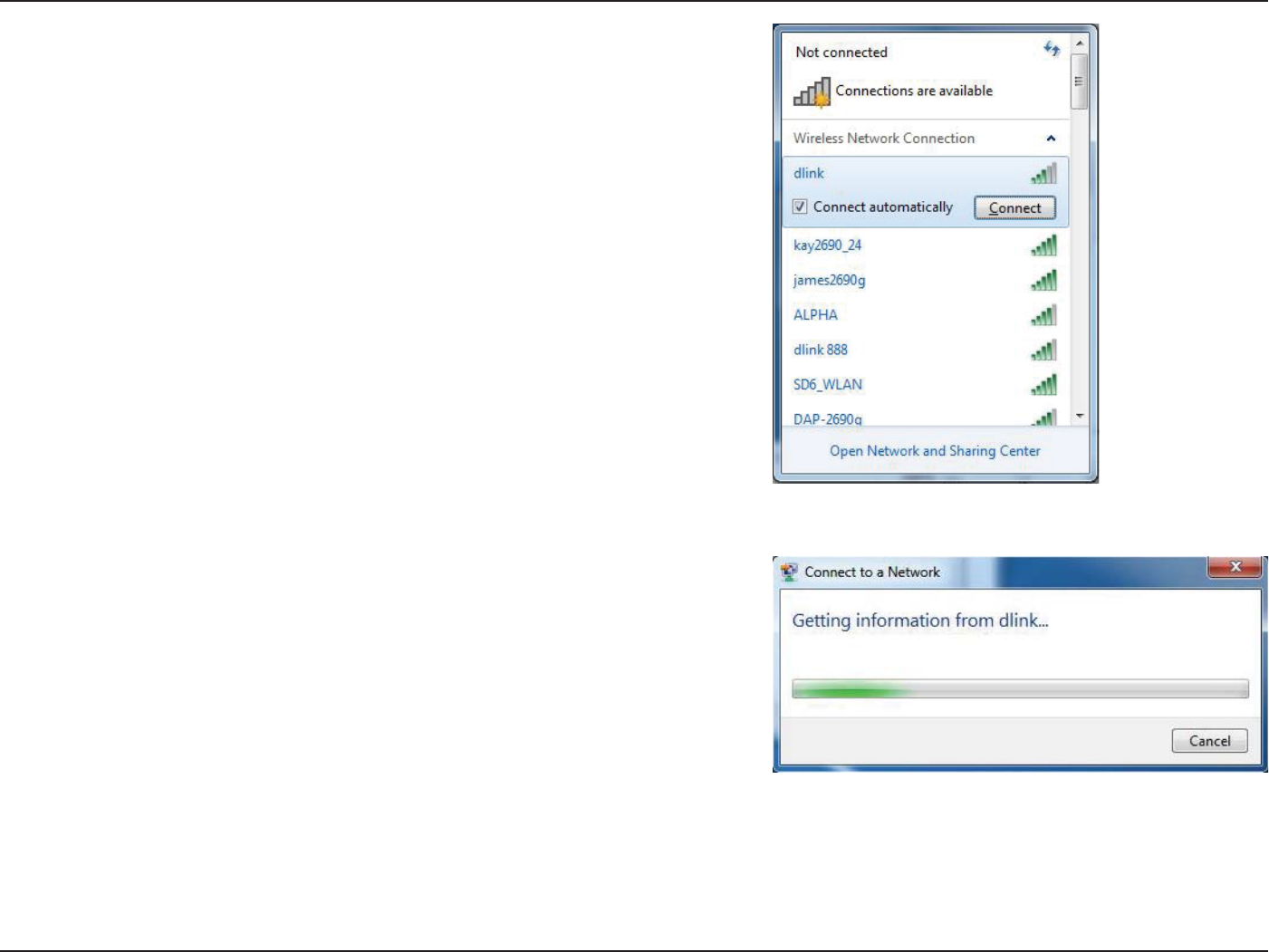
67D-Link DWR-9User Manual
Section 5 - Connecting to a Wireless Network
3. Highlight the wireless connection with Wi-Fi name (SSID) you would
like to connect to and click the Connect button.
If you get a good signal but cannot access the Internet, check your
TCP/IP settings for your wireless adapter. Refer to Networking Basics
on page 88 for more information.
4. The following window appears while your computer tries to connect
to the router.
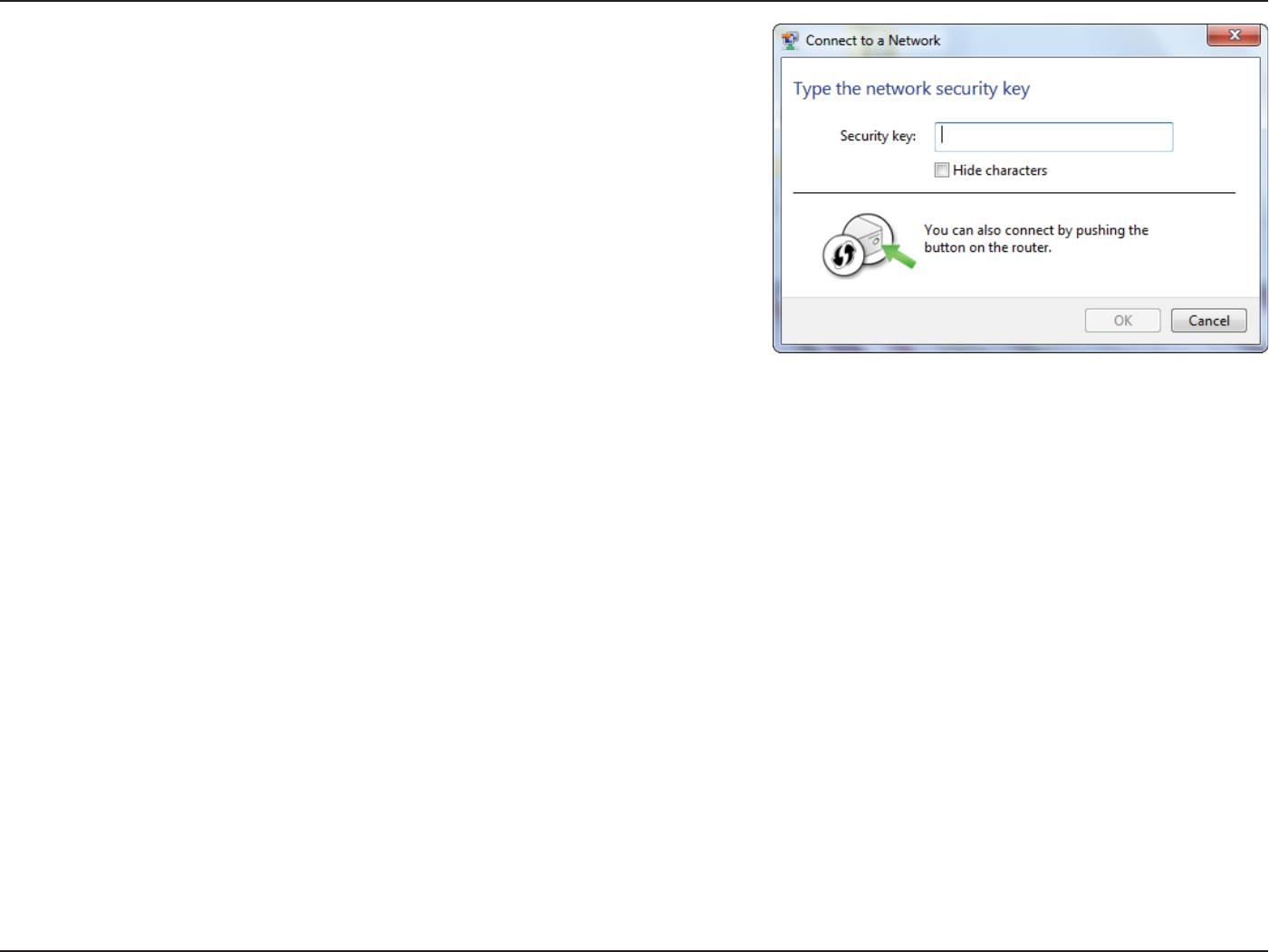
68D-Link DWR-9 User Manual
Section 5 - Connecting to a Wireless Network
5. Enter the same security key or passphrase (Wi-Fi password) that is on
your router and click Connect. You can also connect by pushing the
WPS button on the router.
It may take 20-30 seconds to connect to the wireless network. If the
connection fails, please verify that the security settings are correct. The
key or passphrase must be exactly the same as the one on the wireless
router.
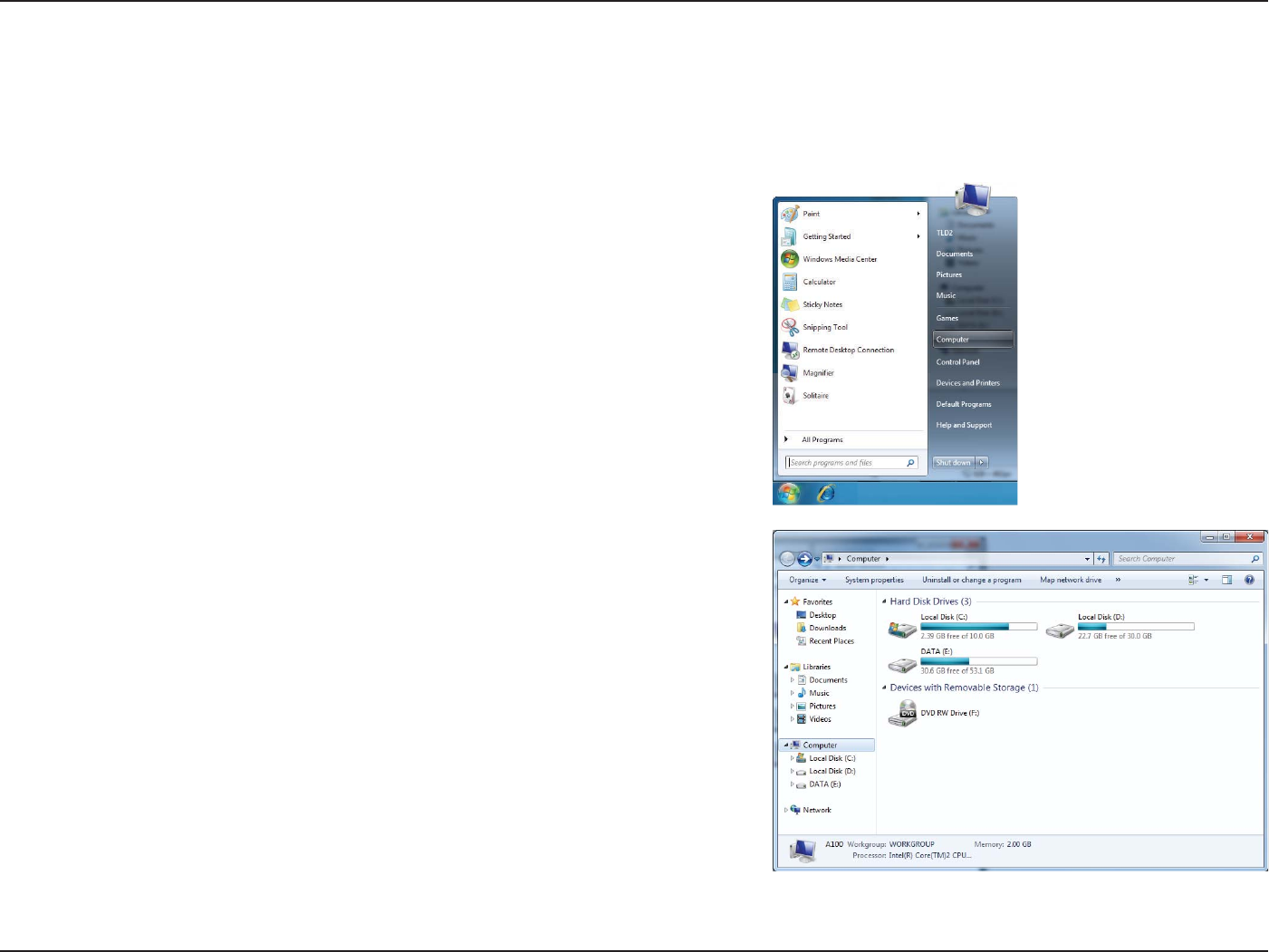
69D-Link DWR-9 User Manual
Section 5 - Connecting to a Wireless Network
WPS
The WPS feature of the DWR-9 can be congured using Windows® 7. Carry out the following steps to use Windows® 7 to
congure the WPS feature:
1. Click the Start button and select Computer from the Start menu.
2. Click Network on the left side.
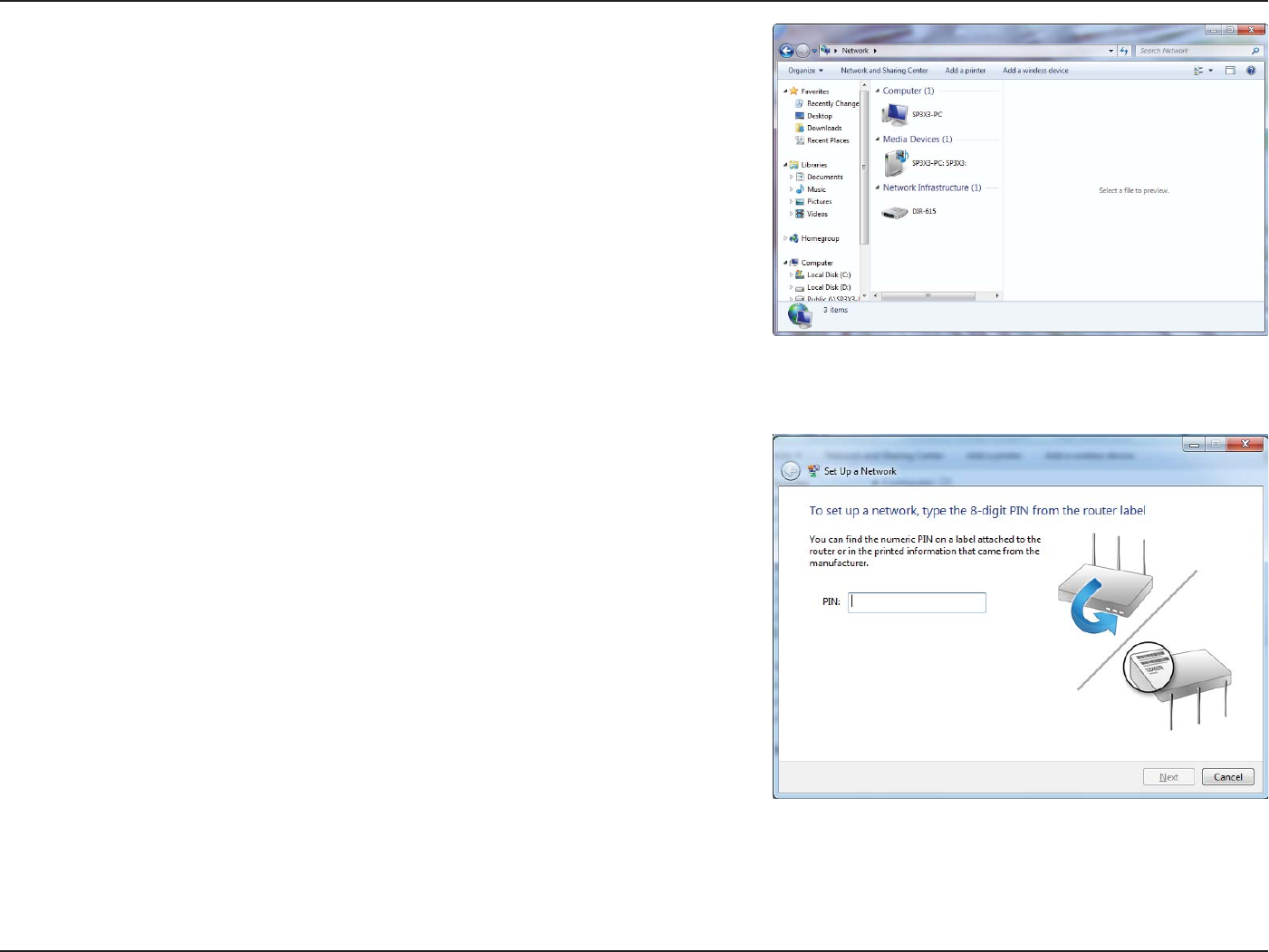
70D-Link DWR-9 User Manual
Section 5 - Connecting to a Wireless Network
3. Double-click the DWR-9.
4. Input the WPS PIN number (on the router label) in the Setup > Wireless
Setup menu in the Router’s Web UI) and click Next.
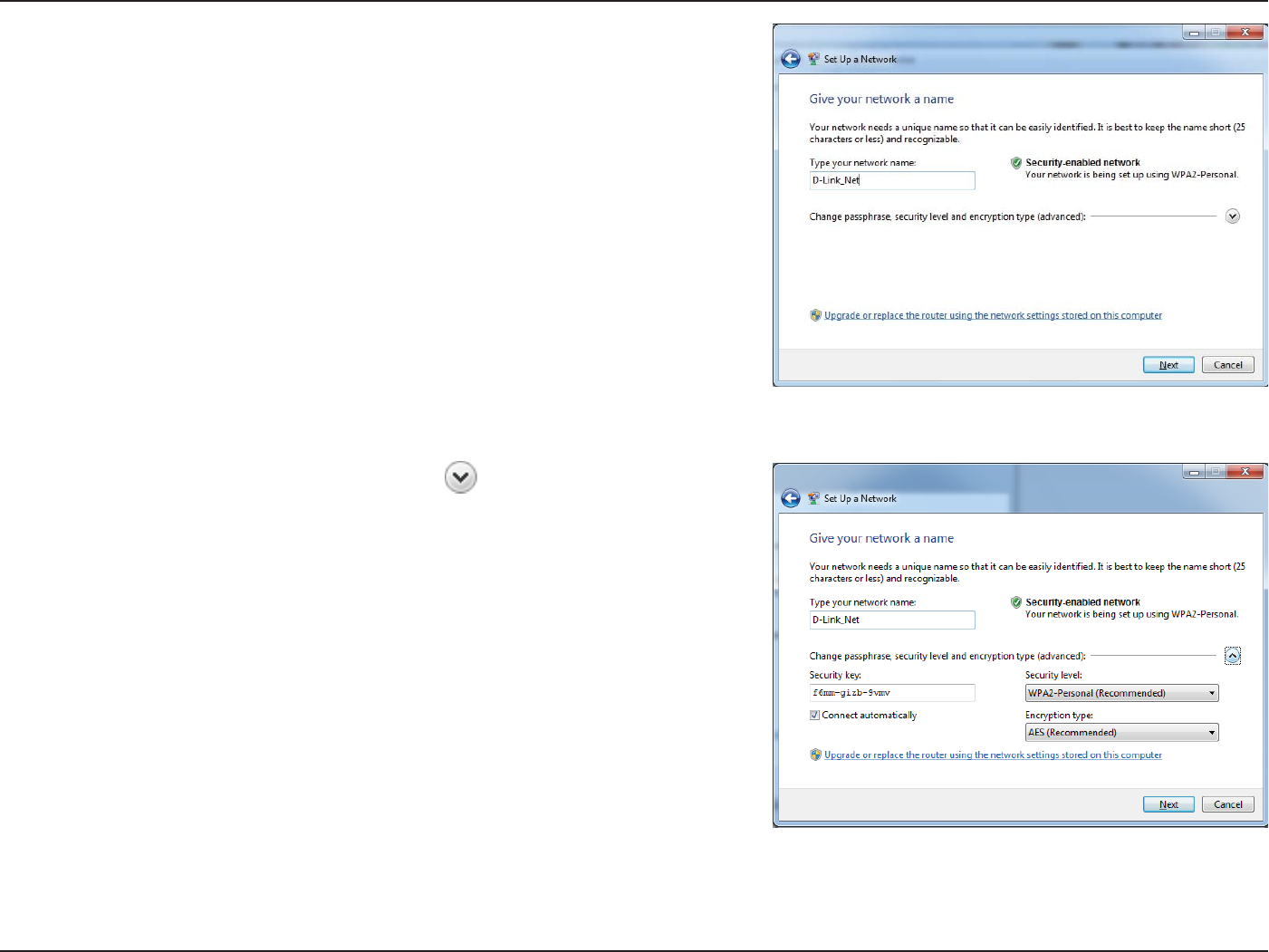
71D-Link DWR-9 User Manual
Section 5 - Connecting to a Wireless Network
5. Type a name to identify the network.
6. To congure advanced settings, click the icon.
Click Next to continue.
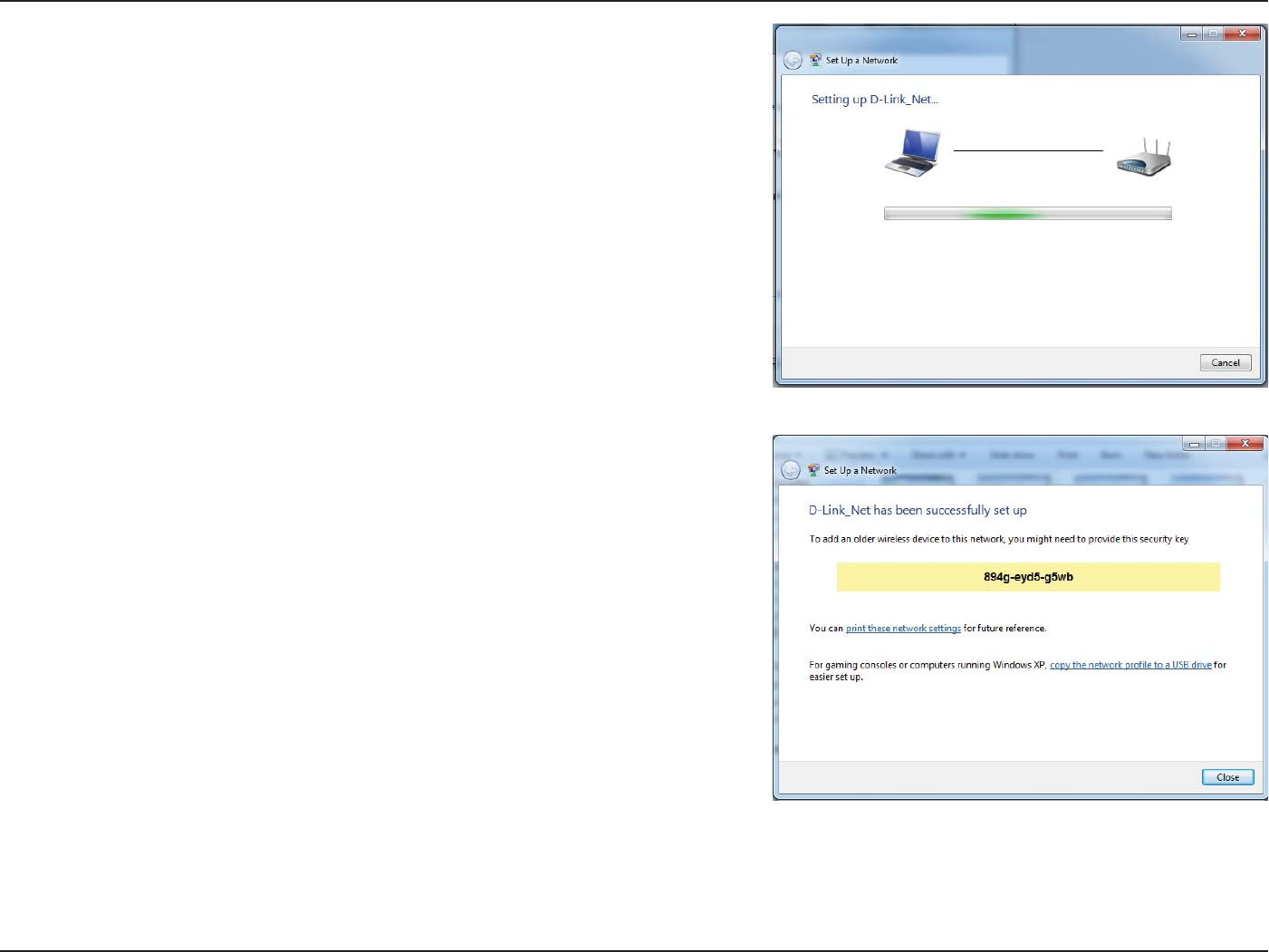
72D-Link DWR-9 User Manual
Section 5 - Connecting to a Wireless Network
7. The following window appears while the router is being congured.
Wait for the conguration to complete.
8. The following window informs you that WPS on the router has been
set up successfully.
Make a note of the security key as you may need to provide this security
key if adding an older wireless device to the network in the future.
9. Click Close to complete WPS setup.
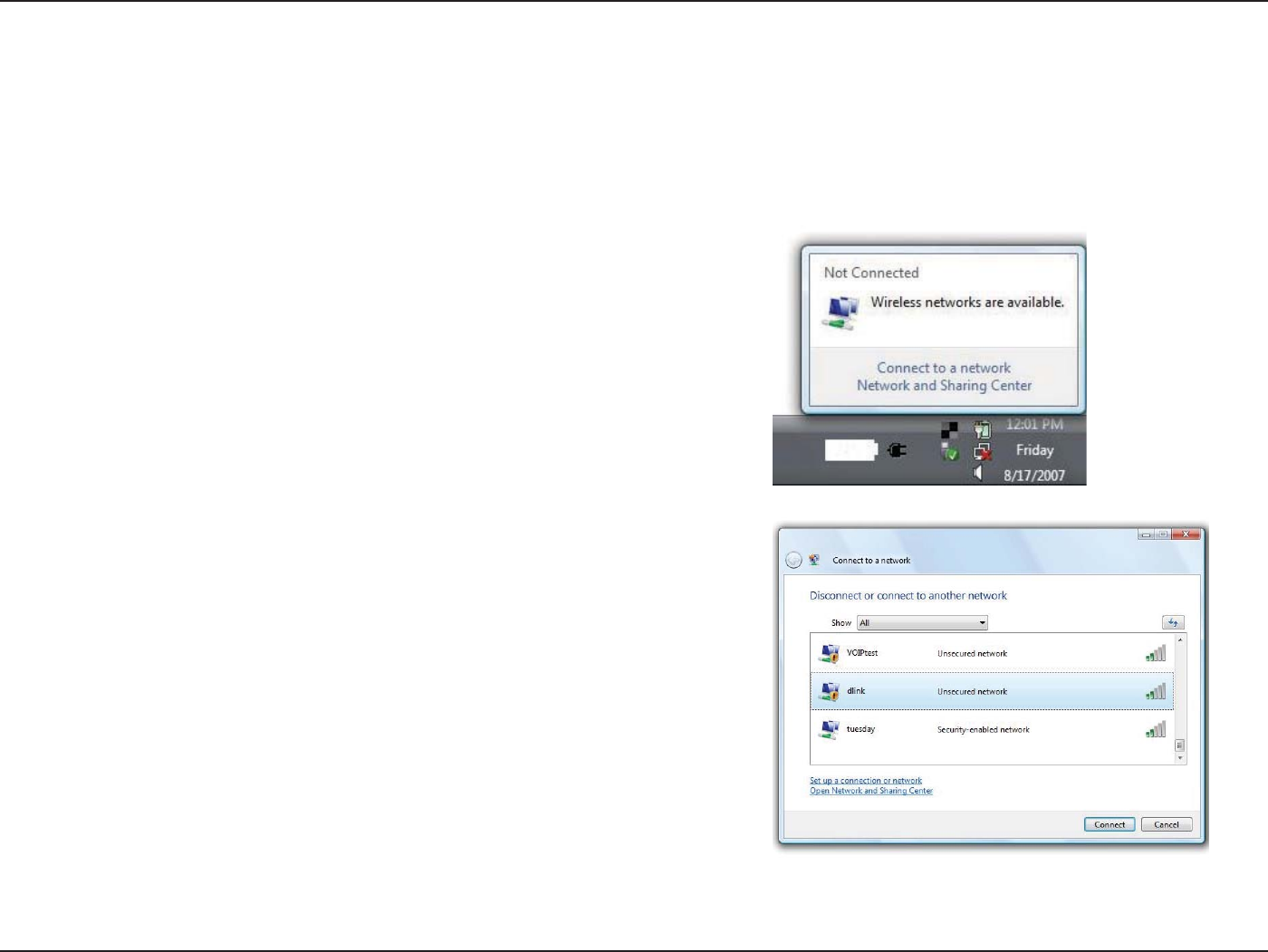
73D-Link DWR-9User Manual
Section 5 - Connecting to a Wireless Network
Windows Vista®
Windows Vista® users may use the built-in wireless utility. If you are using another company’s wireless utility, please refer to the
user manual of your wireless adapter for help connecting to a wireless network. Most wireless utilities will have a “site survey”
option similar to the Windows Vista® utility as seen below.
Right-click on the wireless computer icon in your system tray (lower-right
corner next to the time). Select Connect to a network.
If you receive the Wireless Networks Detected bubble, click on the
center of the bubble to access the utility.
or
The utility will display any available wireless networks in your area. Click
on a network (displayed using the SSID) and click the Connect button.
If you get a good signal but cannot access the Internet, check you
TCP/IP settings for your wireless adapter. Refer to the Networking Basics
section in this manual for more information.
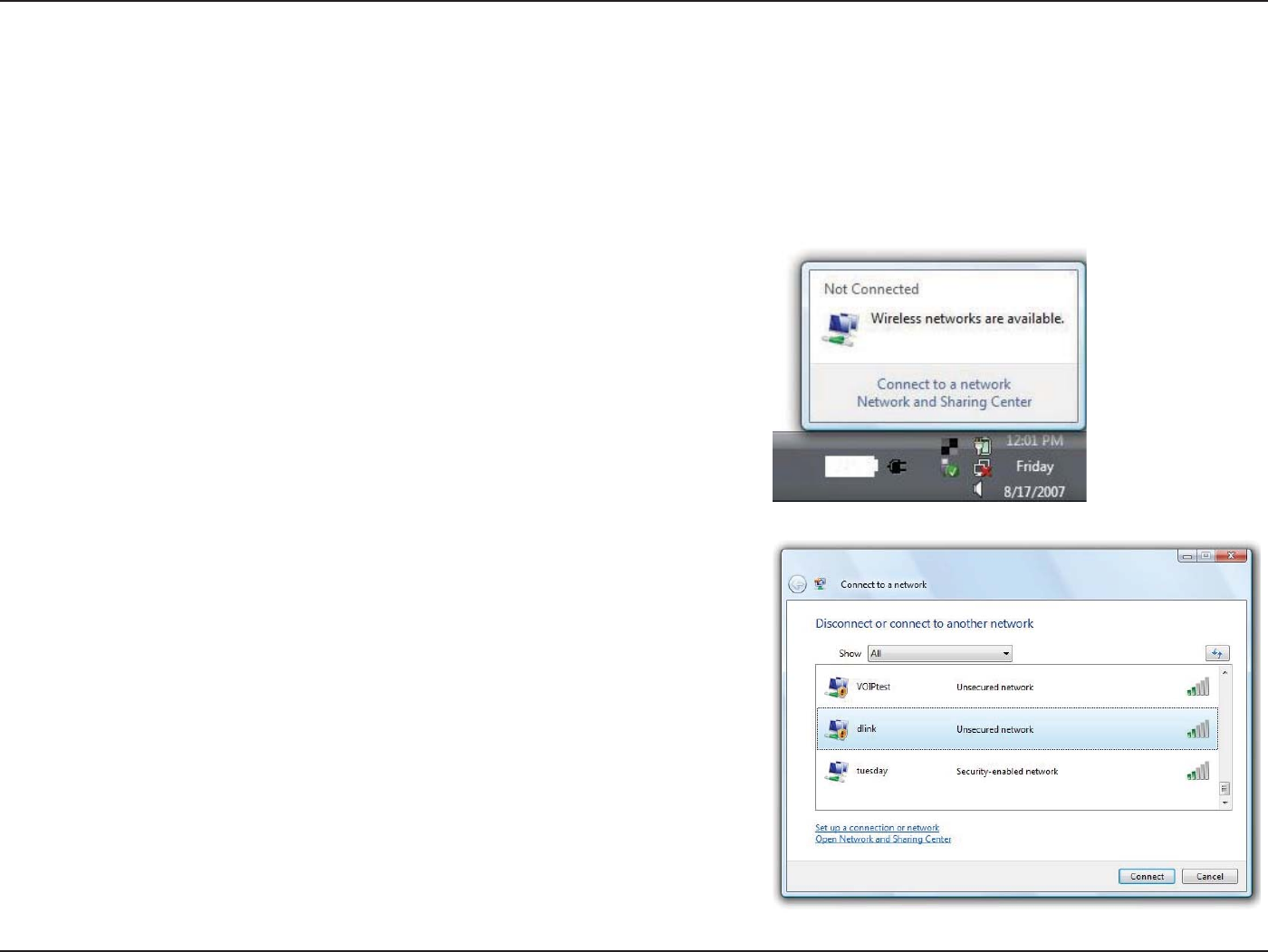
74D-Link DWR-9 User Manual
Section 5 - Connecting to a Wireless Network
WPA/WPA2
It is recommended that you enable wireless security (WPA/WPA2) on your wireless router or access point before conguring
your wireless adapter. If you are joining an existing network, you will need to know the security key or passphrase being used.
2. Highlight the Wi-Fi name (SSID) you would like to connect to and
click Connect.
1. Open the Windows Vista® Wireless Utility by right-clicking on the
wireless computer icon in your system tray (lower right corner of
screen). Select Connect to a network.
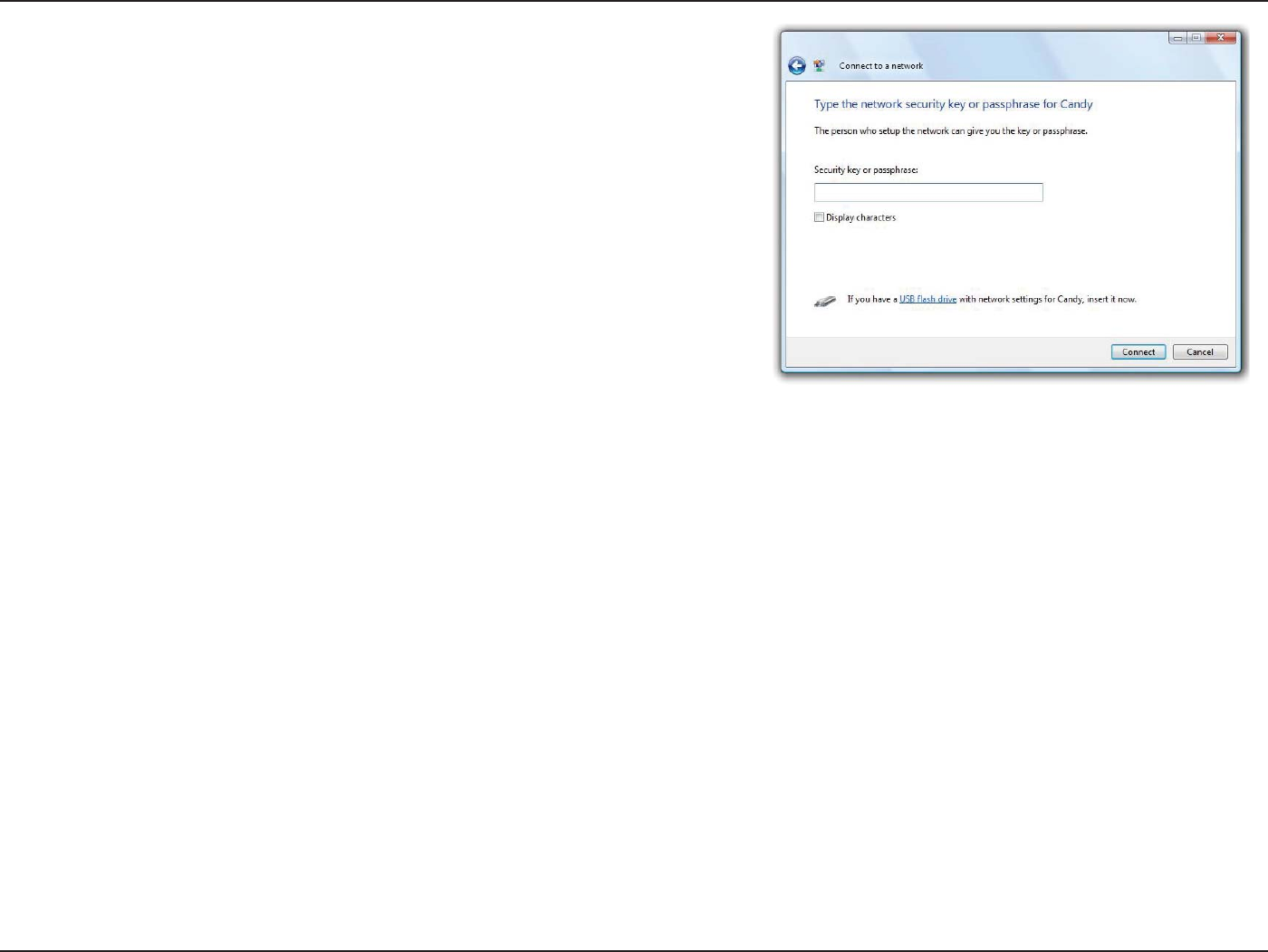
75D-Link DWR-9 User Manual
Section 5 - Connecting to a Wireless Network
3. Enter the same security key or passphrase (Wi-Fi password) that is on
your router and click Connect.
It may take 20-30 seconds to connect to the wireless network. If the
connection fails, please verify that the security settings are correct. The
key or passphrase must be exactly the same as the one on the wireless
router.
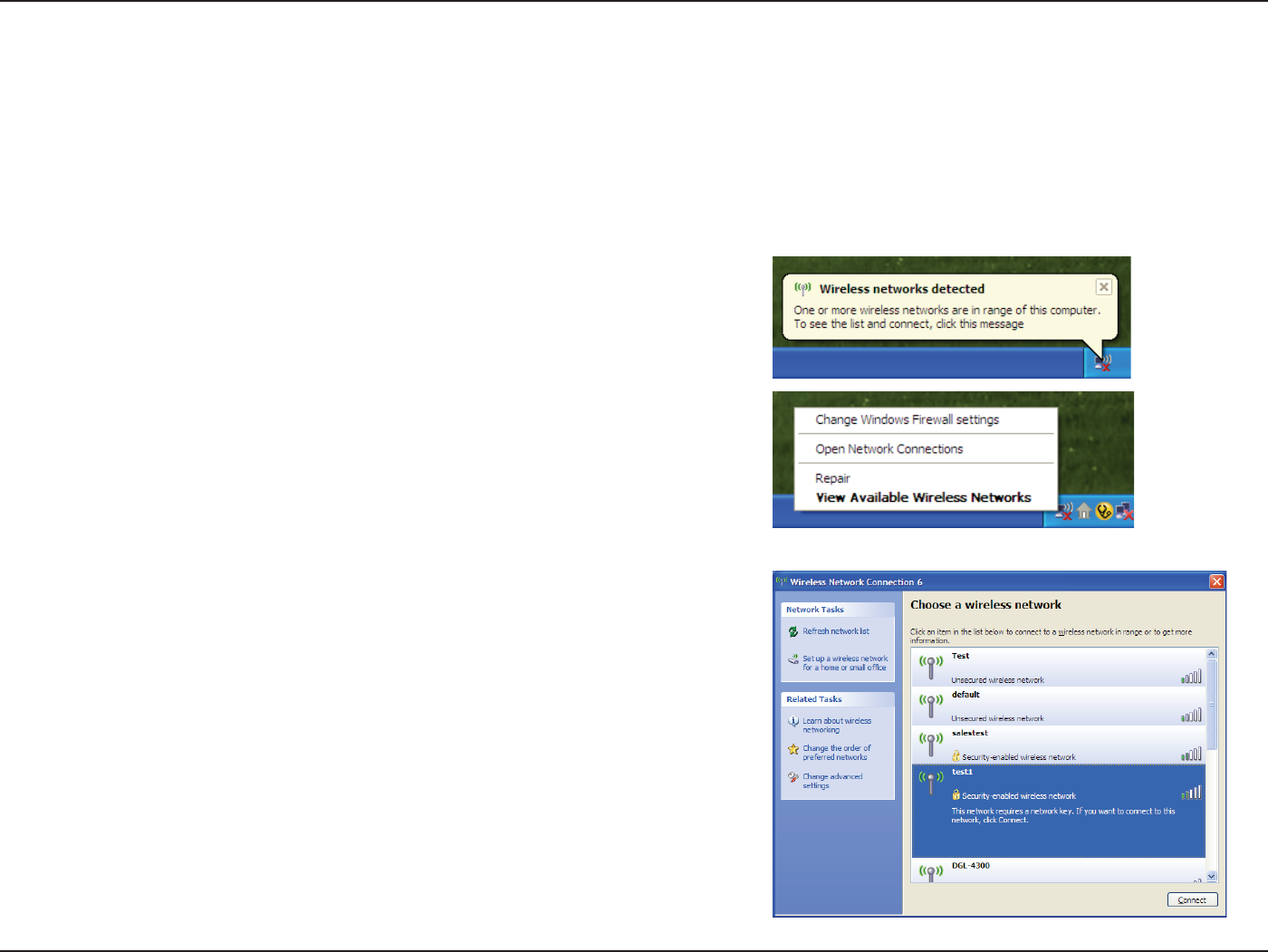
76D-Link DWR-9 User Manual
Section 5 - Connecting to a Wireless Network
Windows® XP
Windows® XP users may use the built-in wireless utility (Zero Conguration Utility). The following instructions are for Service
Pack 2 users. If you are using another company’s utility, please refer to the user manual of your wireless adapter for help with
connecting to a wireless network. Most utilities will have a “site survey” option similar to the Windows® XP utility as seen below.
Right-click on the wireless computer icon in your system tray (lower-right
corner next to the time). Select View Available Wireless Networks.
If you receive the Wireless Networks Detected bubble, click on the
center of the bubble to access the utility.
or
The utility will display any available wireless networks in your area. Click
on a Wi-Fi network (displayed using the SSID) and click the Connect
button.
If you get a good signal but cannot access the Internet, check you
TCP/IP settings for your wireless adapter. Refer to the Networking Basics
section in this manual for more information.
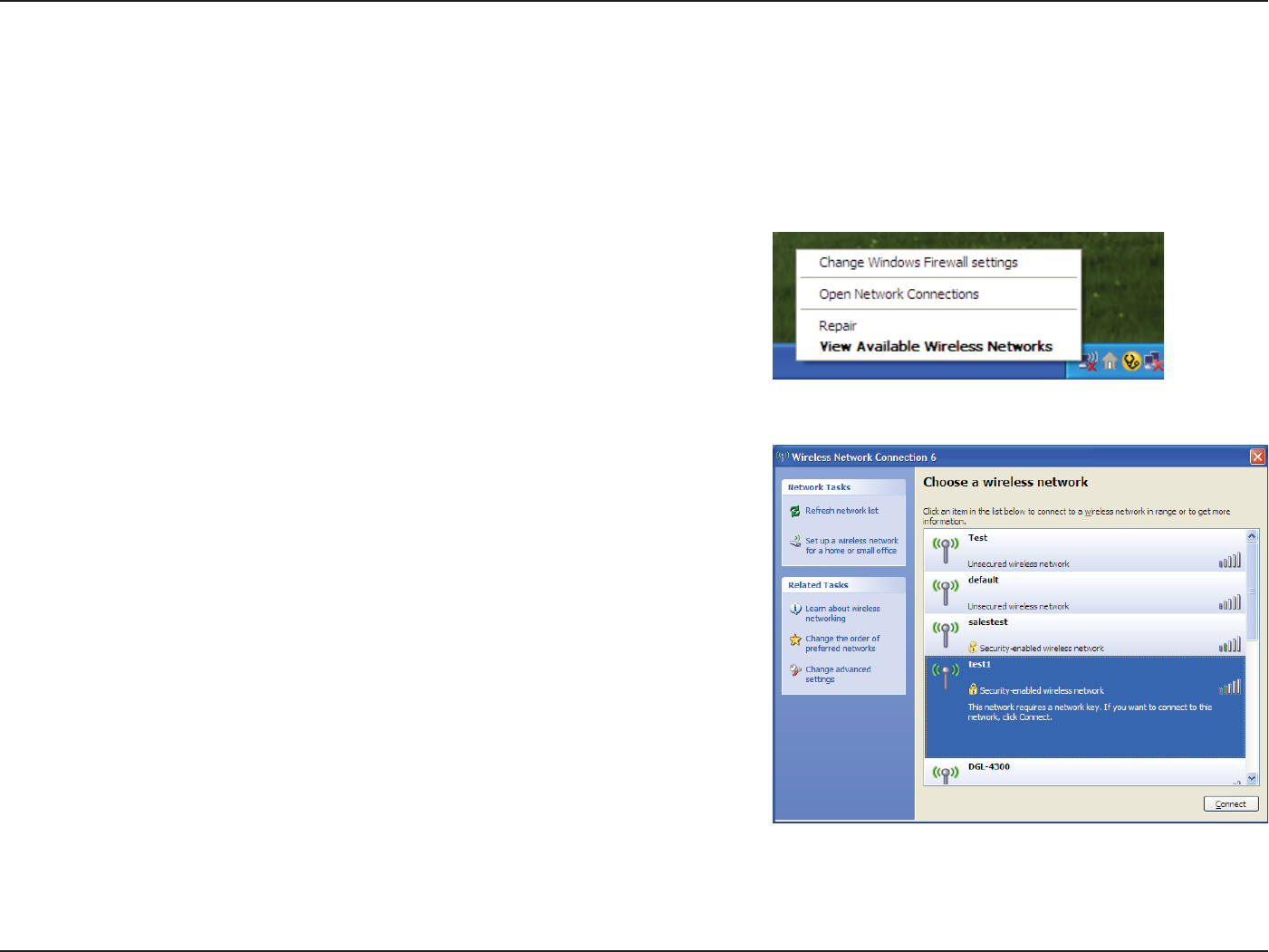
77D-Link DWR-9 User Manual
Section 5 - Connecting to a Wireless Network
It is recommended to enable WPA on your wireless router or access point before conguring your wireless adapter. If you are
joining an existing network, you will need to know the WPA key being used.
2. Highlight the Wi-Fi network (SSID) you would like to connect to and
click Connect.
1. Open the Windows® XP Wireless Utility by right-clicking on the wireless
computer icon in your system tray (lower-right corner of screen). Select
View Available Wireless Networks.
WPA/WPA2
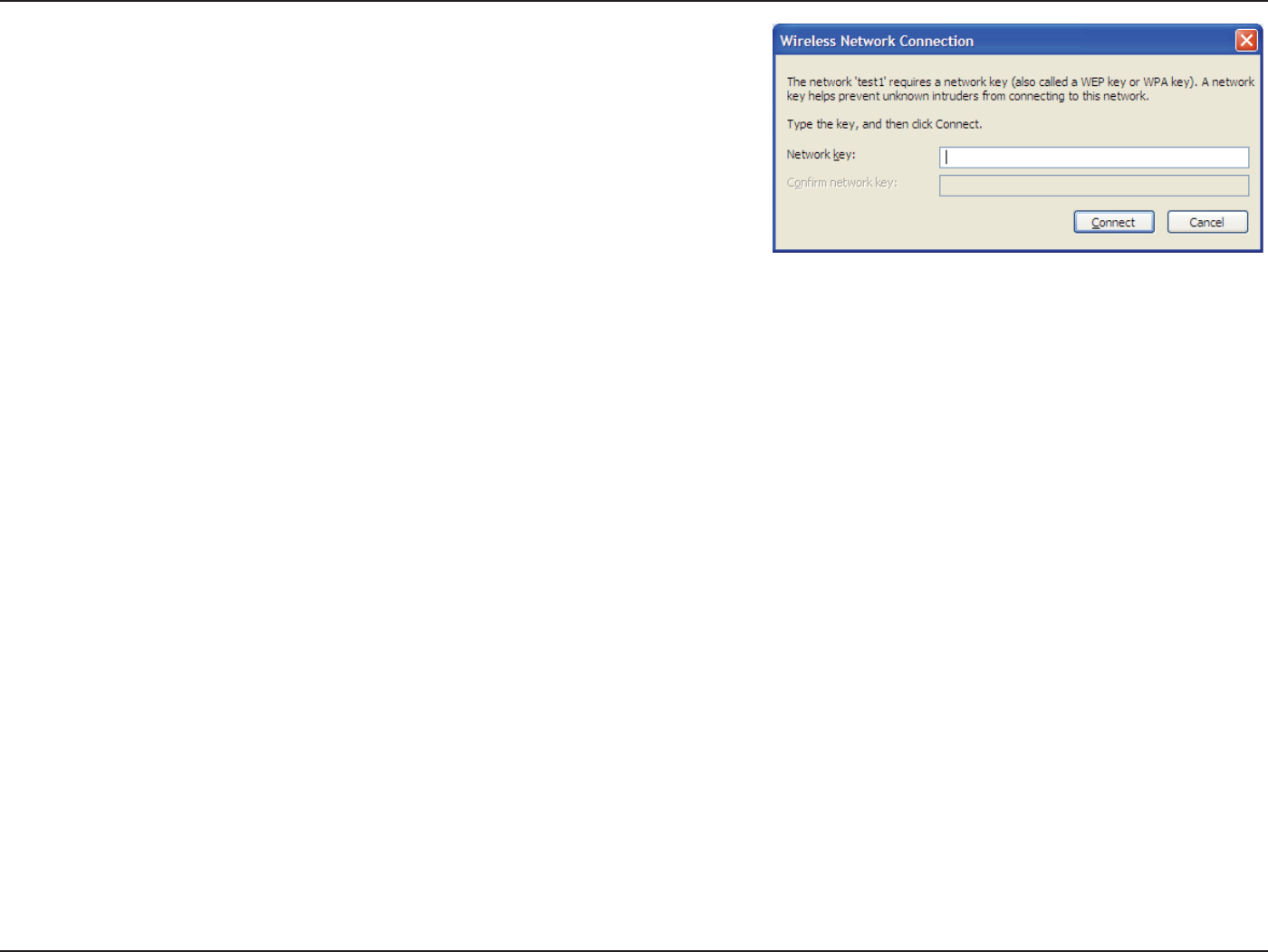
78D-Link DWR-9 User Manual
Section 5 - Connecting to a Wireless Network
3. The Wireless Network Connection box will appear. Enter the WPA-
PSK Wi-Fi password and click Connect.
It may take 20-30 seconds to connect to the wireless network. If the
connection fails, please verify that the WPA-PSK settings are correct. The
Wi-Fi password must be exactly the same as on the wireless router.

79D-Link DWR-9 User Manual
Section 6 - Troubleshooting
Troubleshooting
This chapter provides solutions to problems that can occur during the installation and operation of the DWR-9. Read the
following descriptions if you are having problems. The examples below are illustrated in Windows® XP. If you have a dierent
operating system, the screenshots on your computer will look similar to these examples.
1. Why can’t I access the web-based conguration utility?
When entering the IP address of the D-Link router (192.168.0.1 for example), you are not connecting to a website, nor do you
have to be connected to the Internet. The device has the utility built-in to a ROM chip in the device itself. Your computer must
be on the same IP subnet to connect to the web-based utility.
• Make sure you have an updated Java-enabled web browser. We recommend the following:
- Microsoft Internet Explorer® 7 or higher
- Mozilla Firefox 3.5 or higher
- Google™ Chrome 8 or higher
- Apple Safari 4 or higher
• Verify physical connectivity by checking for solid link lights on the device. If you do not get a solid link light, try using a
dierent cable, or connect to a dierent port on the device if possible. If the computer is turned o, the link light may not
be on.
• Disable any Internet security software running on the computer. Software rewalls such as ZoneAlarm, BlackICE, Sygate,
Norton Personal Firewall, and Windows® XP rewall may block access to the conguration pages. Check the help les included
with your rewall software for more information on disabling or conguring it.

80D-Link DWR-9 User Manual
Section 6 - Troubleshooting
• Congure your Internet settings:
• Go to Start > Settings > Control Panel. Double-click the Internet Options Icon. From the Security tab, click
the button to restore the settings to their defaults.
• Click the Connection tab and set the dial-up option to Never Dial a Connection. Click the LAN Settings button.
Make sure nothing is checked. Click OK.
• Go to the Advanced tab and click the button to restore these settings to their defaults. Click OK three times.
• Close your web browser (if open) and open it.
• Access the web management. Open your web browser and enter the IP address of your D-Link router in the address bar. This
should open the login page for your web management.
• If you still cannot access the conguration, unplug the power to the router for 10 seconds and plug back in. Wait about 30
seconds and try accessing the conguration. If you have multiple computers, try connecting using a dierent computer.
2. What can I do if I forgot my password?
If you forgot your password, you must reset your router. This process will change all your settings back to the factory defaults.
To reset the router, locate the reset button (hole) on the rear panel of the unit. With the router powered on, use a paperclip
to hold the button down for 10 seconds. Release the button and the router will go through its reboot process. Wait about 30
seconds to access the router. The default IP address is 192.168.0.1. When logging in, leave the password box empty.
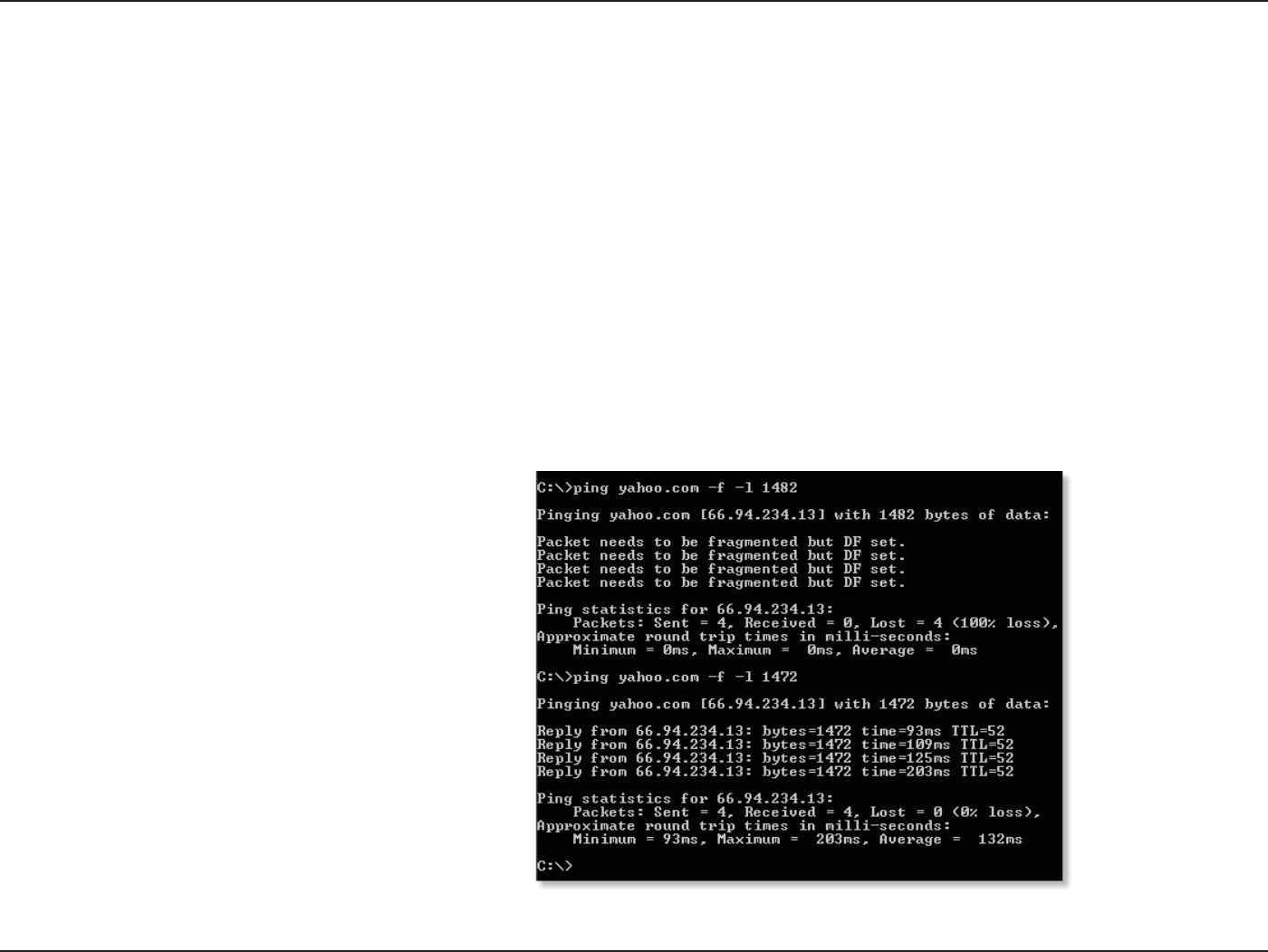
81D-Link DWR-9 User Manual
Section 6 - Troubleshooting
3. Why can’t I connect to certain sites or send and receive emails when connecting through my router?
If you are having a problem sending or receiving email, or connecting to secure sites such as eBay, banking sites, and Hotmail,
we suggest lowering the MTU in increments of ten (Ex. 1492, 1482, 1472, etc).
To nd the proper MTU Size, you’ll have to do a special ping of the destination you’re trying to go to. A destination could be
another computer, or a URL.
• Click on Start and then click Run.
• Windows® 95, 98, and Me users type in command (Windows® NT, 2000, XP, Vista®, and 7 users type in cmd) and
press Enter (or click OK).
• Once the window opens, you’ll need to do a special ping. Use the following syntax:
ping [url] [-f] [-l] [MTU value]
Example: ping yahoo.com -f -l 1472

82D-Link DWR-9 User Manual
Section 6 - Troubleshooting
You should start at 1472 and work your way down by 10 each time. Once you get a reply, go up by 2 until you get a fragmented
packet. Take that value and add 28 to the value to account for the various TCP/IP headers. For example, lets say that 1452 was the
proper value, the actual MTU size would be 1480, which is the optimum for the network we’re working with (1452+28=1480).
Once you nd your MTU, you can now congure your router with the proper MTU size.
To change the MTU rate on your router follow the steps below:
• Navigate to the Internet conguration page (see Internet on page 8 for details).
• To change the MTU, enter the number in the MTU eld and click Apply to save your settings.
• Test your email. If changing the MTU does not resolve the problem, continue changing the MTU in increments
of ten.

83D-Link DWR-9 User Manual
Appendix A - Wireless Basics
D-Link wireless products are based on industry standards to provide easy-to-use and compatible high-speed wireless
connectivity within your home, business, or public access wireless networks. Strictly adhering to the IEEE standard, the D-Link
wireless family of products will allow you to securely access the data you want, when, and where you want it. You will be able
to enjoy the freedom that wireless networking delivers.
A wireless local area network (WLAN) is a cellular computer network that transmits and receives data with radio signals instead
of wires. Wireless LANs are used increasingly in both home and oce environments, and public areas such as airports, coee
shops and universities. Innovative ways to utilize WLAN technology are helping people work, and communicate more eciently.
Increased mobility and the absence of cabling and other xed infrastructure have proven to be benecial for many users.
Wireless users can use the same applications they use on a wired network. Wireless adapter cards used on laptop and desktop
systems support the same protocols as Ethernet adapter cards.
Under many circumstances, it may be desirable for mobile network devices to link to a conventional Ethernet LAN in order to
use servers, printers or an Internet connection supplied through the wired LAN. A wireless router is a device used to provide
this link.
Wireless Basics

84D-Link DWR-9 User Manual
Appendix A - Wireless Basics
What is Wireless?
Wireless or Wi-Fi technology is another way of connecting your computer to the network without using wires. Wi-Fi uses radio
frequency to connect wirelessly so you have the freedom to connect computers anywhere in your home or oce network.
Why D-Link Wireless?
D-Link is the worldwide leader and award winning designer, developer, and manufacturer of networking products. D-Link
delivers the performance you need at a price you can aord. D-Link has all the products you need to build your network.
How does wireless work?
Wireless works similarly to how cordless phones work, through radio signals that transmit data from one point A to point B.
But wireless technology has restrictions as to how you can access the network. You must be within the wireless network range
area to be able to connect your computer. There are two dierent types of wireless networksl: Wireless Local Area Network
(WLAN), and Wireless Personal Area Network (WPAN).
Wireless Local Area Network (WLAN)
In a wireless local area network, a device called an Access Point (AP) connects computers to the network. The access point
has a small antenna attached to it, which allows it to transmit data back and forth over radio signals. With an indoor access
point the signal can travel up to 300 feet. With an outdoor access point the signal can reach out up to 30 miles to serve places
like manufacturing plants, industrial locations, university and high school campuses, airports, golf courses, and many other
outdoor venues.

85D-Link DWR-9User Manual
Appendix A - Wireless Basics
Wireless Personal Area Network (WPAN)
Bluetooth is the industry standard wireless technology used for WPAN. Bluetooth devices in WPAN operate in a range up to
30 feet away.
Compared to WLAN the speed and wireless operation range are both less than WLAN, but in return it doesn’t use nearly as
much power. This makes it ideal for personal devices, such as mobile phones, PDAs, headphones, laptops, speakers, and other
devices that operate on batteries.
Who uses wireless?
Wireless technology as become so popular in recent years that almost everyone is using it, whether it’s for home, oce, business,
D-Link has a wireless solution for it.
Home Uses/Benets
• Gives everyone at home broadband access
• Surf the web, check email, instant message, etc.
• Gets rid of the cables around the house
• Simple and easy to use
Small Oce and Home Oce Uses/Benets
• Stay on top of everything at home as you would at oce
• Remotely access your oce network from home
• Share Internet connection and printer with multiple computers
• No need to dedicate oce space

86D-Link DWR-9 User Manual
Appendix A - Wireless Basics
Where is wireless used?
Wireless technology is expanding everywhere, not just at home or oce. People like the freedom of mobility and it’s becoming
so popular that more and more public facilities now provide wireless access to attract people. The wireless connection in public
places is usually called “hotspots”.
Using a D-Link CardBus Adapter with your laptop, you can access the hotspot to connect to the Internet from remote locations
like: airports, hotels, coee shops, libraries restaurants, and convention centers.
Wireless network is easy to setup, but if you’re installing it for the rst time it could be quite a task not knowing where to start.
That’s why we’ve put together a few setup steps and tips to help you through the process of setting up a wireless network.
Tips
Here are a few things to keep in mind, when you install a wireless network.
Centralize your router or access point
Make sure you place the router/access point in a centralized location within your network for the best performance. Try to
place the router/access point as high as possible in the room, so the signal gets dispersed throughout your home. If you have
a two-story home, you may need a repeater to boost the signal to extend the range.
Eliminate interference
Place home appliances such as cordless telephones, microwaves, and televisions as far away as possible from the router/access
point. This would signicantly reduce any interference that the appliances might cause since they operate on same frequency.

87D-Link DWR-9 User Manual
Appendix A - Wireless Basics
Security
Don’t let your next-door neighbors or intruders connect to your wireless network. Secure your wireless network by turning on
the WPA or WEP security feature on the router. Refer to the product manual for detail information on how to set it up.
There are basically two modes of networking:
• Infrastructure – All wireless clients will connect to an access point or wireless router.
• Ad hoc – Directly connecting to another computer for peer-to-peer communication using wireless network
adapters on each computer, such as two or more DWR-9 wireless network CardBus adapters.
An Infrastructure network contains an access point or wireless router. All the wireless devices, or clients, will connect to the
wireless router or access point.
An ad hoc network contains only clients, such as laptops with wireless CardBus adapters. All the adapters must be in ad hoc
mode to communicate.
Wireless Modes
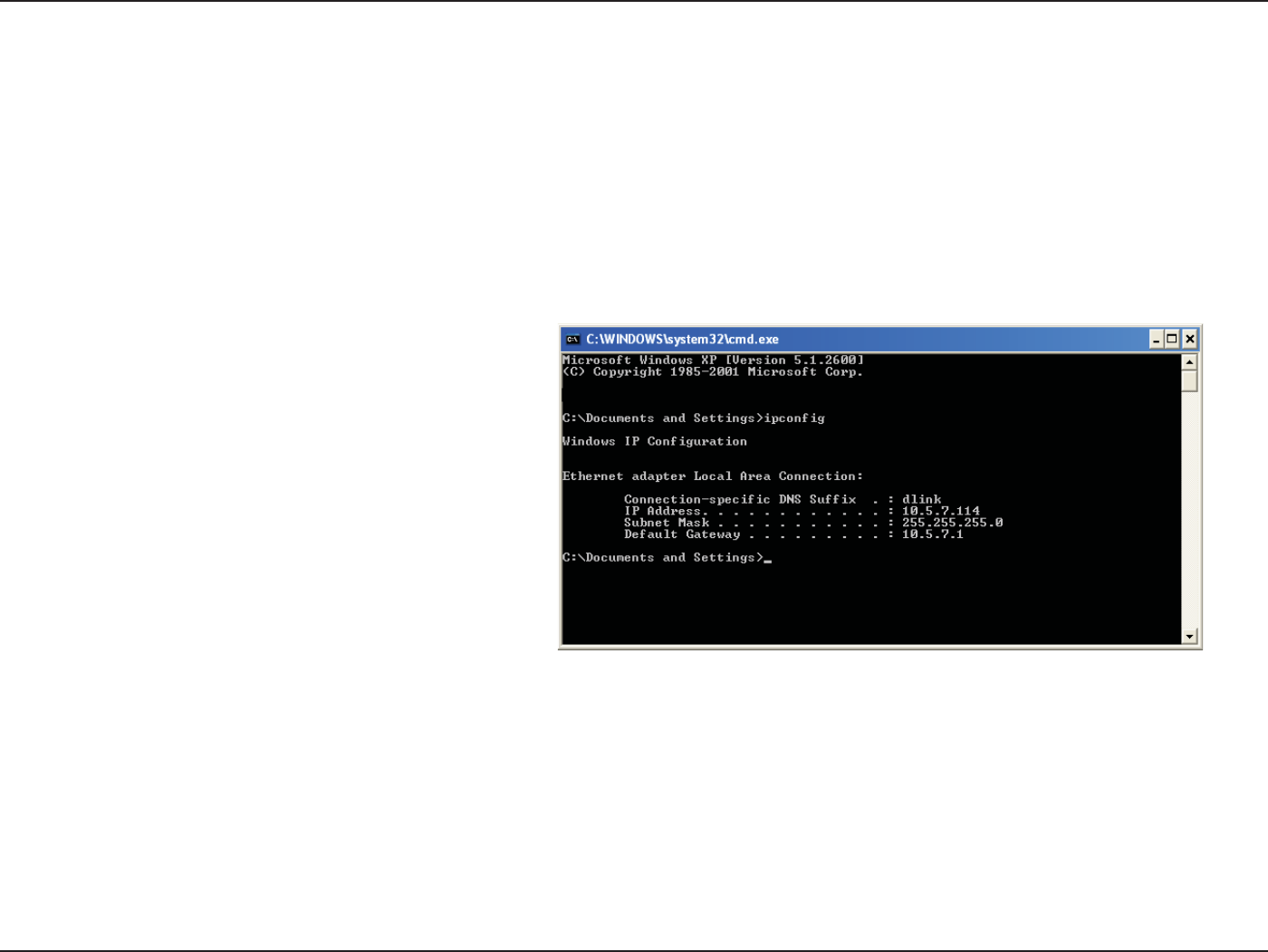
88D-Link DWR-9 User Manual
Appendix B - Networking Basics
Networking Basics
Check your IP address
After you install your new D-Link adapter, by default, the TCP/IP settings should be set to obtain an IP address from a DHCP
server (i.e. wireless router) automatically. To verify your IP address, please follow the steps below.
Click on Start > Run. In the run box type cmd and click OK. (Windows® 7/Vista® users type cmd in the Start Search box.)
At the prompt, type ipcong and press Enter.
This will display the IP address, subnet mask, and the
default gateway of your adapter.
If the address is 0.0.0.0, check your adapter installation,
security settings, and the settings on your router.
Some rewall software programs may block a DHCP
request on newly installed adapters.

89D-Link DWR-9 User Manual
Appendix B - Networking Basics
Statically Assign an IP address
If you are not using a DHCP capable gateway/router, or you need to assign a static IP address, please follow the steps below:
Step 1
Windows® 7 - Click on Start > Control Panel > Network and Internet > Network and Sharing Center.
Windows Vista® - Click on Start > Control Panel > Network and Internet > Network and Sharing Center > Manage Network
Connections.
Windows® XP - Click on Start > Control Panel > Network Connections.
Windows® 2000 - From the desktop, right-click My Network Places > Properties.
Step 2
Right-click on the Local Area Connection which represents your network adapter and select Properties.
Step 3
Highlight Internet Protocol Version 4 (TCP/IPv4) and click Properties.
Step 4
Click Use the following IP address and enter an IP address that is on the same subnet as
your network or the LAN IP address on your router.
Example: If the router´s LAN IP address is 192.168.0.1, make your IP address 192.168.1.X
where X is a number between 2 and 99. Make sure that the number you choose is not in
use on the network. Set the Default Gateway the same as the LAN IP address of your router
(I.E. 192.168.0.1).
Set Primary DNS the same as the LAN IP address of your router (192.168.0.1). The Alternate
DNS is not needed or you may enter a DNS server from your ISP.
Step 5
Click OK twice to save your settings.

90D-Link DWR-9 User Manual
Appendix B - Networking Basics
Wireless Security
This section will show you the dierent levels of security you can use to protect your data from intruders. The DWR-9 oers the
following types of security:
• WPA2 (Wi-Fi Protected Access 2) • WPA2-PSK (Pre-Shared Key)
• WPA (Wi-Fi Protected Access) • WPA-PSK (Pre-Shared Key)
What is WPA?
WPA (Wi-Fi Protected Access), is a Wi-Fi standard that was designed to improve the security features of WEP (Wired Equivalent Privacy).
The 2 major improvements over WEP:
• Improved data encryption through the Temporal Key Integrity Protocol (TKIP). TKIP scrambles the keys using a hashing
algorithm and by adding an integrity-checking feature, ensures that the keys haven’t been tampered with. WPA2 is based
on 802.11i and uses Advanced Encryption Standard (AES) instead of TKIP.
• User authentication, which is generally missing in WEP, through the extensible authentication protocol (EAP). WEP
regulates access to a wireless network based on a computer’s hardware-specic MAC address, which is relatively simple
to be snied out and stolen. EAP is built on a more secure public-key encryption system to ensure that only authorized
network users can access the network.
WPA-PSK/WPA2-PSK uses a passphrase or key to authenticate your wireless connection. The key is an alpha-numeric password between
8 and 63 characters long. The password can include symbols (!?*&_) and spaces. This key must be the exact same key entered on your
wireless router or access point.
WPA/WPA2 incorporates user authentication through the Extensible Authentication Protocol (EAP). EAP is built on a more secure public
key encryption system to ensure that only authorized network users can access the network.

91D-Link DWR-9User Manual
Appendix C - Technical Specications
Technical Specications
LTE Band1
• Category : Band 2/4/5/1
Data Rates2
• Up to Mbps with 802.11BD clients
• 6 / 9 / 11 / 12 / 18 / 24 / 36 / 48 / 54 Mbps in 802.11g mode
• 1 / 2 / 5.5 / 11 Mbps in 802.11b mode
• LTE Uplink: Up to 50 Mbps
• LTE Downlink: Up to 100 Mbps
Standards
• IEEE 802.11b/g, compatible with IEEE 802.11nBD devices
• IEEE 802.3i
• IEEE 802.3u
Wireless Security
• 64 / 128-bit WEP (Wired Equivalent Privacy)
• WPA & WPA2 (Wi-Fi Protected Access)
Firewall
• Network Address Translation (NAT)
• Stateful Packet Inspection (SPI)
VPN
• L2TP/PPTP/IPSEC/VPN Pass-through
Antenna
• Two detachable 4G antennas
Ports
• Four LAN ports (RJ-45)
• WAN port (RJ-45)
SIM/UICC Slot
• Standard Mini-SIM/UICC slot
LED Status Indicators
• Power
• *OUFSOFU
• ()[
• 2G)[
• 4G
• -"/8"/Signal Strength
Dimensions
• 10 x x mm
Operating Temperature
• 0 to 40 ˚C (32 to 104 ˚F)
Operating Humidity
• 10% to 90% (Non-condensing)
Certications
• FCC
• RoHS
1 Supported frequency band is dependent upon regional hardware version.
2 Maximum wireless signal rate derived from IEEE Standard 802.11g/b/nBD specications. Actual data throughput will vary. Network conditions and environmental factors, including volume of network trac, building
materials and construction, and network overhead, lower actual data throughput rate. Environmental factors will adversely aect wireless signal range.

92D-Link DWR-9 User Manual
Appendix D - Regulatory Information
Regulatory Information
Federal Communication Commission Interference Statement
This equipment has been tested and found to comply with the limits for a Class B digital device, pursuant to Part 15 of the FCC Rules. These limits
are designed to provide reasonable protection against harmful interference in a residential installation. This equipment generates, uses and
can radiate radio frequency energy and, if not installed and used in accordance with the instructions, may cause harmful interference to radio
communications. However, there is no guarantee that interference will not occur in a particular installation. If this equipment does cause harmful
interference to radio or television reception, which can be determined by turning the equipment o and on, the user is encouraged to try to
correct the interference by one of the following measures:
- Reorient or relocate the receiving antenna.
- Increase the separation between the equipment and receiver.
- Connect the equipment into an outlet on a circuit dierent from that to which the receiver is connected.
- Consult the dealer or an experienced radio/TV technician for help.
Non-modications Statement:
Any changes or modications not expressly approved by the party responsible for compliance could void the user’s authority to operate this
equipment.
Caution:
This device complies with Part 15 of the FCC Rules. Operation is subject to the following two conditions:
(1) This device may not cause harmful interference, and (2) this device must accept any interference received, including interference that
may cause undesired operation.
For product available in the USA/Canada market, only channel 1~11 can be operated. Selection
of other channels is not possible.
Note
The country code selection is for non-USA models only and is not available to all USA models. Per FCC regulations, all WiFi product marketed in
the USA must be xed to USA operational channels only.

93D-Link DWR-9 User Manual
Appendix D - Regulatory Information
IMPORTANT NOTICE:
FCC Radiation Exposure Statement
This equipment complies with FCC radiation exposure limits set forth for an uncontrolled environment. This equipment should be installed and
operated with minimum distance 20 cm between the radiator and your body.